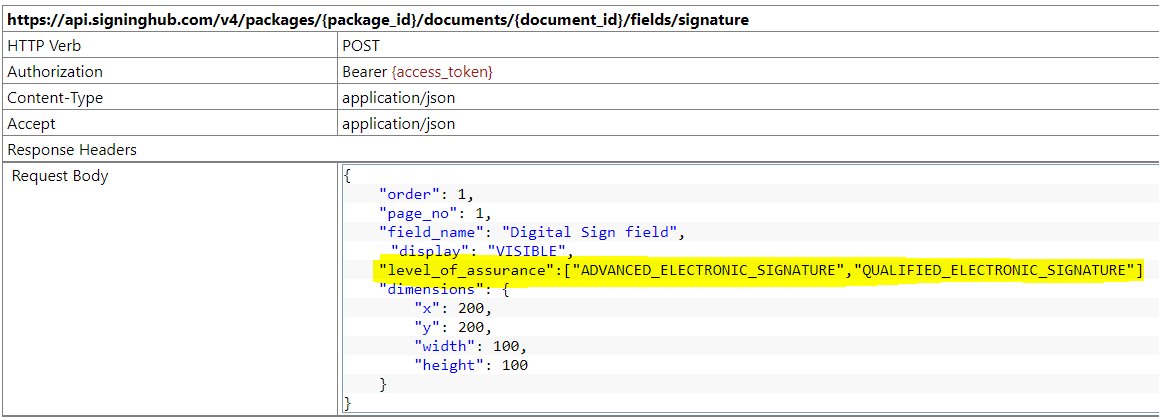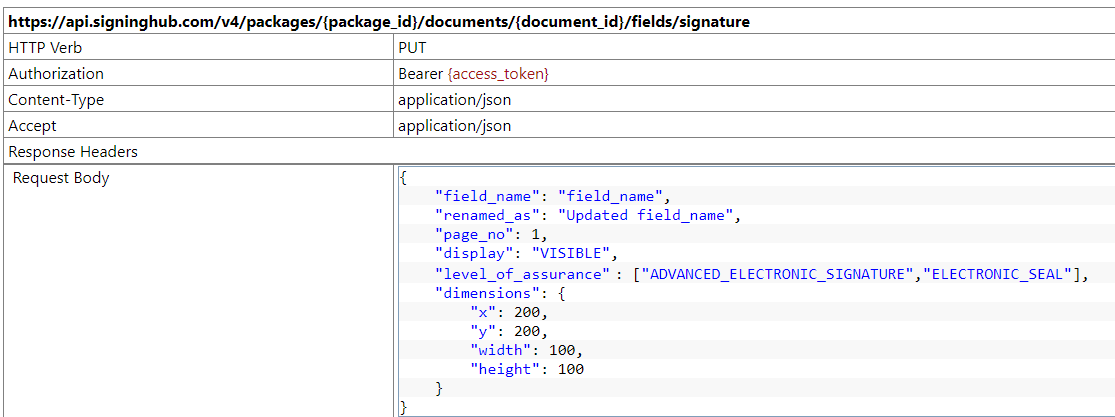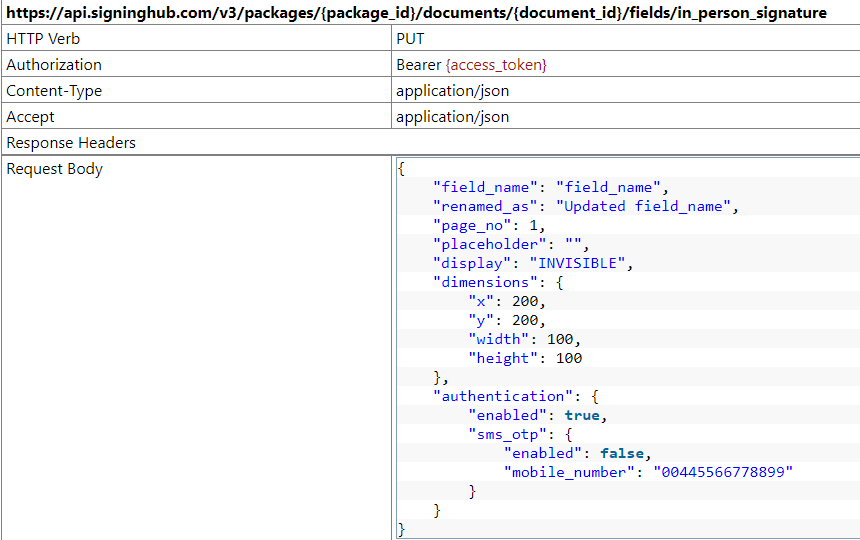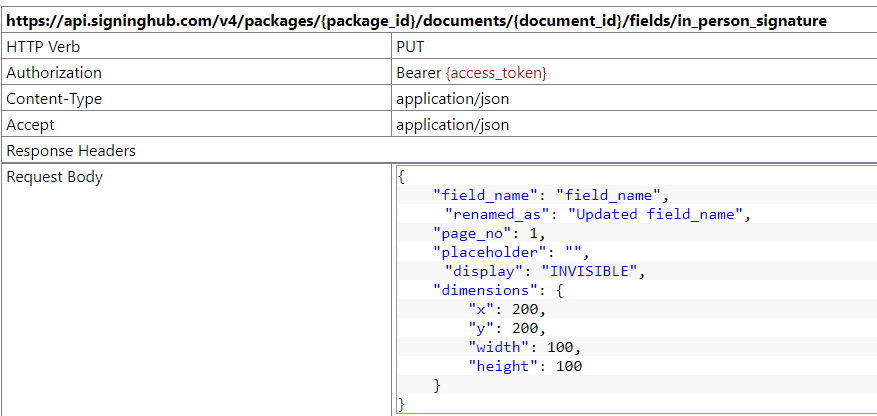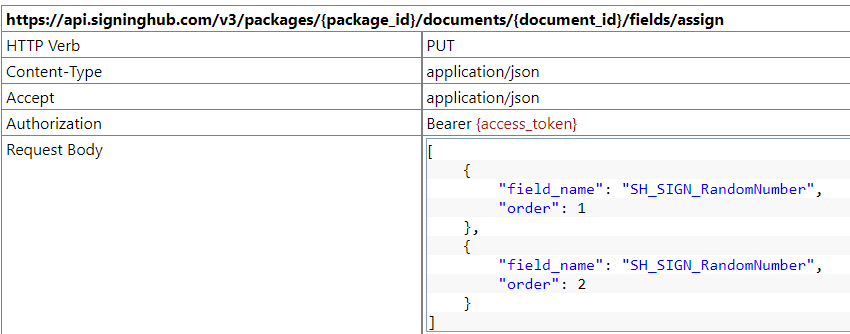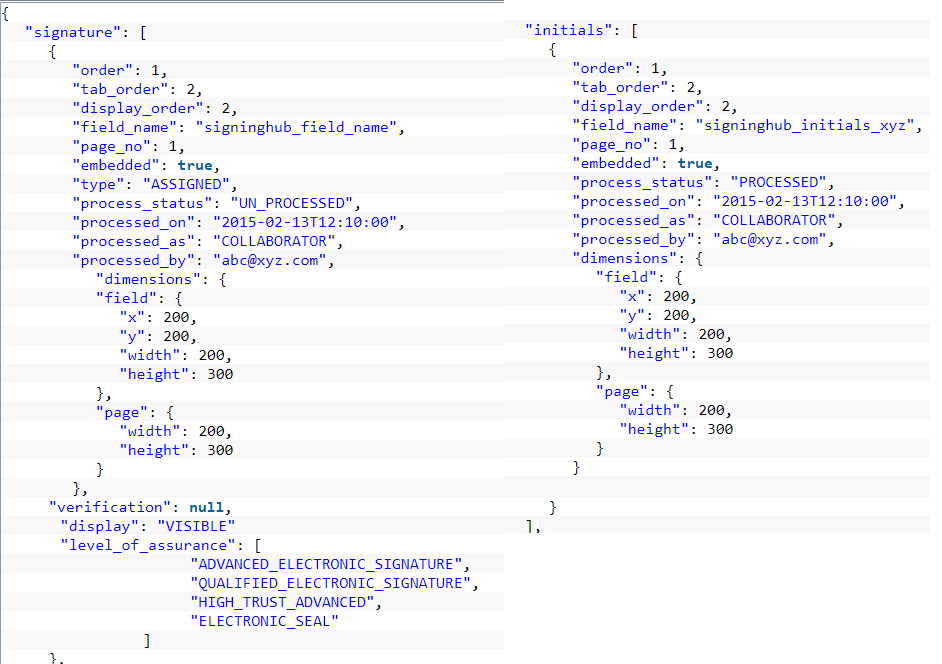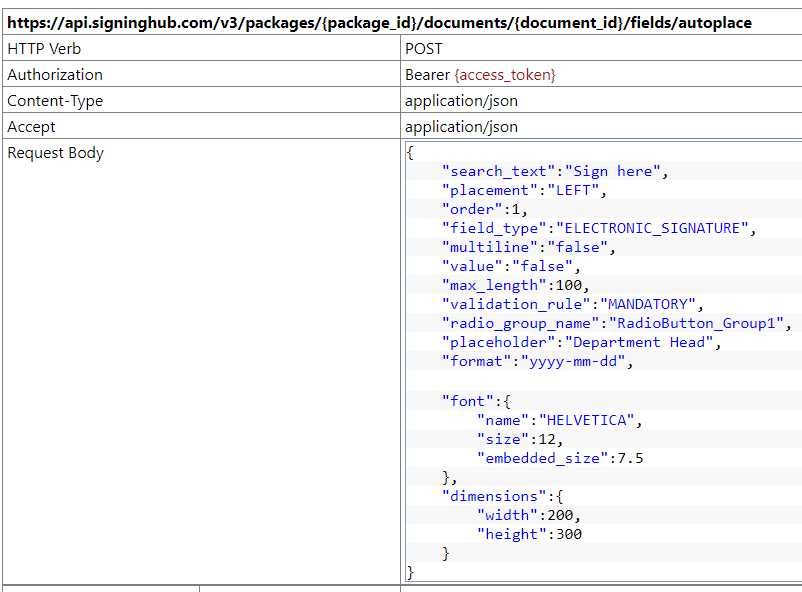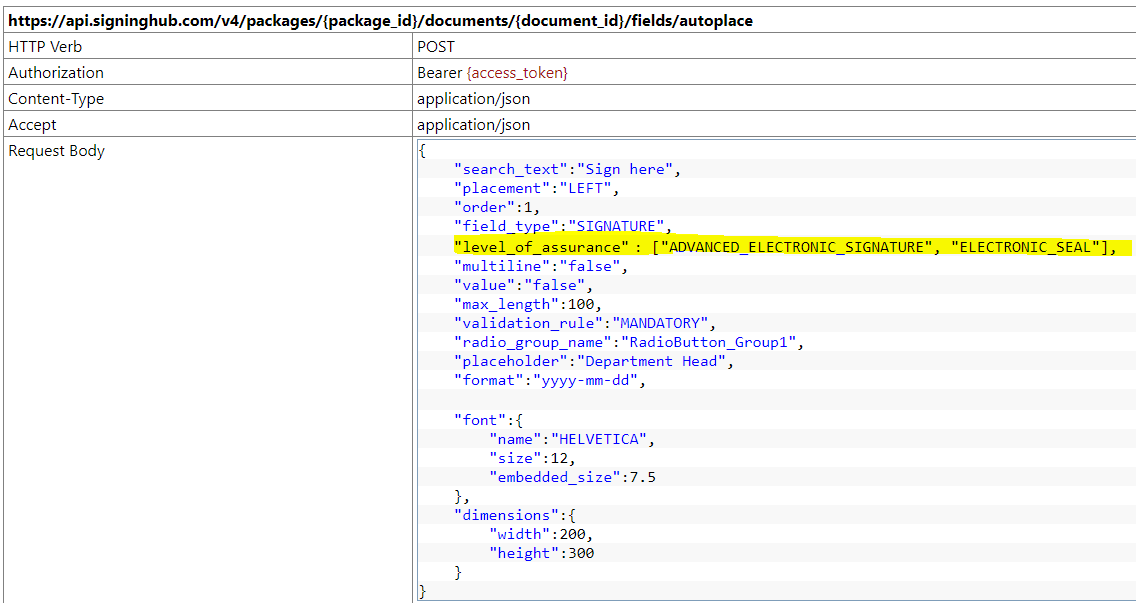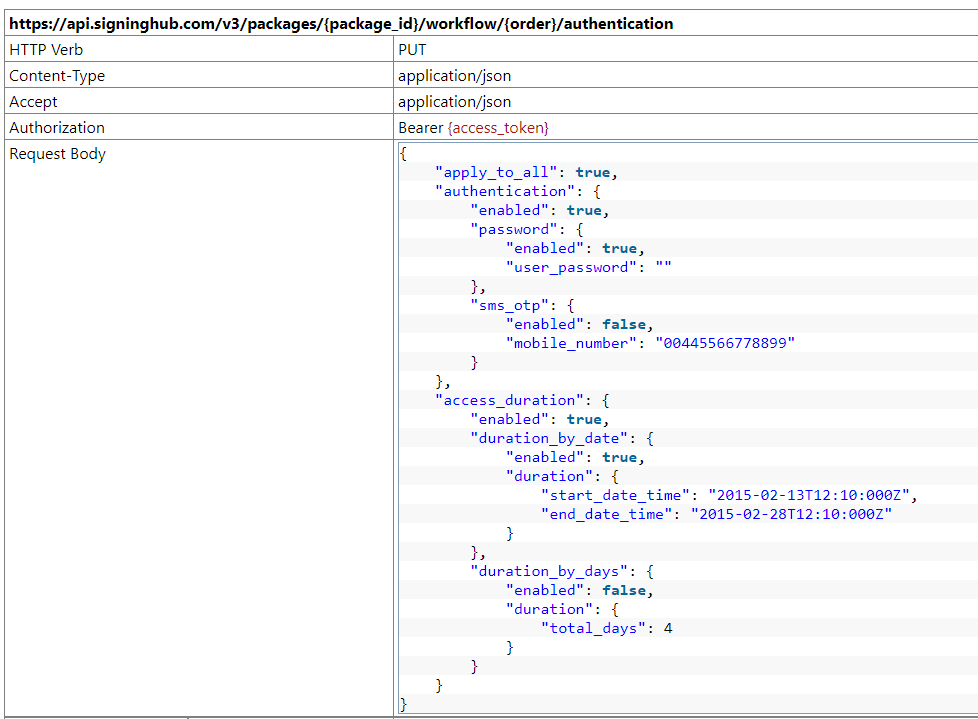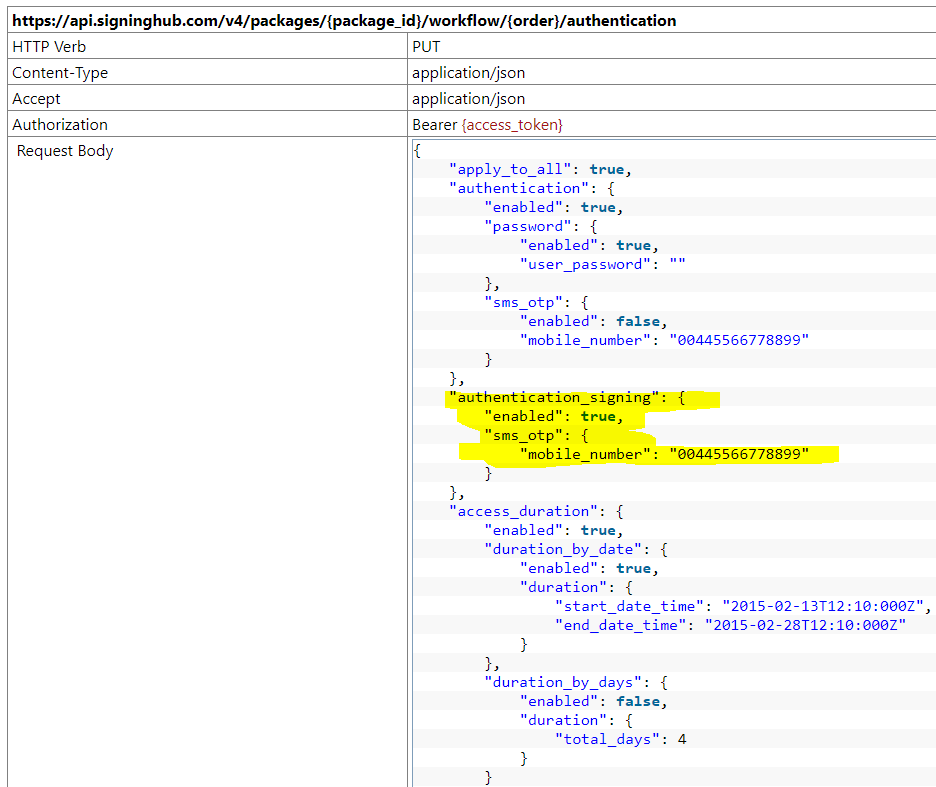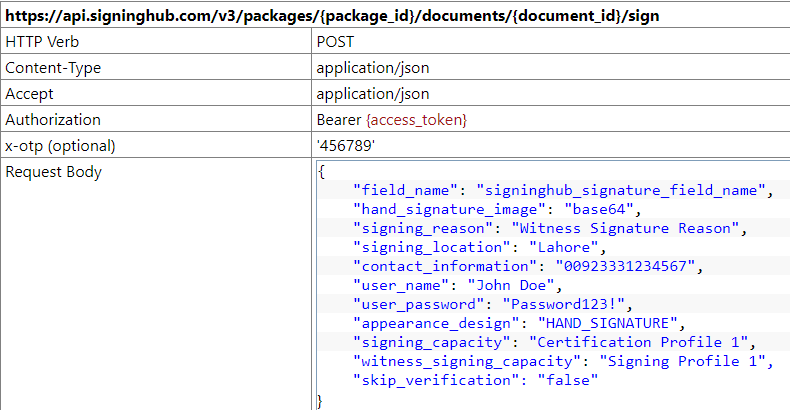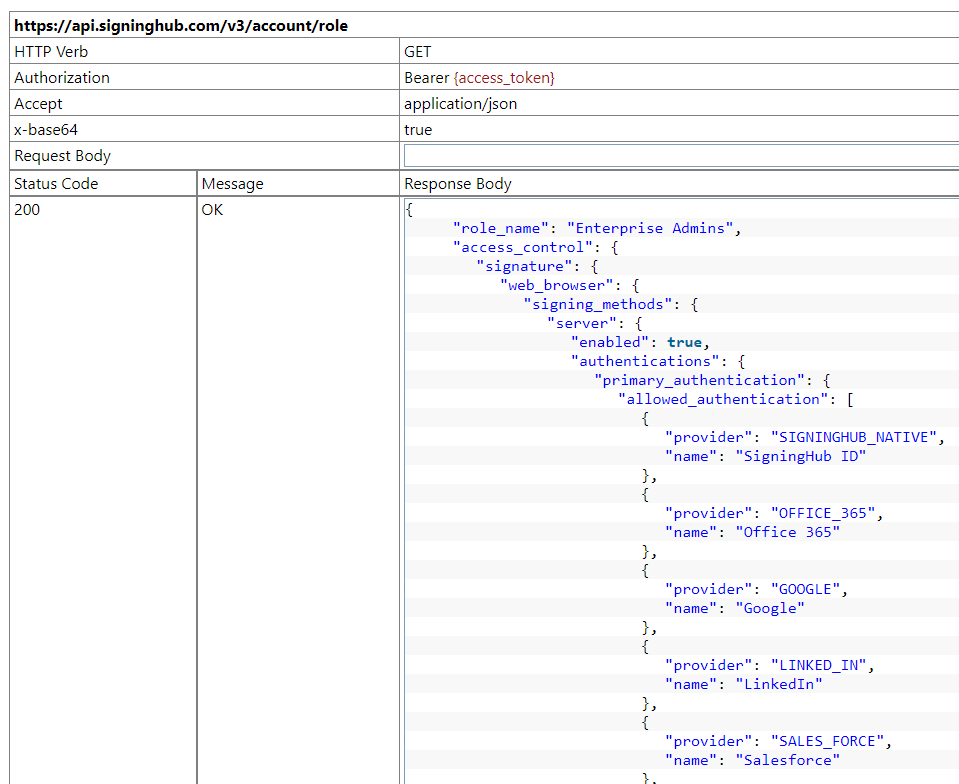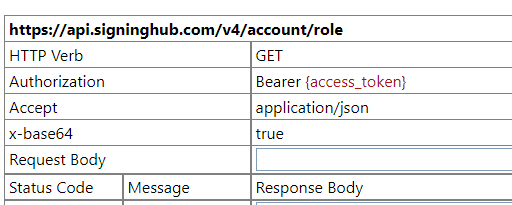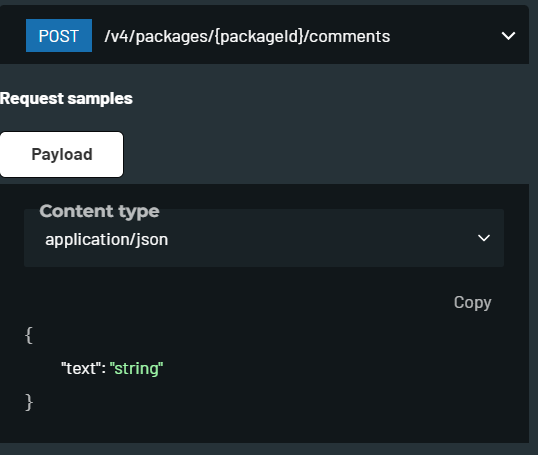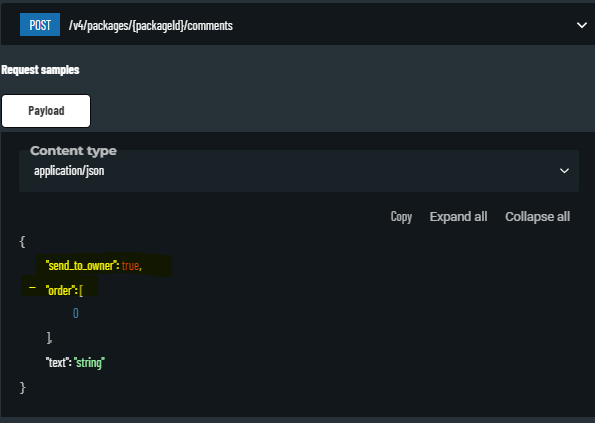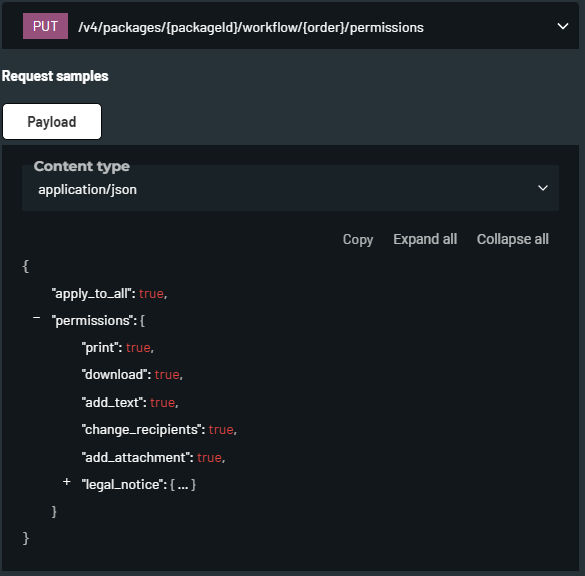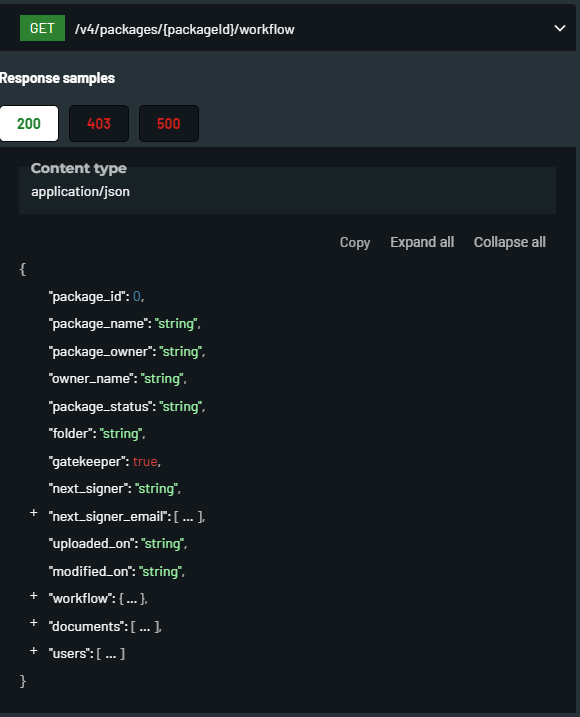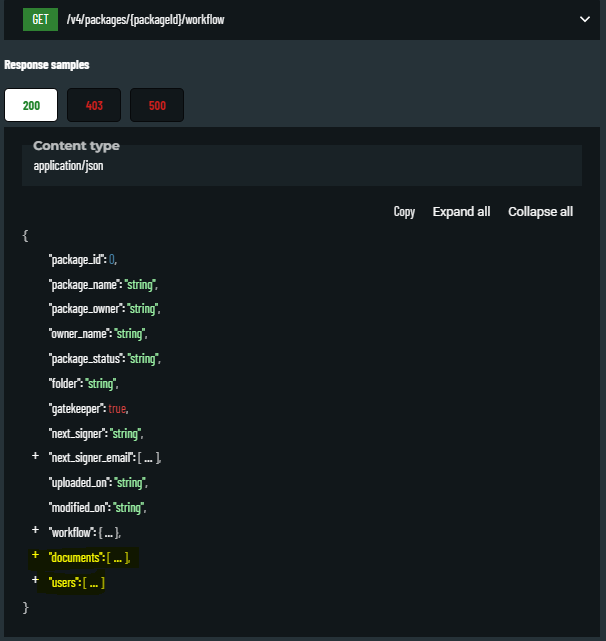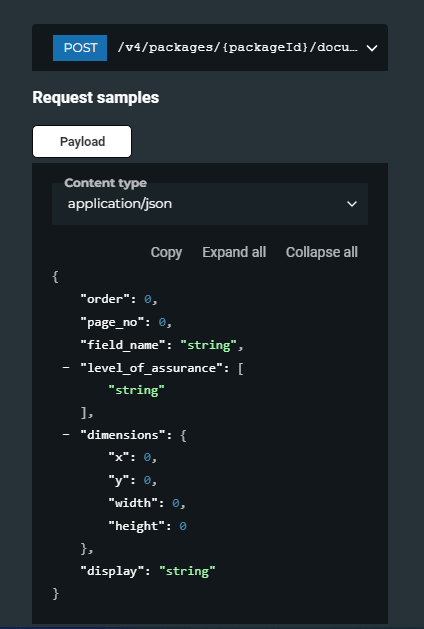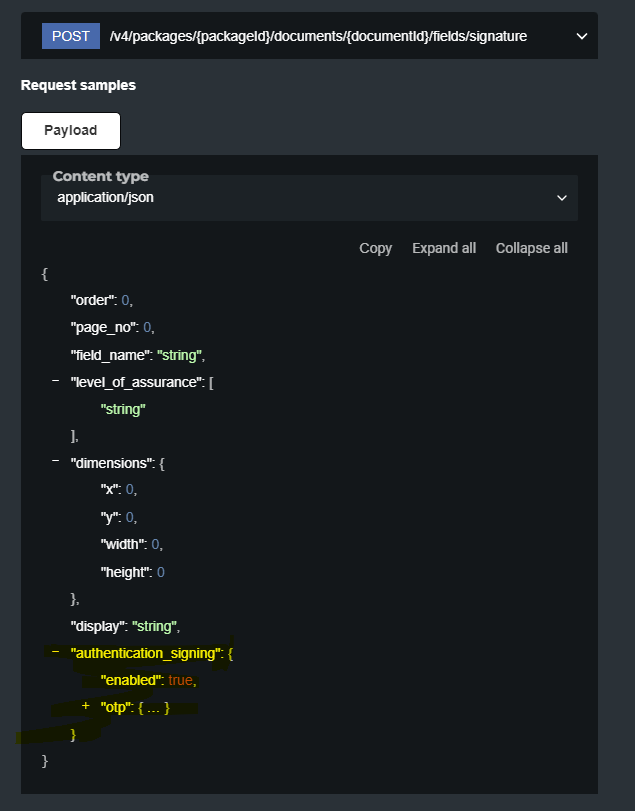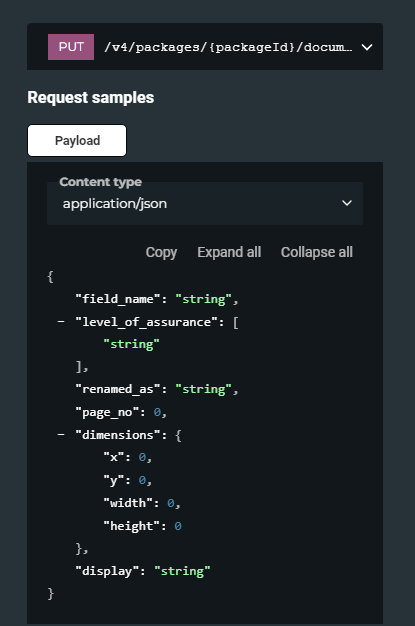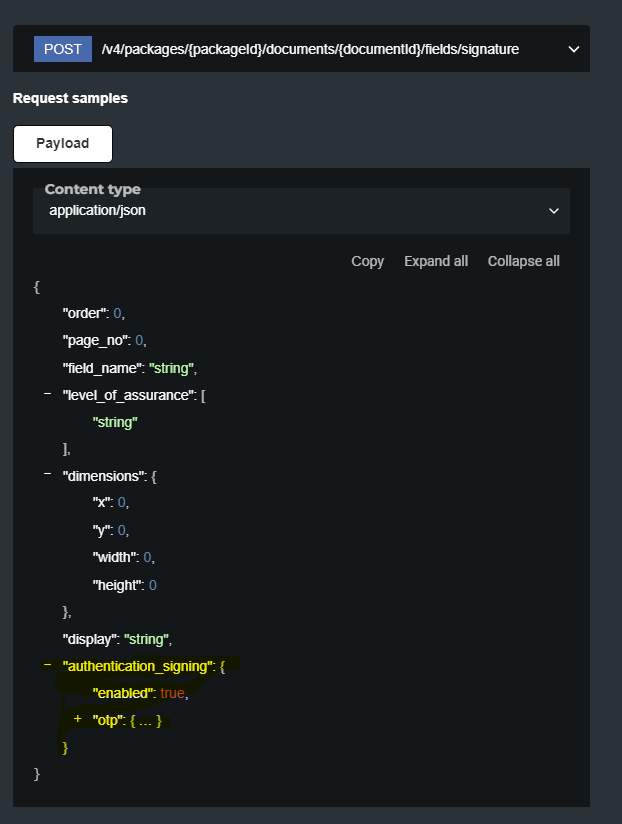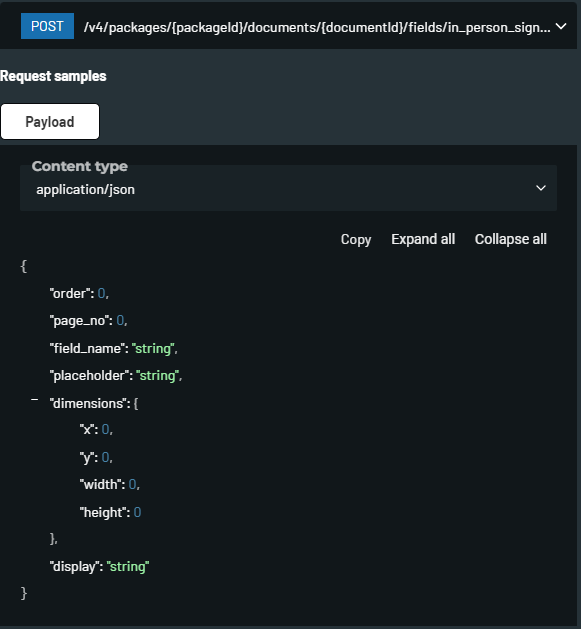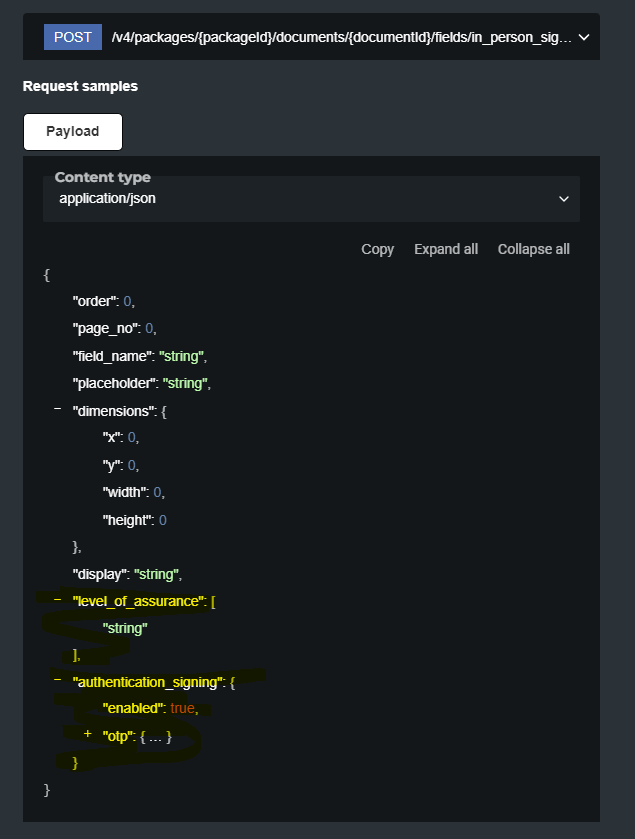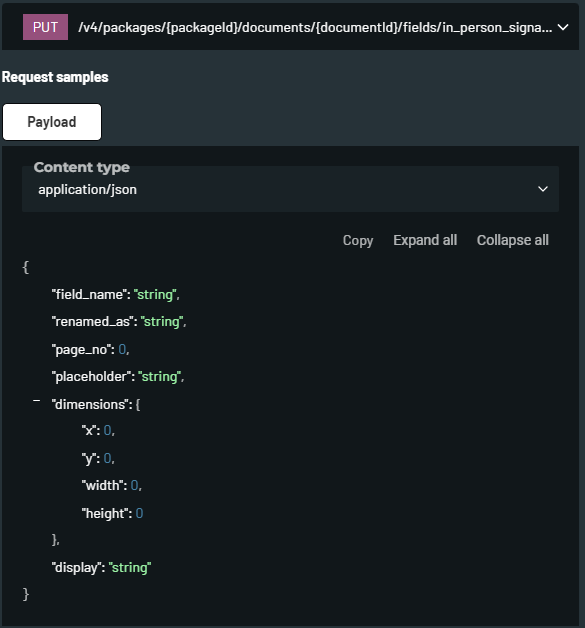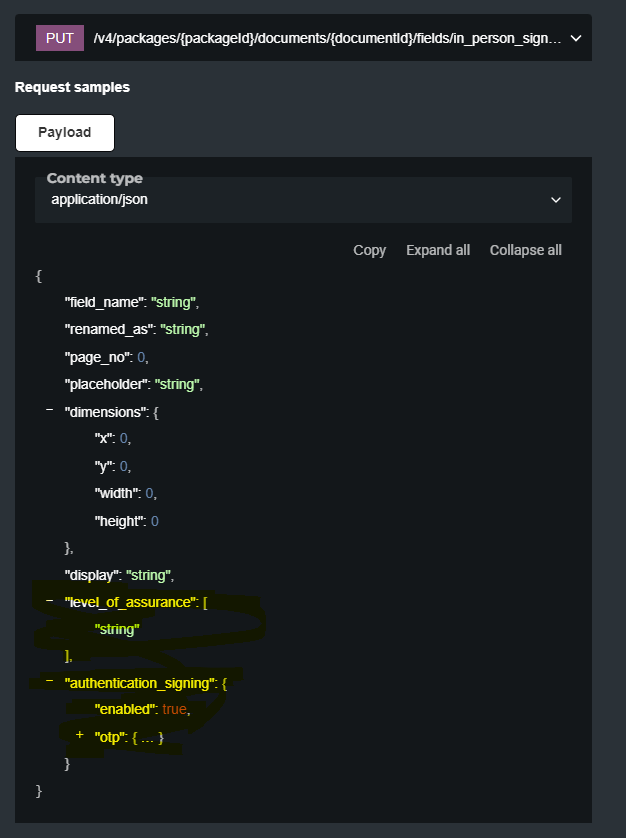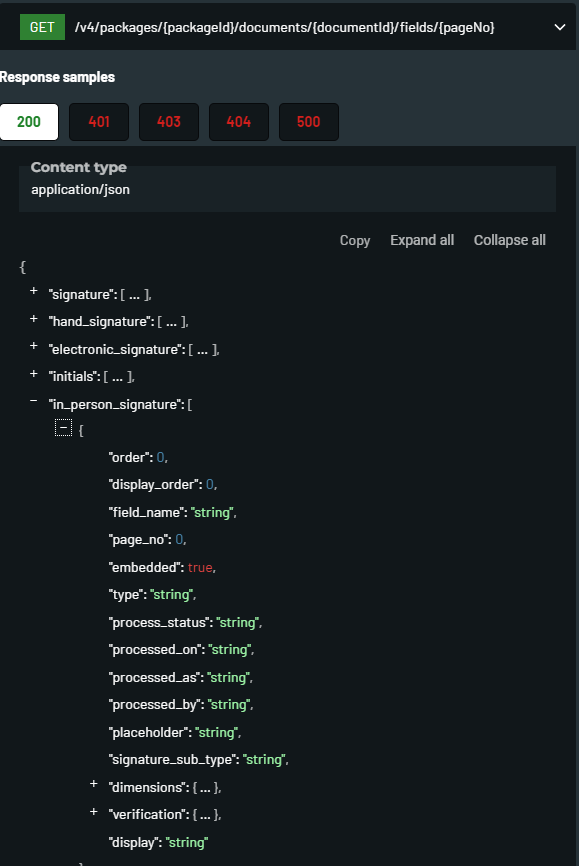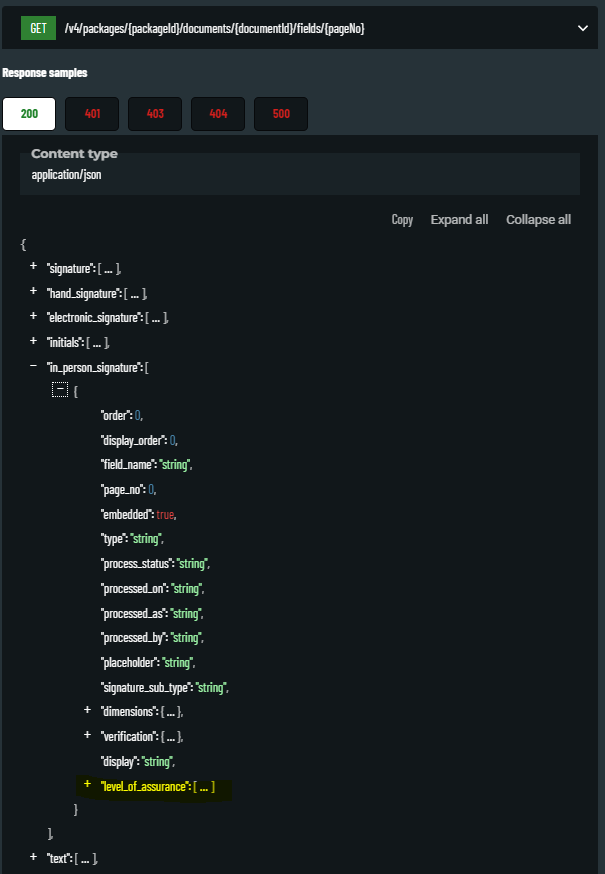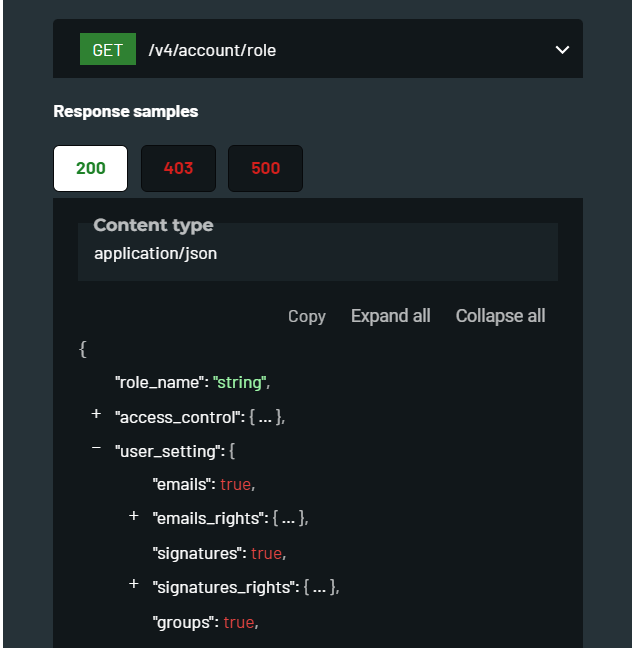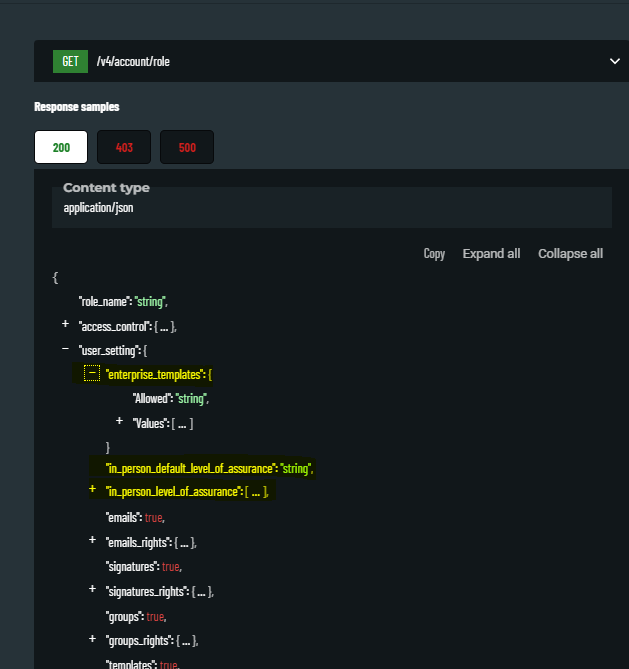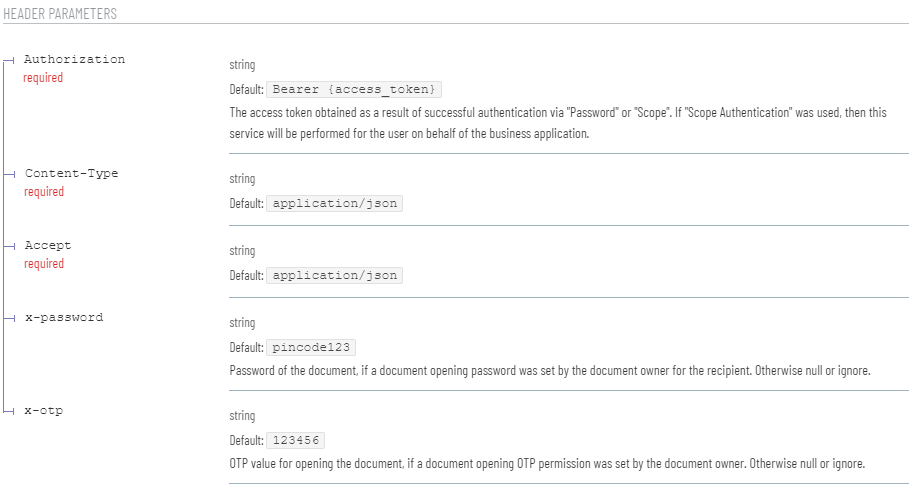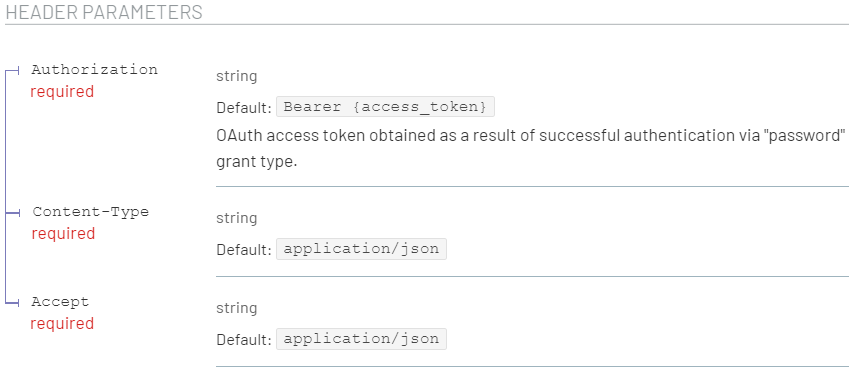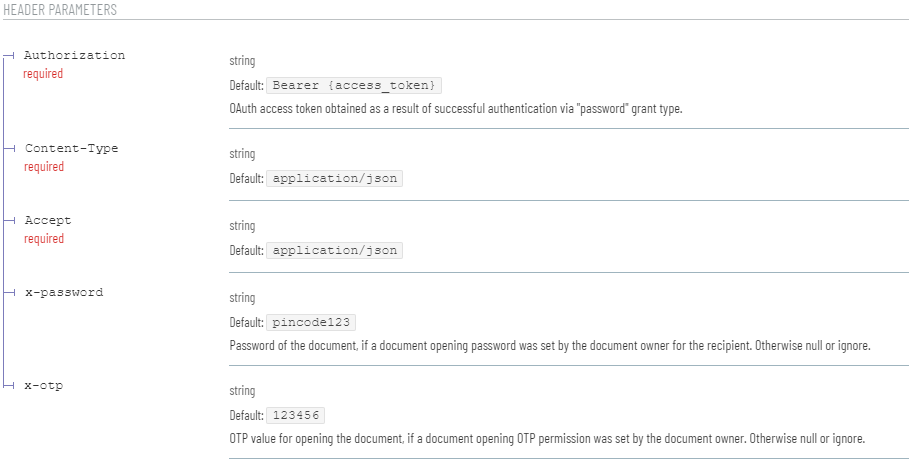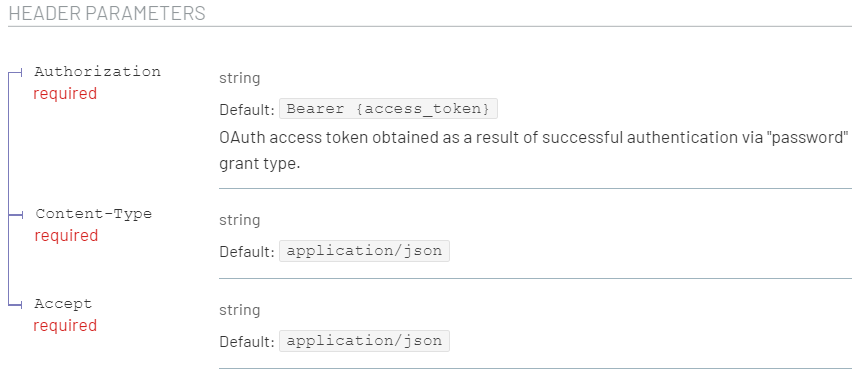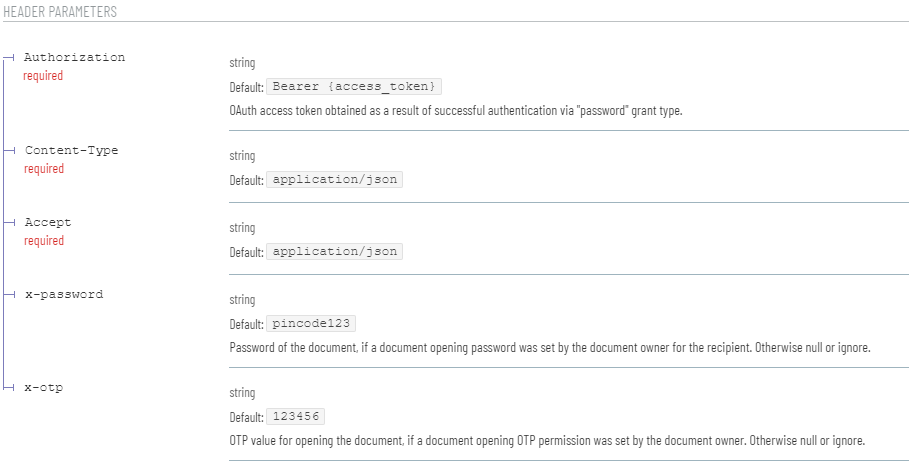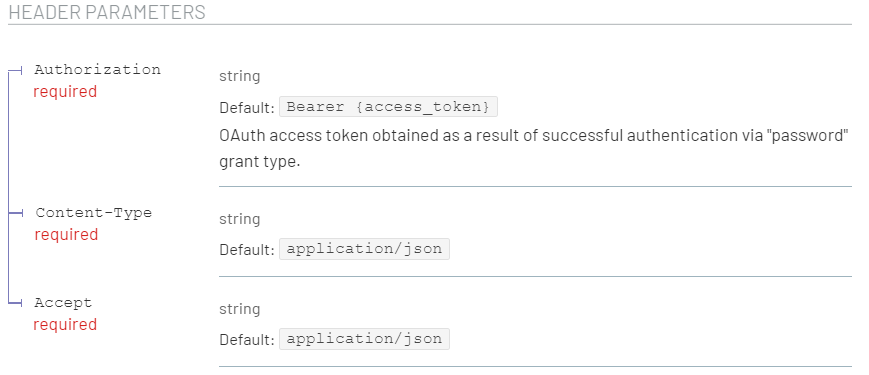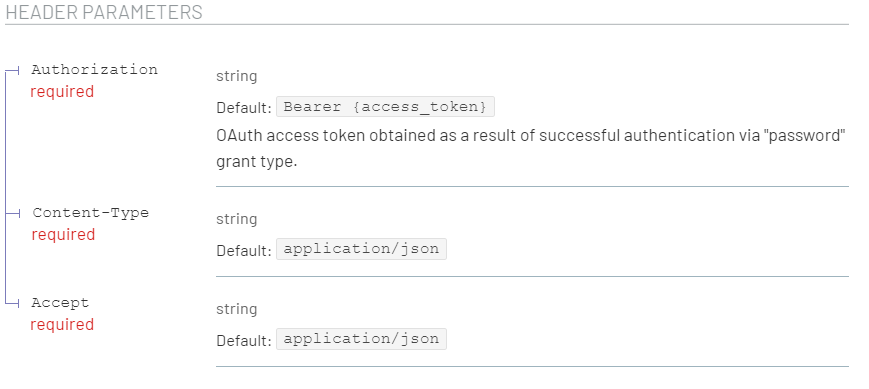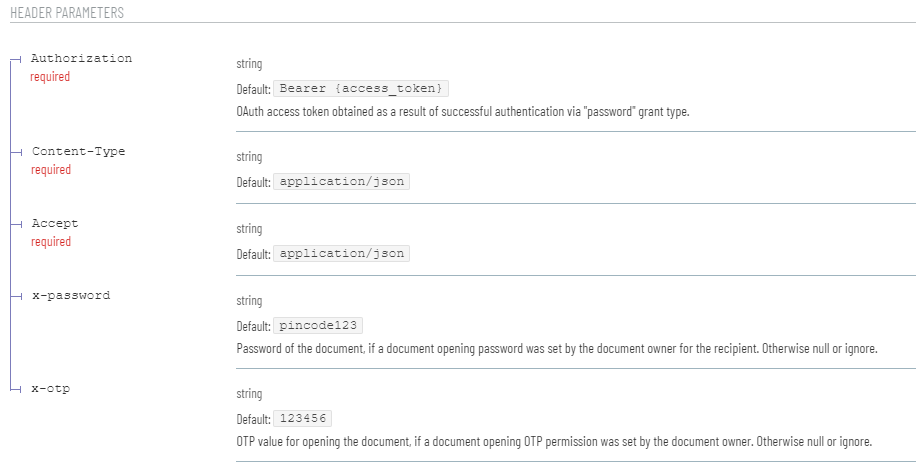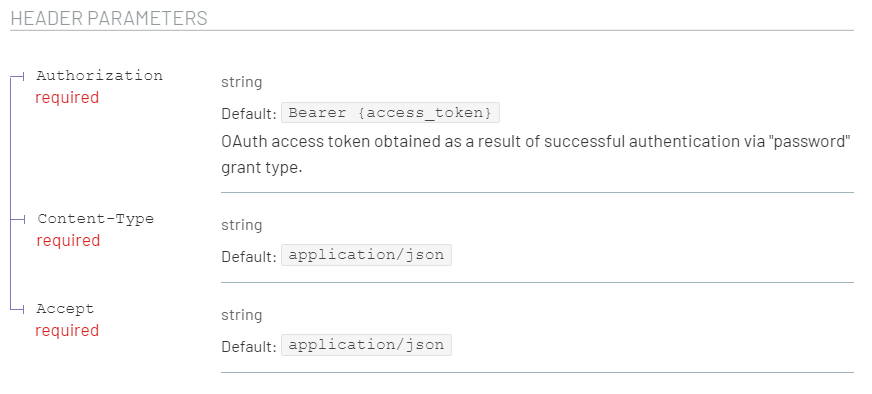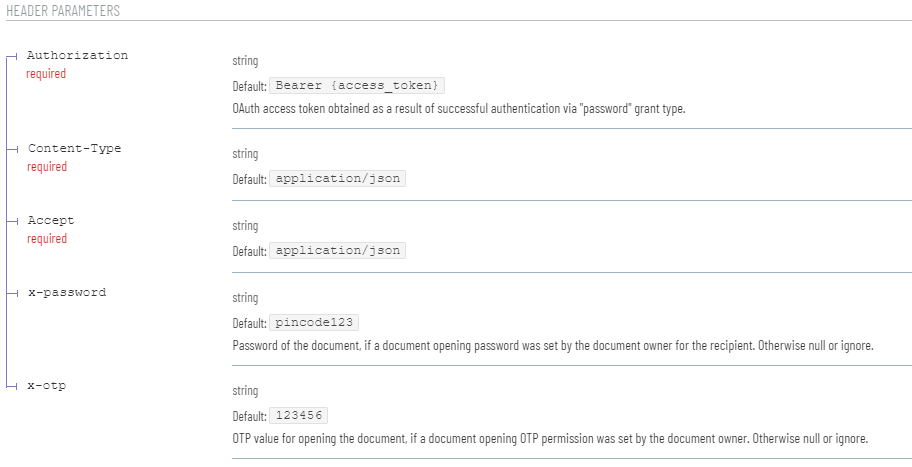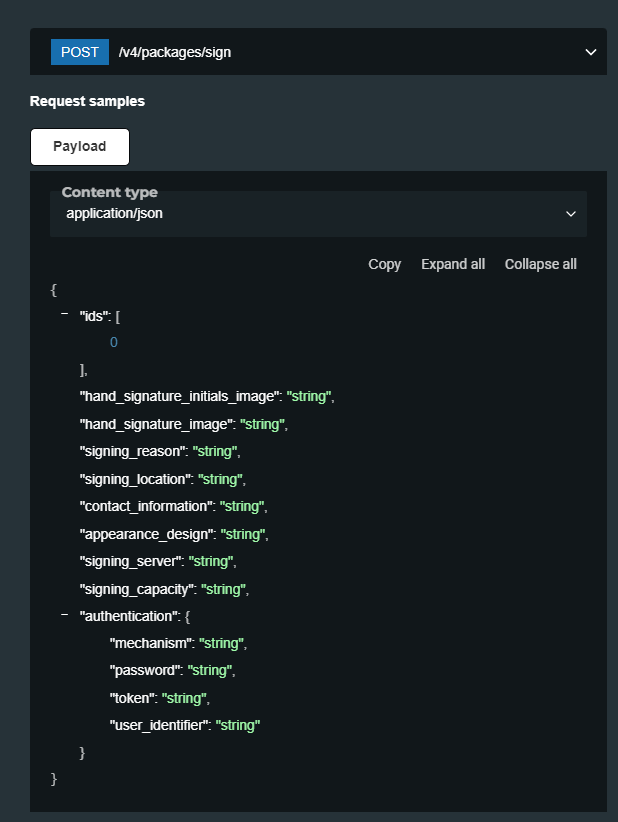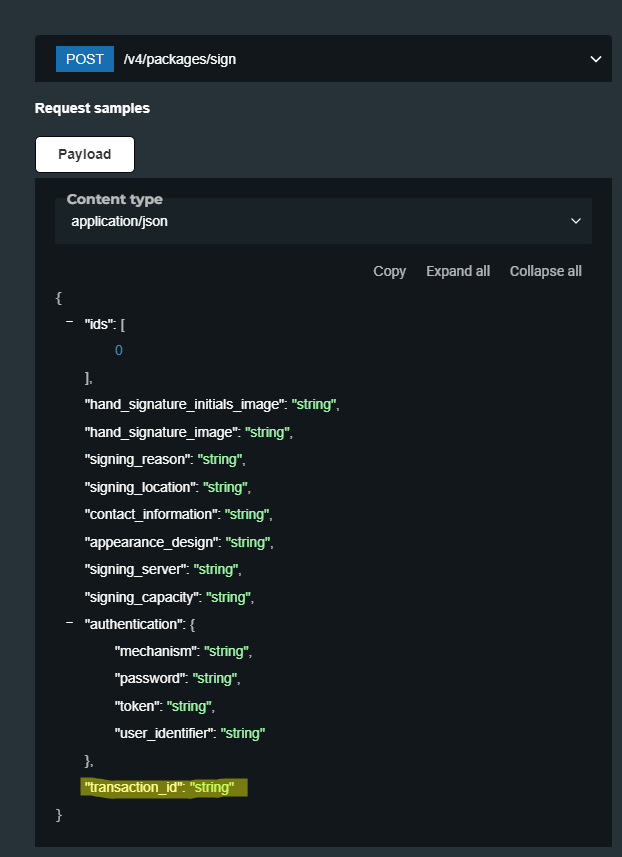SigningHub API Guide
Download OpenAPI specification:Download
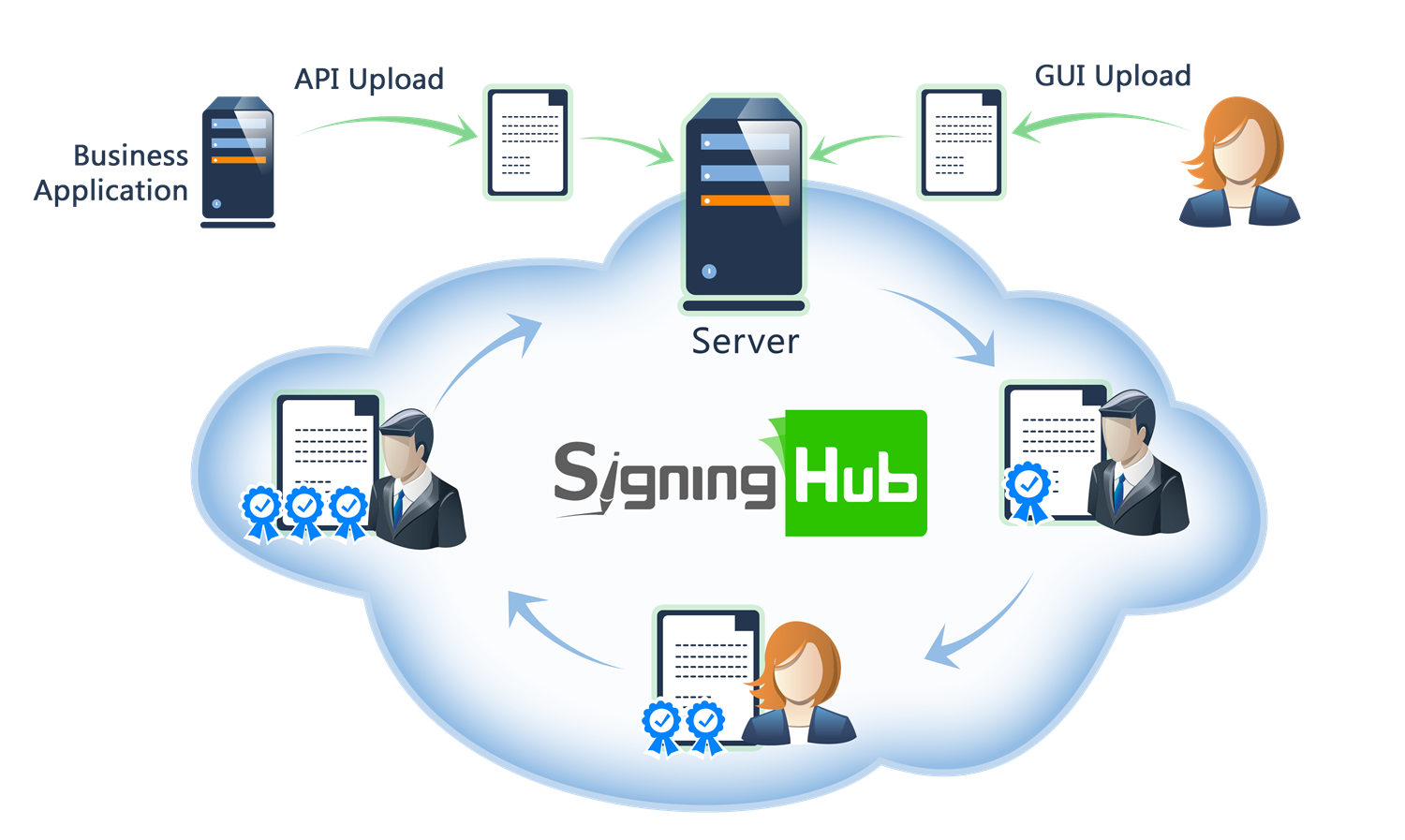
Browse through the API content by selecting the relevant pages from the left panel. To quickly find specific web service information, enter search criteria in the search box on top left.
 .
.More about SigningHub
To know more about SigningHub, explore the following links:
- Go to SigningHub Knowledge Base to view all the relevant information of SigningHub.
-
Contact
SigningHub support staff through the
Live Chat provision
.
Our
support staff may be occupied with other priority tasks so live chat is offered on
an "as available" basis.
This guide is intended for developers who will integrate SigningHub into their respective web web applications using the RESTful web services, and user interface offered by SigningHub. It is assumed that the reader has a basic knowledge of REST, Java, C#, HTML, JavaScript, HTTP and TLS/SSL. There is no Software Developers Kit (SDK) for the integration, instead the integration uses HTML Forms and JSON so that integration is simple from any language including .Net, Java, PHP etc.
Most Popular Pages
Authentication
Account Management
Add Package
Upload Document
Get Workflow Details
Sign Document
-
Create an Enterprise Admin account
– the business application has to connect to this account and makes JSON requests to control the signing users/recipients. The SigningHub cloud service can be used for testing and you can create a free Enterprise Admin. Once you have created the account, contact Ascertia support (support@ascertia.com) and provide the name of your enterprise to have the standard restrictions removed from your account, to allow you to fully test the web services integration option. This restriction is for number of signatures, workflows, and templates. .
-
Create an API Key
– set an Application Name, Call-back URL and generate an API Key in SigningHub, using the Enterprise Settings menu > Integrations screen. Note the Application Name and API Key. See details, how to configure an API key.
- Create workflow templates (Optional) – the workflow template defines the location of each signature field and the user that is expected to sign the document. It also defines other document and workflow control options including PDF permissions, the ability to download or print document for example. Templates may increase efficiency, especially when a standard contract or agreement is used many times. SigningHub also supports dynamic creation of signature fields for use cases where documents are created and uploaded in real time where templates may not be appropriate. .
If you have been using legacy APIs version V3 and you are migrating your business applications from V3 to V4, following are the details of the changes that have been introduced in the version v4.
Enterprise
Below are the APIs that are affected by the change.
Add Certificate
Update Certificate
Document Preparation
Below are the APIs that are affected by the change
Add Digital Signature Field
Update Digital Signature Field
Add Electronic Signature Field
| V3 (Add Electronic) | V4 (Add Electronic) |
|---|---|
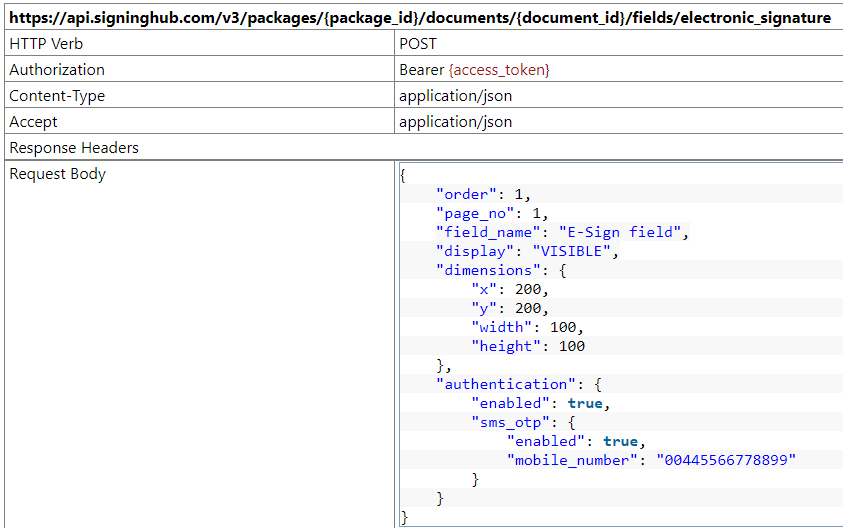 |
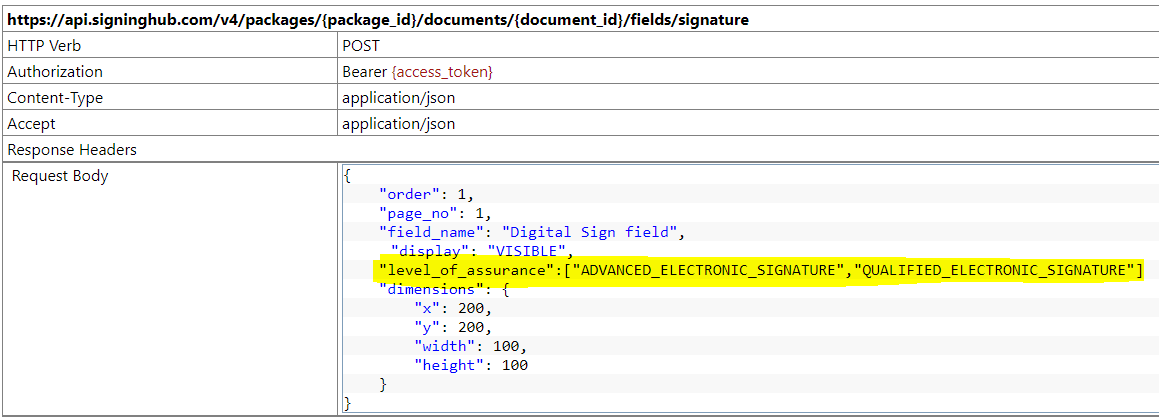 |
|
From 779, Electronic Signature Field has been replaced by with Signature Field, and which capacity should be used at the time of signing is controlled via the level of assurance.
|
|
For Backward Compatibility (in Database)
|
New parameters added
|
Update Electronic Signature Field
| V3 (Update Electronic) | V4 (Update Electronic) |
|---|---|
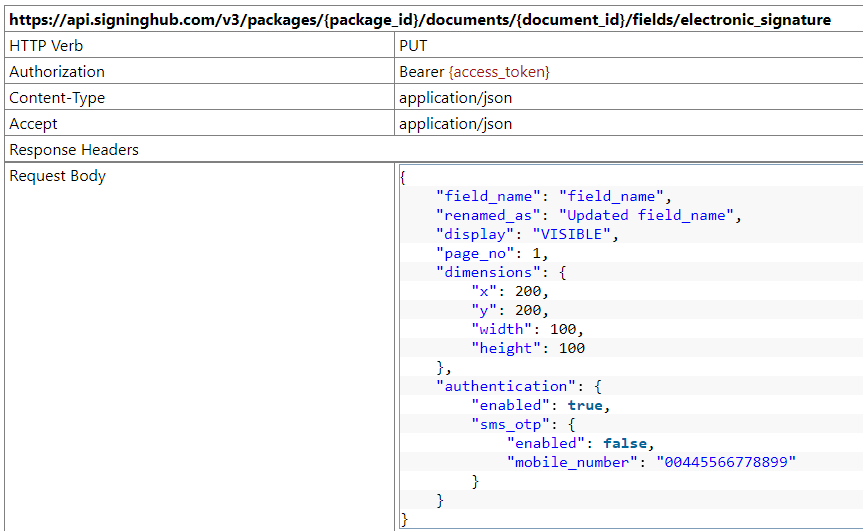 |
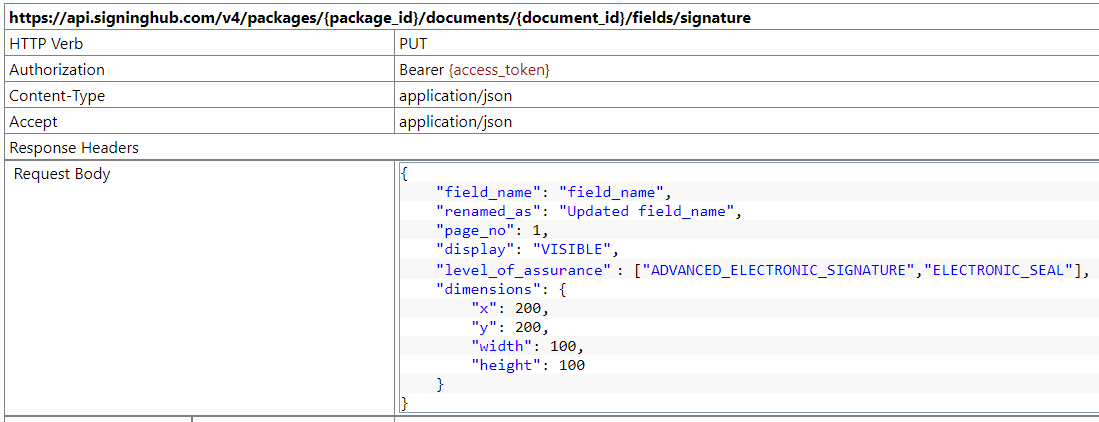 |
|
From 779, Electronic Signature Field has been replaced by with Signature Field, and which capacity should be used at the time of signing is controlled via the level of assurance.
|
|
For Backward Compatibility (in Database)
|
New parameters added
|
Add In-Person Signature
| V3 (Add) | V4 (Add) |
|---|---|
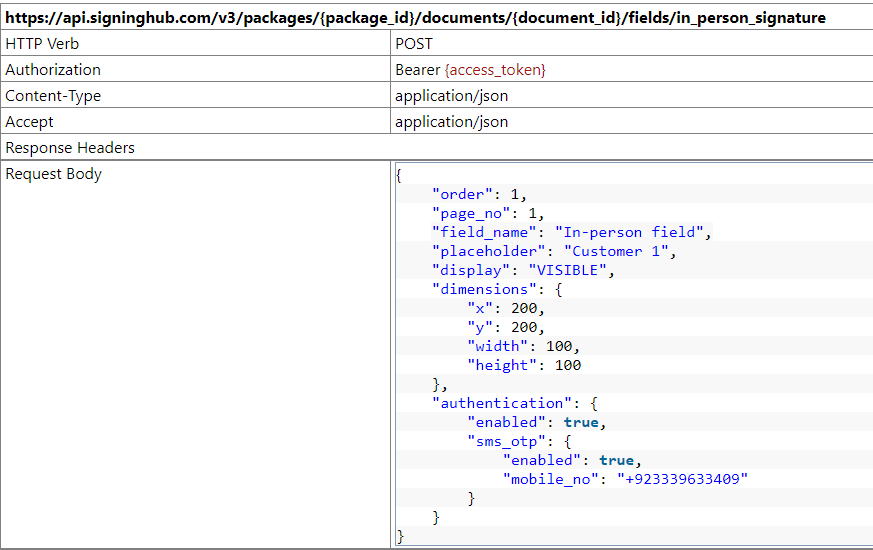 |
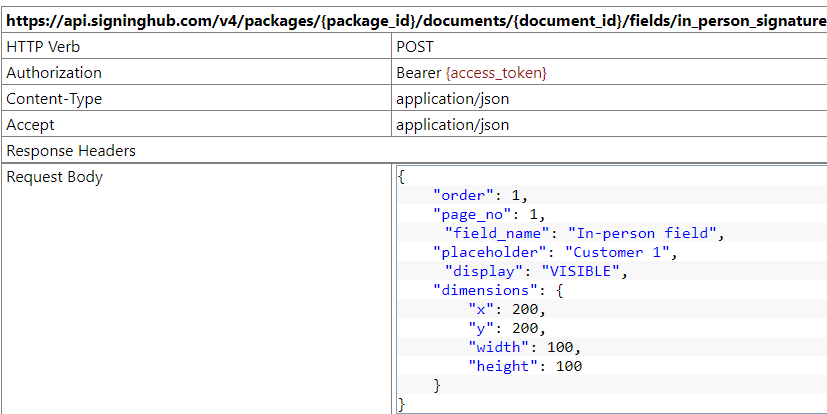 |
|
From 779, Authentications have been removed from In-person signatures. |
|
|
if any of the authentications are applied then it will not work and neither will be saved in the database. |
|
Update In-Person Signature
Assign Document Field
Get Document Fields
AutoPlace API
Document Workflow
Below are the APIs that are impacted
Update Workflow User Authentication
Document Processing
Below APIs are impacted
Sign Document
Account Management
Below APIs are impacted
Get User Role
Personal Settings
Below APIs are impacted
Get Signature Settings
| V3 | V4 |
|---|---|
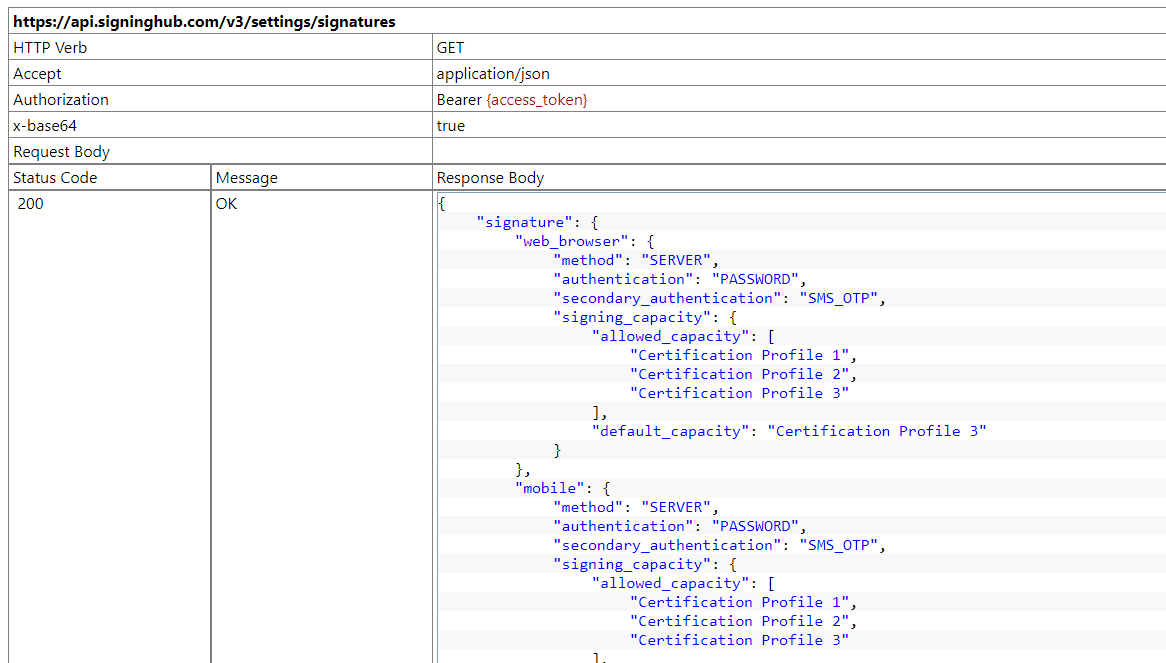 |
 |
|
Supported Tokens
This section provides information of supported tokens by SigningHub.
- Client Credentials Token - The Client Credentials grant type is used by clients to obtain an access token outside of the context of a user. This is typically used by clients to access resources about themselves rather than to access a user's resources. The business application should use client credentials token to authenticate themselves and to manage an enterprise or use scope token API to perform actions on behalf of the user. Click here for more details
- User Credentials Token - The Password grant type is a way to exchange a user's credentials for an access token. This is typically used to access users' resources like upload, share, etc. Enterprise Actions should be allowed in the user's role to manage them. Click here for more details
- Scope Token - The business application uses scope API to create a token that then allows the business application to perform actions on behalf of the users. This will require a business application to be authenticated first.Click here for more details
Below is the list of APIs that provdes information of which api is allowed to be used by token.
 shows that API is supported
shows that API is supported- (-) shows that API is not supported
This section provides a quick "Do this and it works" guide for developers to understand how they can integrate SigningHub features within their business applications.
Overview
SigningHub exposes an external communication channel that allows external business applications to authenticate themselves, send requests and receive responses. This integration can be done with an on-premise instance (or private cloud instance) or the public cloud service running here www.signinghub.com.
The business application uses a secure HTTPS session to pass the document and its workflow control data to SigningHub. Using this approach, SigningHub can quickly and easily integrate with business applications to provide users with document review and digital signature approval functionality.
There is no Software Development Kit (SDK) for the integration, instead, SigningHub provides REST APIs that simplify the integration and can be used with any language including .Net, Java, PHP, etc.
Integration Scenarios
There are two ways to integrate SigningHub within a business application:
- Tight Integration - The business application uses SigningHub to provide document review and digital signature functionality. Users interact with the business web application and when they get to the point where a document requires approval SigningHub is invoked to display it within an iframe. The user is unaware that SigningHub functionality is used. The user can review the entire document and sign in their defined location. Tight integration is suitable for ECM, CRM, and ERP web applications or portals where a known user already interacts in a defined way. The user login information can be used by the business application to create and connect the user to their respective SigningHub account.
-
Loose Integration - The business application sends a document to SigningHub together with control information. SigningHub creates and manages the workflow and emails each user in turn prompting them to log in, review and sign the document. Users log in and see the document within the SigningHub view and sign screen. They can review the entire document and sign in their defined location. This mode is most suitable for integration with a back-office application that has no exposed public-interface
This Quick Guide summarises how to use tight integration. The SigningHub software includes an example tight integration demo website built in .NET to help developers with web application/portal integration.
Tight Integration
The following diagram summarizes the process for tight integration:
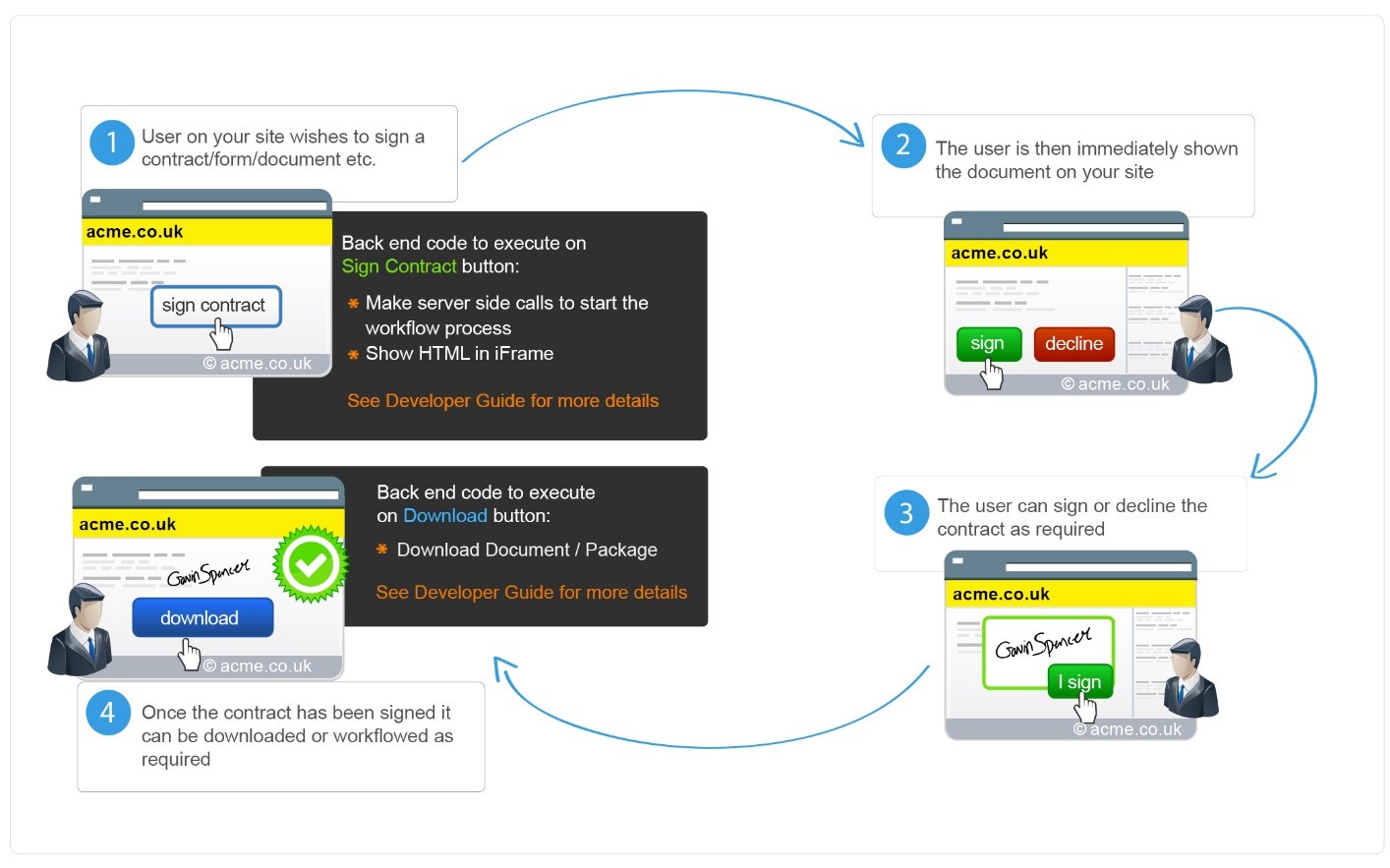
In this mode of integration, users interact with the business web application. At some point, there is a need to view and sign a document. For ease of use, the user does not need to register or login in order to view and sign the document. In tight integration, the web application uses iframe technology to embed the SigningHub view and sign page within an existing webpage.
The user’s signing field is highlighted for them, and clicking on such enables them to create their digital signature. All of these web service interactions are performed in a way that ensures the user has a seamless experience fully consistent with the existing business application.
When using tight integration, users do not login directly to the SigningHub and no email is generated by SigningHub. It is the business application’s responsibility to manage the workflow and keep the user informed.
The process is:
- (Manual Step) - an Enterprise Account must be created
- (Manual Step) - an Enterprise Client ID, Client Secret and Call back URL must be configured
- (Manual Optional Step) - the Enterprise Admin creates a workflow template
- (Manual Optional Step) - the Enterprise Admin uploads a document to Enterprise Library which will be later sent to your user to sign
- (Coding) - the business application gets a client credential access token which is then used to get scope token
- (Optional coding) - the business application registers a new Enterprise User
- (Coding) - the business application gets a scope token using client credentials access token which is used for subsequent API calls
- (Coding) - the business application uploads a new package to the Enterprise User (used as Scope) account
- (Coding) - the business application applies a template or dynamically adds fields to the document
- (Coding) - the business application starts the document workflow
- (Coding) - the document is shown to the Enterprise User (used as Scope) within an iframe
- (Manual) - the enterprise user review and signs the document within an iframe
- (Optional coding) - the business application downloads the package/document
These steps are explained in more detail here:
- Step 1 - Create an Enterprise Admin Account (Manual) - the business application has to register for an enteprise account. The SigningHub cloud service www.signinghub.com can be used for testing and you can create a free Enterprise Admin account by clicking the FREE TRIAL button.
- Step 2 - Generate the API Key (Manual) - Click here for instructions
- Step 3 - Create a Workflow Template (Manual, Optional) - Click here for instructions. If template can't be used and you want to dynamically add fields then skip this step
- Step 4 - Add a Document to the Library (Manual, optional) - If a standard document or contract is used you can avoid uploading the document programmatically for every use case. All you need is to maintain your document in your enterprise library and use the ID of the document as a reference in your application. Click here for more information about managing documents in an enterprise library
- Step 5 - Get client credential token via the API (Coding) - this call authenticates the business application access to SigningHub. This requires the Enterprise Client Secret and Client Id that in return sends the access token. For authentication, the business application needs to send an HTTP POST request to SigningHub. The following is an example request/response:
Header Parameters
application/x-www-form-urlencoded
application/json
REQUEST BODY SCHEMA
"client_credentials"
Define the OAuth 2.0 grant type.
non-empty
Application Name that is configured in your Enterprise Account when configuring the integration options.
non-empty
API Key that that is generated in your Enterprise Account when configuring the integration options.
Request Body
grant_type=client_credentials&
client_id= CLIENT_ID&
client_secret= CLIENT_SECRET&
Sample Response
- Step 6 - Register an Enterprise User via the API (Coding, Optional) - this represents the user account that will be used to upload the document and will be shared to sign the signature field. An account for the signer must exist, if it does not then to create a signer, the business application needs to send the following example request only once. To learn more about each parameter used consult the developer manuals here.
Header Parameters
application/json
application/json
Bearer {access_token}
Access token obtained after a successful authentication. This service requires the access token to be obtained using the client credentials.
REQUEST BODY SCHEMA
The email address of the user account to be registered.
The name of the user to be registered.
Job title of user.
Company name of user.
Mobile number of user.
The password of the user account. This is optional if you want your users to authenticate externally e.g. via SAML, Salesforce, Office 365 etc. rather than using a SigningHub ID (email/password). If password is provided, application expects the security question and answer as mandatory fields.
Security question used to reset password if user forgets his password. This is mandatory if you wish to allow the user to sign without manually, via an email link, completing the registration process. If security question is provided, application expects password and security answer as mandatory fields.
Security answer used to reset the password if user forgets his password. This is mandatory if you wish to allow the user to sign without manually, via an email link, completing the registration process. If security answer is provided, application expects password and security question as mandatory fields.
The enterprise role to be assigned to this user - these are managed within the Enterprise account.
This defines whether enterprise user would get an email notification about the account creation. Default value is 'false'.
Request Body
Sample Response
- Step 7 - Authenticate Enterprise User (Coding) - this authenticates access to SigningHub and requires the Enterprise User email address and client credentials access token. An OAuth 2.0 access token is returned. For authentication, the business application needs to send an HTTP POST request to SigningHub. The received access token is then used to upload, prepare and share the document. Following is an example request/response:
Header Parameters
application/json
application/json
Bearer {access_token}
This service requires the access token to be obtained using the client credentials.
REQUEST BODY SCHEMA
non-empty
Email of a registered enterprise user
Request Body
Sample Response
- Step 8 - Add Package (Coding) - This service API is used to add/create a document package to hold one or more documents. This package can then be used to add documents and recipients in order to start a new workflow.
Header Parameters
application/json
application/json
Bearer {access_token_scope}
Access token returned in Scope API call
REQUEST BODY SCHEMA
non-empty
The name of the package.
ONLY_OTHERS
Enum: "ME_AND_OTHERS" "ONLY_OTHERS" "ONLY_ME"
Inbox
The name of the folder. It will be used to upload package in any folder of the user, either its a custom folder or a shared folder.
Request Body
Sample Response
-
Step 8.1 - Add Document or dynamically add fields (Coding) - Business applications can use this service API to add a document from the user’s library to a package. The
package_idis provided in the URL which should be the same as found in the previous call. The document ID must be provided asdocument_idin the resource URL to identify the library document to be copied.
Path Parameters
The ID of the package to which the document is being added.
The ID of the document that will be fetched from libary and added to the package
Header Parameters
application/json
application/json
Bearer {access_token_scope}
Access token returned in Scope API call
In the case where the business application creates the document dynamically then you can upload the document using the Upload Document API call explained here , as opposed to using a document from your respective library
Sample Response
-
Step 9 - Apply Template or dynamically add fields (Coding) - Business applications can use this service API to apply a workflow template to a document. The document ID on which template has to be applied is provided in the resource URL. In this call the
package_idshould be same as used in step 9 and thedocument_idis the one the user got in the response of step 8.
Path Parameters
The ID of the package.
The ID of the document on which the template will be applied.
Header Parameters
application/json
application/json
Bearer {access_token_user}
Access token returned in Scope API call
REQUEST BODY SCHEMA
Name of template to be applied on the document.
false
True, if template has to be applied on all the documents in the package.
In the case where the template contains a placeholder or a user that you wish to change then you can use the Update Workflow User API call as explained here.
Alternatively if due to the dynamic nature of the document you cannot apply a template and want to add different fields, e.g. text field, checkbox, initials, signature fields etc., then you can add them dynamically by providing the X, Y, Width, Height coordinates, package ID, document ID, page number and assign to a user. Click here to learn more.
Request Body
Sample Response
- Step 10 - Share Package (Coding) - Business applications can use this service API to share a document with the designated signatories and start a new workflow. The document should already have been prepared by optinally applying a template and optionally updating the users and actions defined in template. The package ID to be shared is provided in the resource URL. In this call the package_id should be same as used in step 8.
Path Parameters
The ID of the package that has to be shared.
Header Parameters
application/json
application/json
Bearer {access_token_scope}
Access token returned in Scope API call
Sample Response
- Step 11 - Generate Integration URL for Encrypted Data (Coding) - Business applications can use this service API to generate an encrypted URL to access a document and to perform signing operation on that document. The returned URL in response will be an encrypted URL which contains all the information which was provided in request body. See sample request below.
Header Parameters
application/json
application/json
Bearer {access_token_scope}
REQUEST BODY SCHEMA
non-empty
The ID of the package that has been shared in step 10.
""
Language code in which application is required be shown to end user. if no value is provided then system defined language will be used.
""
user_email is reqruied when a Guest user has to process the document.
""
URL, where user will be redirected after completing the required actions. if no value is provided then system will follow what's been configured in Enterprise Settings > Integration
""
True, will hide the panels in the iframe mode. if no value is provided then it will follow what's been set in Integration options
""
ENCODED, PLAIN
Request Body
Sample Response
- Step 12 - Review Document in Iframe (Coding) - Client web applications create an iframe with the source of the iframe that is being returned in step 11 as follows:

Iframe view in browser
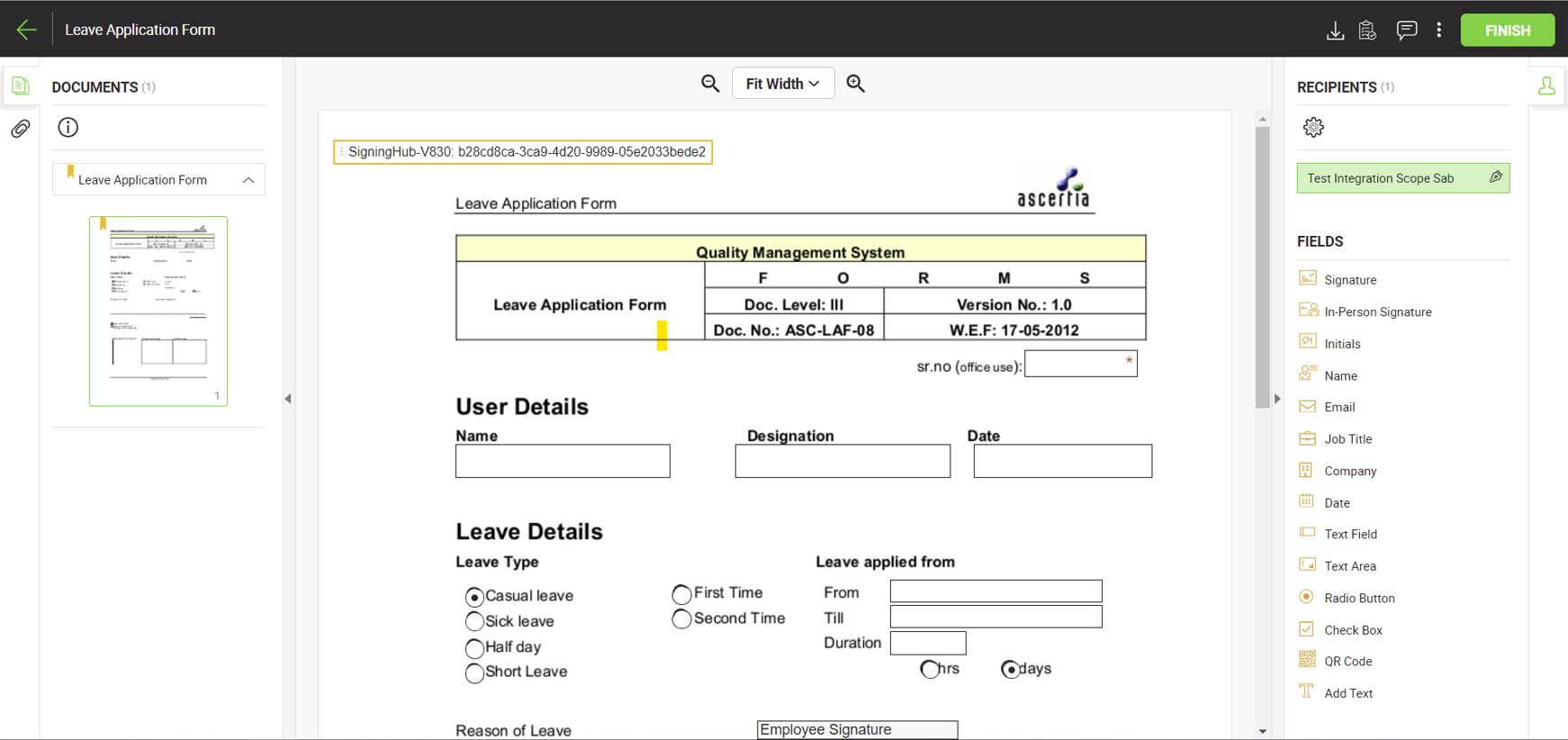
-
Step 13 - Handle Call-back (Coding) - Once the user has signed, declined or reviewed and approved the document within the SigningHub document viewer, the user can close the document and return to the web application. When the user closes the document, SigningHub immediately returns control to the web application using the configured URL for that specific integration. This is the 'call-back' parameter, configured under the Application Integration settings.
Control is returned to the web application as soon as the user navigates away from the document viewer window. For cases such as signature operations this occurs when the user completes the signing process and clicks on 'Finish' button. Browser navigation (back button) is another way of navigating away from the document viewer and will also result in control passing back to the web application, and invoke the call-back URL.
When control returns to the web application, SigningHub appends the following parameters to the call-back URL to inform the web application of the action status. Response type can be encoded or plain depending on the value response_type sent in the request
Respose Details
| Response Type | Description |
|---|---|
| ENCODED | [callback_url]?lang=en_USpackage_id%3D1017545%26action%3Dnone |
| Plain | [callback_url]?lang=en_US&package_id=1017545&action=signed |
Parameters Details
| Name | Description |
|---|---|
| package_id | The ID of the package that was shown to the user. |
| action |
Provides information about the action the user performed on the document. The possible values are:
|
- Step 13.1 - Check Workflow Status (Coding) - Once the document has been shared and the workflow is in progress, the document owner may want to see the current status of the workflow. The status of workflow at any time can be checked by using the Get Workflow Details API. Click here for details.
- Step 15 - Download Package/Document (Coding)
Following are the APIs that have been affected by the changes:
Following is the list of updates in older versions
New APIs
| Personal Settings | |
|---|---|
| Account Management | |
| Document Package | |
| Document Workflow |
Get Workflow User Permissions of Enterprise Package |
Updates in existing APIs
Document Workflow
Below are the APIs that are affected by the change.
Update Workflow User Permissions
| 8.3 (Update Workflow User Permissions) | 8.4 (Update Workflow User Permissions) |
|---|---|
| From 8.4, SigningHub has allow to update all recipient permissions for individual workflow type | |
| SigningHub allow to update only first recipient permissions for individual workflow type | SigningHub has allow to update all recipient permissions for individual workflow type |
Enterprise Management
Below are the APIs that are affected by the change.
Delete Enterprise Package
| 8.3 (Delete Enterprise Package) | 8.4 (Delete Enterprise Package) |
|---|---|
| From 8.4, SigningHub has added the support of Client Credentials Access Token for Delete Enterprise Package | |
| SigningHub does not have the support to Delete Enterprise Package via Client Credentials Access Token | SigningHub added the support to Delete Enterprise Package via Client Credentials Access Token |
SigningHub Admin APIs
Below are the APIs that are affected by the change.
Create Account
| 8.3 (Create Account) | 8.4 (Create Account) |
|---|---|
| From 8.4, SigningHub has allow to create Individual Users | |
| SigningHub does not have the support to Create Individual User | SigningHub added the support to Create Individual User |
Workflow Comments
Below are the APIs that are affected by the change.
Get Workflow Comments
| 8.3 (Get Workflow Comments) | 8.4 (Get Workflow Comments) |
|---|---|
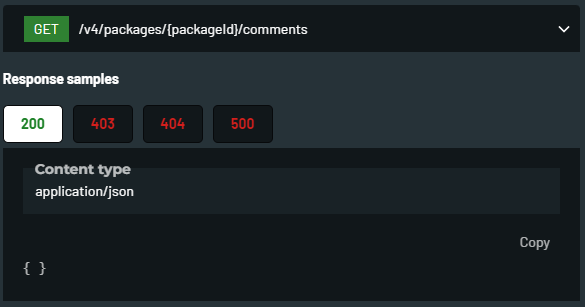 |
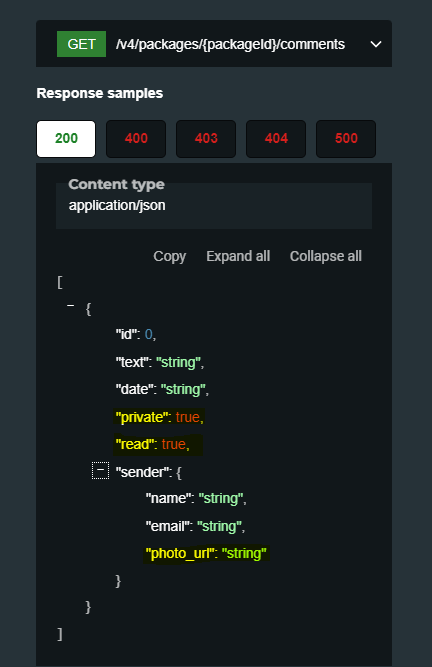 |
| From 8.4, SigningHub has introduced the private, photo_url and read parameters to provide information about comment. | |
Add Workflow Comments
Document Workflow
Below are the APIs that are affected by the change.
Get Workflow User Permissions
| 8.3 (Get Workflow User Permissions) | 8.4 (Get Workflow User Permissions) |
|---|---|
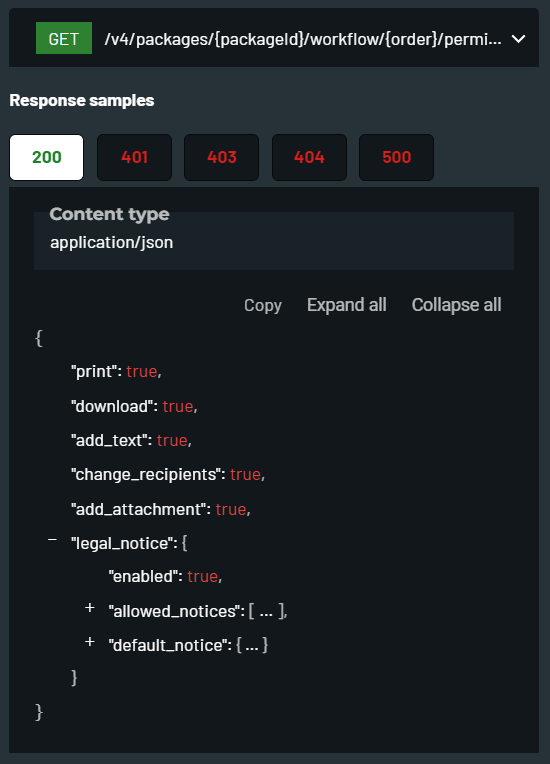 |
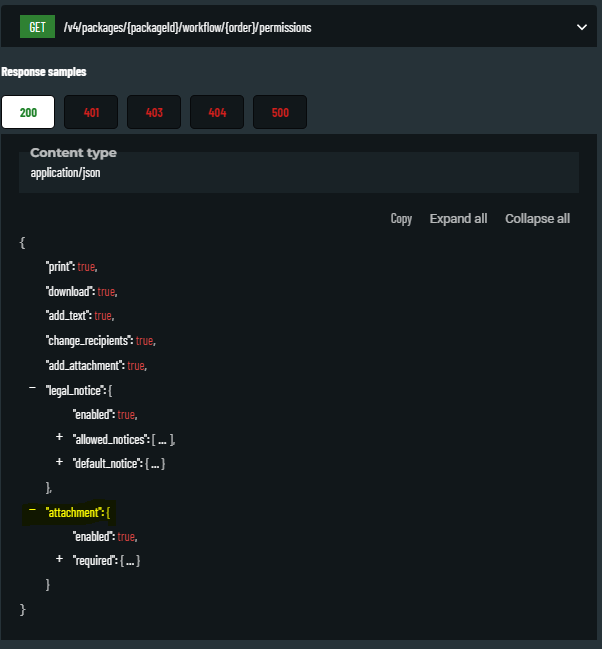 |
| From 8.4, SigningHub has introduced the attachment parameter to provide information about required attachment. | |
Update Workflow User Permissions
Get Workflow Details
Get Workflow Users
| 8.3 (Get Workflow Users) | 8.4 (Get Workflow Users) |
|---|---|
 |
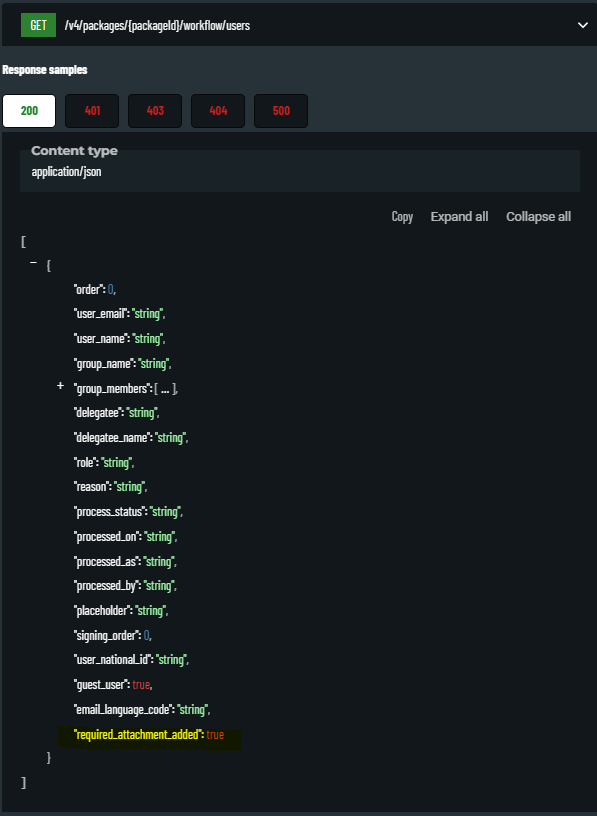 |
| From 8.4, SigningHub has introduced the required_attachment_added parameter to provide information about user required attachment added. | |
Document Preparation
Below are the APIs that are affected by the change.
Add Digital Signature Field
Update Digital Signature Field
Add In-person Field
Update In-person Field
Get Document Fields
Account Management
Below are the APIs that are affected by the change.
Get User Role
Account Management
Below are the APIs that are affected by the change.
Get Signature Settings
| 8.3 (Get Signature Settings) | 8.4 (Get Signature Settings) |
|---|---|
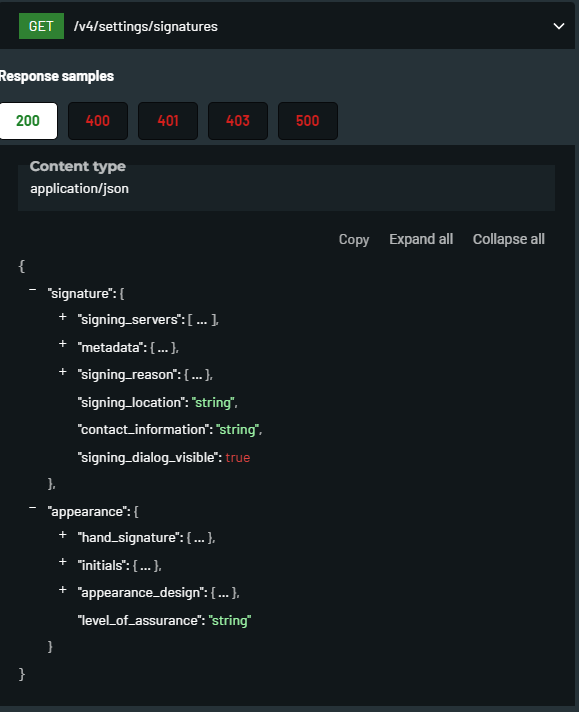 |
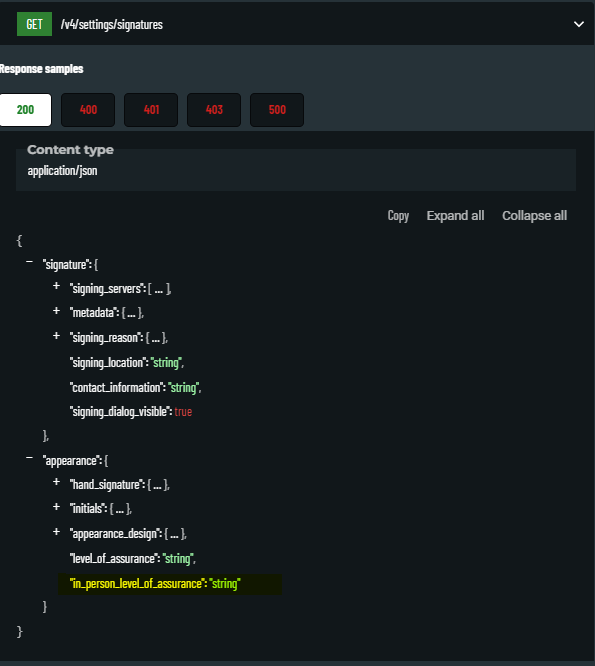 |
| From 8.4, SigningHub has introduced the in_person_level_of_assurance parameter in appearance for in-person default level of assurance. | |
Get Templates
| 8.3 (Get Templates) | 8.4 (Get Templates) | |
|---|---|---|
| Returned the templates | From 8.4, SigningHub has updated the api logic, will return the templates based on role settings. | |
Document Package
Below are the APIs that are affected by the change.
Get Document Details
Close Document Package
Get Packages
| 8.3 (Get Packages) | 8.4 (Get Packages) |
|---|---|
| From 8.4, SigningHub has introduced the x-recipient-details header parameter to provide recipient details regarding Document Access Duration along decline information | |
Download Document
| 8.3 (Download Document) | 8.4 (Download Document) |
|---|---|
| From 8.4, SigningHub has allowed to download document in the DRAFT Mode. | |
Download Document(Base64)
| 8.3 (Download Document(Base64)) | 8.4 (Download Document(Base64)) |
|---|---|
| From 8.4, SigningHub has allowed to download base64 of document in the DRAFT Mode. | |
Download Package
| 8.3 (Download Package) | 8.4 (Download Package) |
|---|---|
| From 8.4, SigningHub has allowed to download package in the DRAFT Mode. | |
Download Package (Base64)
| 8.3 (Download Package (Base64)) | 8.4 (Download Package (Base64)) |
|---|---|
| From 8.4, SigningHub has allowed to download base64 of package in the DRAFT Mode. | |
Document Processing
Below are the APIs that are affected by the change.
Fill Form Fields
Approve Document
Gatekeeper Approve Document
Submit Document
Bulk Sign Packages
For such operations, for example in tight integration, the intended recipient credentials must be used as opposed to enterprise admin. The Authenticate API call returns an access token in the response which must be saved by the business client and must be provided with each subsequent API call as a bearer token for authorisation. Note this token is used in tight integration scenarios for both digital and electronic signatures.
When invoking the refresh token option this will generate both a new access token for use, and refresh token for a subsequent refresh operation. The refresh token operation means the correct grant type must be used, i.e. refresh_token, and the client_id and client_secret parameters are required. User name, password and scope are not required.
Second Factor Authentication as OTP
If a user has OTP configured as a second factor authentication, this API will throw an error 403 with a JSON response of error and error_description. It will also send two response headers.- x-otp
- x-mobile-number
If phone number is empty, application should ask for the phone number from the end user to send the OTP on the given number. For sending OTP, use OTP Login Authentication API call.
Once OTP is received, client application will again call the following authenticate API to authenticate the user with two factors, i.e., Password and OTP. To submit the OTP request in the authenticate API a new request header is expected.
- x-otp
This request header will contain the OTP that was received on the mobile. Server side will authenticate the user based on user email, password and also verify the OTP. Once everything is verified end user will receive the access token details.
Terms & Services
After implementation of GDPR, SigningHub will enforce the end users to agree with new terms and services, every time there is a change in it. Calling authentication API end point will check if the user has provided proper authentication information. Once validated, it will also check if the user has agreed to the latest terms and services or not. If user has already agreed to the terms everything will work in the previous fashion. If new terms and services are found that are not agreed by the user the API will send following response header as false, along with access token details.
- x-terms-agreed
Note: Agreement to terms of use is required if this feature is enabled in "system settings" to meet the GDPR requirements.
Enforce Password Reset
If enterprise has set the policy to reset password on first login for newly register users or on password expiration then in that cases this API call won't return the authentication token for users. Instead, 403 with a JSON response of error and error_description would be returned. It will also send a response header.- x-change-password
Client Credentials Authentication
Authenticate using client_id and client_secret with grant_type = client_credentials and retrieve access_token
header Parameters
| Content-Type required | string Default: application/json |
| Accept required | string Default: application/json |
| Content-Type | string Default: application/x-www-form-urlencoded |
Request Body schema: multipart/form-data
| grant_type required | string Default: "client_credentials" Grant type client_credentials is used when operations are performed on behalf of the application. |
| client_id required | string Default: "ACMapAppId" Application Name that you have configured in your Enterprise Account when configuring the integration options. |
| client_secret required | string Default: "jr67gj0h76gr83nf8734nj59g4he895jh87nr" API Key that you generated in your Enterprise Account when configuring the integration options. |
Responses
Response samples
- 200
- 400
- 401
- 403
- 500
{- "access_token": "string",
- "token_type": "string",
- "expires_in": 0,
- "refresh_token": "string"
}Password Authentication
Authenticate using client_id and client_secret and retrieve an OAuth 2.0 access_token
header Parameters
| Accept required | string Default: application/json |
| Content-Type | string Default: application/x-www-form-urlencoded |
Request Body schema: multipart/form-data
| grant_type required | string Default: "password" Define the OAuth 2.0 grant type. It can be set to "password", "client_credentials", "refresh_token" or "active_directory". Note for most operations "password" is sufficient. Active Directory is used when the authentication required is the user's AD credentials. Client_credentials is reserved for internal use at this stage. |
| client_id required | string Default: "ACMEapp" Application Name that you have configured in your Enterprise Account when configuring the integration options. |
| client_secret required | string Default: "jr67gj0h76gr83nf8734nj59g4he895jh87nr" API Key that you generated in your Enterprise Account when configuring the integration options. |
| username required | string Default: "admin@ascertia.com" SigningHub email address identifying the target user account - this can be an Enterprise Admin or an Enterprise User account. Note an enterprise user can use an API Key created for the enterprise by an enterprise administrator. |
| password required | string Default: "Password@12" Password for the account defined in the 'username' parameter. |
| scope | string Default: "john @ascertia.com" Used when the Enterprise Admin user is identified in 'username' and you wish to identify an Enterprise User as the target. That is, set an enterprise user as the current user for operations. For example, to update the general profile settings of an enterprise user then the "scope" variable can be used. |
| refresh_token | string Default: "rtfgdsxtrgefds543wedsx" If access_token is expired, refresh token is used along with grant type refresh_token. If refresh token is provided, username, password and scope attributes can be treated as optional. |
Responses
Response samples
- 200
- 400
- 401
- 403
- 500
{- "access_token": "string",
- "token_type": "string",
- "expires_in": 0,
- "refresh_token": "string"
}Scope Authentication
Business applications can call this API to get the scope access token on behalf of an enterprise user and perform any action other than document signing.
header Parameters
| Authorization required | string Default: Bearer {access_token} OAuth access token obtained as a result of successful authentication via "client_credentials" grant type. |
| Content-Type required | string Default: application/json |
| Accept required | string Default: application/json |
Request Body schema:
| user_email required | string non-empty Scope user email address |
Responses
Request samples
- Payload
{- "user_email": "string"
}Response samples
- 200
- 401
- 403
- 500
{- "access_token": "string",
- "token_type": "string",
- "expires_in": 0,
- "refresh_token": "string"
}Kerberos Authentication
SigningHub uses OAuth 2.0 to authorize client requests. This API endpoint will present a Kerberos authentication challenge if the API is called in a browser that supports Kerberos authentication.
To get the Windows Kerberos dialog for authentication, use "withCredentials" in jQuery AJAX calls.Or on server side language like c# HttpClient object you can use "UseDefaultCredentials" with HTTP(S) requests.
header Parameters
| Authorization required | string Default: Bearer {access_token} User authentication access token - bearer token for subsequent authorisation to other API calls. |
| Content-Type required | string Default: application/json |
| Accept required | string Default: application/json |
Request Body schema:
| client_id required | string non-empty Application Name that you have configured in your Enterprise Account when configuring the integration options. |
| client_secret required | string non-empty API Key that you generated in your Enterprise Account when configuring the integration options. |
| profile_name | string |
Responses
Request samples
- Payload
{- "client_id": "string",
- "client_secret": "string",
- "profile_name": "string"
}Response samples
- 200
- 400
- 401
- 403
- 500
{- "access_token": "string",
- "token_type": "string",
- "expires_in": 0,
- "refresh_token": "string"
}Single Sign On Authentication
SigningHub uses OAuth 2.0 to authorize client requests. Business application can call this API to get the access token of user by requesting third party, based on provided method and token. Currently supported third parties are Office 365, Azure Active Directory, OAuth2 and OIDC.
header Parameters
| Authorization required | string Default: Bearer {access_token} OAuth access token obtained as a result of successful authentication via "client_credentials" grant type. |
| Content-Type required | string Default: application/json |
| Accept required | string Default: application/json |
Request Body schema:
| token | string Token obtained from 3rd party e.g Office 365, Azure Active Directory, OAuth 2, OIDC |
| code | string Code obtained from OAuth2 or OIDC (authorize response) |
| method required | string non-empty Supported method type e.g "Office_365", "Azure_Active_Directory", "OAUTH2", "OIDC" |
| profile_name | string Authentication profile name, required for "OAUTH2" and "OIDC" |
| profile_id required | integer <int32> Authentication profile id, Its an alternate of profile_name |
Responses
Request samples
- Payload
{- "token": "string",
- "code": "string",
- "method": "string",
- "profile_name": "string",
- "profile_id": 0
}Response samples
- 200
- 400
- 401
- 403
- 500
{- "access_token": "string",
- "token_type": "string",
- "expires_in": 0,
- "refresh_token": "string",
- "authentication_access_token": "string"
}OTP Login Authentication
SigningHub supports second factor authentication using One Time Password at login time via the web site GUI. Note this is different to OTP via SMS used in electronic signatures at the point of signing. This specifically refers to using the second factor authentication for SigningHub system access.
To enable One Time Password second factor authentication see here.It is an option in the Enterprise Role settings.
At least one SMS provider must be configured in SigningHub administration in order to use this functionality.
This API call is used to allow business applications to request an One Time Password to the user's mobile device for subsequent use in second factor authentication in the GUI.
Note the mobile number is an optional field.If not supplied, SigningHub will attempt to send the OTP to the mobile number stored in the user's Profile settings. If a mobile number is supplied in the call, then the OTP will be sent to this number, and any stored one under Profile settings will be ignored.
In the event that no mobile number is supplied, nor found under the user's Profile settings, an error will be returned.
header Parameters
| Authorization required | string Default: Bearer {access_token} OAuth access token obtained as a result of successful authentication via "password" grant type. |
| Content-Type required | string Default: application/json |
| Accept required | string Default: application/json |
Request Body schema:
| mobile_number | string Mobile number of the user in case user do not have a mobile number already in his profile. SigningHub application will update the new phone number in the profile automatically. |
| method | string Method Possible values are "EMAIL", "SMS" |
Responses
Request samples
- Payload
{- "mobile_number": "string",
- "method": "string"
}Response samples
- 200
- 400
- 401
- 403
- 500
{ }Pre Login Authentication
Business application can use this API to get the authentication method for the user, based on the configurations set in enterprise role
header Parameters
| Authorization required | string Default: Bearer {access_token} OAuth access token obtained as a result of successful authentication via "client_credentials" grant type. |
| Content-Type required | string Default: application/json |
| Accept required | string Default: application/json |
Request Body schema:
| username required | string non-empty Email address of the user for which authentication method is te be retrieved. |
Responses
Request samples
- Payload
{- "username": "string"
}Response samples
- 200
- 403
- 500
{- "profile_id": 0,
- "profile_name": "string",
- "method": "string",
- "app_id": "string",
- "tenant_id": "string",
- "url": "string",
- "scope": "string",
- "resource": "string"
}Get Service Agreements
Business applications can use this service API to get terms of services and privacy policy that are configured in SigningHub Admin console.
For details how to configure this content in SigningHub follow this link.Note the content applies across the system.
A successful response is only possible if the content is set of course.
header Parameters
| Content-Type required | string Default: application/json |
| Accept required | string Default: application/json |
Responses
Response samples
- 200
- 400
- 500
{- "version_number": 0,
- "name": "string",
- "description": "string",
- "terms_of_service": "string",
- "privacy_policy": "string"
}Get Public Authentication Profiles
Business application can use this API to get all the public authentications configured in the SigningHub.
header Parameters
| Authorization required | string Default: Bearer {access_token} OAuth access token obtained as a result of successful authentication via "client_credentials" grant type. |
| Content-Type required | string Default: application/json |
| Accept required | string Default: application/json |
Responses
Response samples
- 200
- 403
- 500
[- {
- "profile_id": 0,
- "profile_name": "string",
- "method": "string",
- "app_id": "string",
- "tenant_id": "string",
- "private_profiles_count": 0,
- "logo_url": "string",
- "url": "string",
- "scope": "string",
- "resource": "string"
}
]Revoke Refresh Tokens
Business application can call this API to revoke the refresh tokens generated for a user. The refresh token is generated and sent when a successful authentication request is made.
header Parameters
| Authorization required | string Default: Bearer {access_token} Users access token |
| Accept required | string Default: application/json |
| Content-Type | string Default: application/x-www-form-urlencoded |
Request Body schema: multipart/form-data
| refresh_token required | string Default: "45ghiukldjahdnhzdauz" OAuth refresh access token to revoke. |
| token_type_hint required | string Default: "refresh_token" Type of token. Currently only refresh_token is supported. |
Responses
Response samples
- 200
- 400
- 401
- 403
- 500
{ }Logout
Applications can call this API when a user logout from the application. This API call will update the user activity.
header Parameters
| Authorization required | string Default: Bearer {access_token} OAuth access token obtained as a result of successful authentication via "password" grant type. |
| Content-Type required | string Default: application/json |
| Accept required | string Default: application/json |
Request Body schema:
| device_token required | string non-empty Push notification token that needs to be removed from the server in case of logout. |
Responses
Request samples
- Payload
{- "device_token": "string"
}Response samples
- 200
- 401
- 403
- 404
- 500
{ }This section entails the web services for the Document Package related operations i.e. Add, Delete, Download, and Share.
Share Document Package
Business applications can use this service API to share a document package with the signers and start a new workflow. The document should already have been prepared by applying a template and optionally updating the users and actions defined in template. The package ID to be shared is provided in the resource URL.
path Parameters
| packageId required | integer <int32> The document package to be shared. |
header Parameters
| Authorization required | string Default: Bearer {access_token} The access token obtained as a result of successful authentication via "Password" or "Scope". If "Scope Authentication" was used, then this service will be performed for the user on behalf of the business application. |
| Content-Type required | string Default: application/json |
| Accept required | string Default: application/json |
Responses
Response samples
- 200
- 401
- 403
- 404
- 500
[- {
- "package_id": 0,
- "documents": [
- 0
]
}
]Apply Workflow Template
Business applications can use this service API to apply a workflow template to a document. The document ID on which template has to be applied is provided in the resource URL. When document ID is set to 0 then template will be applied to to all of the doucments in a pacakge.
While applying the template it is important to remember these two important points:
Point 1 - If the template being applied is created using a PDF which already contained form fields then ensure that the document on which this template is now being applied must contain these form fields in advance and SigningHub will NOT create those form fields via the template rather only apply the form data and assign to the respective users.
Point 2 - If the template being applied is created where form fields are manually added (hence not present in the PDF originally) via SigningHub e.g. signature field, initial, in-person signature, check boxes, radio buttons, text fields etc. then on applying such a template, these form fields will be created on the target document even if these form fields were already present in the document.
path Parameters
| packageId required | integer <int64> The Package ID of the package to which the template needs to be applied. |
| documentId required | integer <int64> The document ID on which the template needs to be applied. If the value is set to 0, if template is to be applied on all the documents in the package. |
header Parameters
| Authorization required | string Default: Bearer {access_token} The access token obtained as a result of successful authentication via "Password" or "Scope". If "Scope Authentication" was used, then this service will be performed for the user on behalf of the business application. |
| Content-Type required | string Default: application/json |
| Accept required | string Default: application/json |
Request Body schema:
| template_name required | string non-empty Name of template to be applied on the document. |
| apply_to_all required | boolean True, if template is to be applied on all the documents in the package. |
Responses
Request samples
- Payload
{- "template_name": "string",
- "apply_to_all": true
}Response samples
- 200
- 401
- 403
- 404
- 500
{- "document_id": 0,
- "document_name": "string",
- "document_order": 0,
- "document_type": "string",
- "document_width": 0,
- "document_height": 0,
- "document_source": "string",
- "document_pages": 0,
- "form_fields": true,
- "lock_form_fields": true,
- "uploaded_on": "string",
- "modified_on": "string",
- "certify": {
- "enabled": true,
- "permission": "string"
}, - "template": {
- "template_name": "string",
- "read_only": true
}
}Upload Attachment
Business applications can use this service API to upload a attachment in a document.
path Parameters
| packageId required | integer <int64> Package ID of the package to which the document is added. |
| documentId required | integer <int64> ID of the document to which the attachment needs to be add. |
header Parameters
| Authorization required | string Default: Bearer {access_token} OAuth access token obtained as a result of successful authentication via "password" grant type. |
| Content-Type required | string Default: application/octet-stream |
| Accept required | string Default: application/json |
| x-file-name required | string Example: Test file.pdf It's the name of file with extension. |
| x-password | string Example: pincode123 Password of the document, if a document opening password was set by the document owner for the recipient. Otherwise null or ignore. |
| x-otp | string Example: 123456 OTP value for opening the document, if a document opening OTP permission was set by the document owner. Otherwise null or ignore. |
Request Body schema: multipart/form-data
| file (binary Stream) | string <binary> Default: "" This is the document in the raw binary format. |
Responses
Response samples
- 201
- 400
- 403
- 500
{- "attachment_id": 0
}Get Attachments
Business applications can use this service API to get the attachments of a document.
path Parameters
| packageId required | integer <int64> Package ID of the package to which the document is added. |
| documentId required | integer <int64> ID of the document to which the attachment is added. |
header Parameters
| Authorization required | string Default: Bearer {access_token} OAuth access token obtained as a result of successful authentication via "password" grant type. |
| Content-Type required | string Default: application/json |
| Accept required | string Default: application/json |
Responses
Response samples
- 200
- 400
- 403
- 500
[- {
- "attachment_id": 0,
- "attachment_name": "string"
}
]Delete Attachment
Business applications can use this service API to delete the attachment of a document.
path Parameters
| packageId required | integer <int64> Package ID of the package to which the document is added. |
| documentId required | integer <int64> ID of the document to which the attachment is added. |
| attachment_id required | integer <int32> ID of the attachment. |
header Parameters
| Authorization required | string Default: Bearer {access_token} OAuth access token obtained as a result of successful authentication via "password" grant type. |
| Content-Type required | string Default: application/json |
| Accept required | string Default: application/json |
Responses
Response samples
- 200
- 400
- 403
- 500
{ }Download Attachment
Business applications can use this service API to download the attachment of a document.
path Parameters
| packageId required | integer <int64> Package ID of the package to which the document is added. |
| documentId required | integer <int64> ID of the document to which the attachment is added. |
| attachment_id required | integer <int32> ID of the attachment. |
header Parameters
| Authorization required | string Default: Bearer {access_token} OAuth access token obtained as a result of successful authentication via "password" grant type. |
| Content-Type required | string Default: application/json |
| Accept required | string Default: application/json |
Responses
Response samples
- 200
- 400
- 403
- 500
"string"Download Attachment (base64)
Business applications can use this service API to download the attachment base64 of a document.
path Parameters
| packageId required | integer <int64> Package ID of the package to which the document is added. |
| documentId required | integer <int64> ID of the document to which the attachment is added. |
| attachment_id required | integer <int32> ID of the attachment. |
header Parameters
| Authorization required | string Default: Bearer {access_token} OAuth access token obtained as a result of successful authentication via "password" grant type. |
| Content-Type required | string Default: application/json |
| Accept required | string Default: application/json |
Responses
Response samples
- 200
- 400
- 403
- 500
{- "base64": "string"
}Add Package
This service API is used to add/create a document package to hold one or more documents. This package can then be used to add documents and recipients in order to start a new workflow.
As previously stated, this call is mandatory if you wish to work with documents. A package must exist before you can upload or add documents to SigningHub..
Even a single document is a part of a package: a package containing one document.
Note: A package can be renamed if required once created.
header Parameters
| Authorization required | string Default: Bearer {access_token} The access token obtained as a result of successful authentication via "Password" or "Scope". If "Scope Authentication" was used, then this service will be performed for the user on behalf of the business application. |
| Content-Type required | string Default: application/json |
| Accept required | string Default: application/json |
Request Body schema:
| package_name | string The name of the package. Default package name is always "Untitled" if the package_name is not provided. |
| workflow_mode required | string Enum: "ME_AND_OTHERS" "ONLY_OTHERS" "ONLY_ME" |
| folder_name | string The name of the folder. It will be used to upload package in any folder of the user, either it is a custom folder or a shared folder. |
Responses
Request samples
- Payload
{- "package_name": "string",
- "workflow_mode": "ME_AND_OTHERS",
- "folder_name": "string"
}Response samples
- 200
- 400
- 403
- 404
- 500
{- "package_id": 0,
- "workflow_mode": "string",
- "workflow_type": "string"
}Change Document Package Owner
Business applications can use this service API to change the owner of a document package. The new owner must be part of the same Enterprise as the current owner, and must be in an active state.
The document package must be in either In-Progress or Completed state.
The document package ID is supplied in the URL.
Only the current document owner or an Enterprise Admin can use this method.If an Enterprise Admin is using this call then the access token must be obtained using the scope parameter of the current document owner.
path Parameters
| packageId required | integer <int32> The ID of the document package to change. |
header Parameters
| Authorization required | string Default: Bearer {access_token} The access token obtained as a result of successful authentication via "Password" or "Scope". If "Scope Authentication" was used, then this service will be performed for the user on behalf of the business application. |
| Content-Type required | string Default: application/json |
| Accept required | string Default: application/json |
Request Body schema:
| owner required | string non-empty Email address of the new owner. |
Responses
Request samples
- Payload
{- "owner": "string"
}Response samples
- 200
- 401
- 403
- 404
- 500
{ }Close Document Package
Applications can call this API when a document package is closed by a recipient in the application. This API call will update the document reading status as well as create necessary logs.
path Parameters
| packageId required | integer <int32> Package ID of the package which contains the document. |
header Parameters
| Authorization required | string Default: Bearer {access_token} OAuth access token obtained as a result of successful authentication via "password" grant type. |
| Content-Type required | string Default: application/json |
| Accept required | string Default: application/json |
| x-password | string Default: pincode123 Password of the document, if a document opening password was set by the document owner for the recipient. Otherwise null or ignore. |
| x-otp | string Default: 123456 OTP value for opening the document, if a document opening OTP permission was set by the document owner. Otherwise null or ignore. |
Responses
Response samples
- 200
- 401
- 403
- 404
- 500
{ }Delete Package
Business applications can use this service API to delete a document from the user inbox. The package ID is provided in the resource URL as "{package_id}". If the document status is PENDING, then it is automatically declined as result of delete operation. If the document status is SHARED, then the document is automatically recalled and workflow is stopped before the document is deleted.
path Parameters
| packageId required | integer <int64> Package ID of the package which contains the document. |
header Parameters
| Authorization required | string Default: Bearer {access_token} The access token obtained as a result of successful authentication via "Password" or "Scope". If "Scope Authentication" was used, then this service will be performed for the user on behalf of the business application. |
| Content-Type required | string Default: application/json |
| Accept required | string Default: application/json |
Responses
Response samples
- 200
- 401
- 403
- 404
- 500
{ }Download Package
Business applications can use this service API to download the document package in binary format.
The package ID is provided in the resource URL.
If the package contains only one document, the download is the binary PDF document.
Alternatively, if the package has more than one document, the download is the binary zip file of all documents.
The x-password and x-otp headers are optional. They are required if the document owner set them during the workflow creation phase.
path Parameters
| packageId required | integer <int64> The package ID to be downloaded. |
header Parameters
| Authorization required | string Default: Bearer {access_token} The access token obtained as a result of successful authentication via "Password" or "Scope". If "Scope Authentication" was used, then this service will be performed for the user on behalf of the business application. |
| Content-Type required | string Default: application/json |
| Accept required | string Default: application/json |
| x-password | string Default: pincode123 Password of the document, if a document opening password was set by the document owner for the recipient. Otherwise null or ignore. |
| x-otp | string Default: 123456 OTP value for opening the document, if a document opening OTP permission was set by the document owner. Otherwise null or ignore. |
Responses
Response samples
- 200
- 401
- 403
- 404
- 500
"string"Rename Package
This service API is used to rename a document package.
The document package is identified by its unique identifier in the URL of the call.
path Parameters
| packageId required | integer <int32> Package ID to change the name of. |
header Parameters
| Authorization required | string Default: Bearer {access_token} The access token obtained as a result of successful authentication via "Password" or "Scope". If "Scope Authentication" was used, then this service will be performed for the user on behalf of the business application. |
| Content-Type required | string Default: application/json |
| Accept required | string Default: application/json |
Request Body schema:
| package_name required | string non-empty New name of the document package. |
Responses
Request samples
- Payload
{- "package_name": "string"
}Response samples
- 200
- 403
- 500
{ }Download Package (Base64)
Business applications can use this service API to download the document in Base64 encoded byte format.
The package ID is provided in the resource URL.
If the package contains only one document, the download is the Base64 encoded PDF document.
Alternatively, if the package has more than one document, the download is the Base64 encoded zip file of all documents.
The x-password and x-otp headers are optional. They are required if the document owner set them during the workflow creation phase.
path Parameters
| packageId required | integer <int64> The package ID to be downloaded. |
header Parameters
| Authorization required | string Default: Bearer {access_token} The access token obtained as a result of successful authentication via "Password" or "Scope". If "Scope Authentication" was used, then this service will be performed for the user on behalf of the business application. |
| Content-Type required | string Default: application/json |
| Accept required | string Default: application/json |
| x-password | string Default: pincode123 Password of the document, if a document opening password was set by the document owner for the recipient. Otherwise null or ignore. |
| x-otp | string Default: 123456 OTP value for opening the document, if a document opening OTP permission was set by the document owner. Otherwise null or ignore. |
Responses
Response samples
- 200
- 401
- 403
- 404
- 500
"string"Get Package Verification
Business applications can use this service API to get verification results for all the digital signature fields of all documents in a single package.
path Parameters
| packageId required | integer <int64> Package ID of the package to which the document is added. |
header Parameters
| Authorization required | string Default: Bearer {access_token} OAuth access token obtained as a result of successful authentication via "password" grant type. |
| Content-Type required | string Default: application/json |
| Accept required | string Default: application/json |
| x-base64 required | string Default: false True if response should have images in base64 format. False will only return the resource URLs in response. |
Responses
Response samples
- 200
- 403
- 500
[- {
- "document_id": 0,
- "fields": [
- {
- "field_name": "string",
- "signer_name": "string",
- "signer_photo": "string",
- "signer_photo_url": "string",
- "signature_status": "string",
- "signing_reason": "string",
- "signing_location": "string",
- "contact_information": "string",
- "signing_time": "string",
- "ltv": true,
- "qualified": true,
- "certified": true,
- "certify_permission": "string",
- "timestamp_at": "string",
- "timestamp_authority": "string",
- "subject_dn": "string",
- "issuer_dn": "string",
- "cert_valid_from": "string",
- "cert_valid_to": "string",
- "signature_type": "string",
- "signature_application": "string",
- "signature_policy_id": 0,
- "signature_policy_uri": "string",
- "signature_algorithm": "string",
- "signed_hash": "string",
- "display": "string",
- "page_number": 0,
- "lei_number": "string",
- "lei_role": "string",
- "error_message": "string"
}
]
}
]Open Document Package
Applications can call this API when a document package is opened by a recipient in the application. This API call will update the document reading status as well as create necessary logs.
path Parameters
| packageId required | integer <int32> Package ID of the package which contains the document. |
header Parameters
| Authorization required | string Default: Bearer {access_token} OAuth access token obtained as a result of successful authentication via "password" grant type. |
| Content-Type required | string Default: application/json |
| Accept required | string Default: application/json |
| x-password | string Default: pincode123 Password of the document, if a document opening password was set by the document owner for the recipient. Otherwise null or ignore. |
| x-otp | string Default: 123456 OTP value for opening the document, if a document opening OTP permission was set by the document owner. Otherwise null or ignore. |
Responses
Response samples
- 200
- 401
- 403
- 404
- 500
"string"V4_Package_GetAllPackages
path Parameters
| document_status required | string Enum: "ALL" "DRAFT" "INPROGRESS" "PENDING" "SIGNED" "COMPLETED" "REVIEWED" "DECLINED" "EDITED" "EXPIRING_IN_SEVEN_DAYS" |
| pageNo required | integer <int32> |
| recordPerPage required | integer <int32> |
header Parameters
| Authorization required | string Default: Bearer {access_token} The access token obtained as a result of successful authentication via "Password" or "Scope". If "Scope Authentication" was used, then this service will be performed for the user on behalf of the business application. |
| Content-Type required | string Default: application/json |
| Accept required | string Default: application/json |
| x-folder | string Example: SU5CT1g= Folder name from where the documents are to be fetched. Possible values are INBOX and ARCHIVE. |
| x-search-text | string Example: c2FsZXMgY29udHJhY3QgMTA1 Search text sent in headers for further filtration of the documents. Package id, name and document owner can be searched. |
| x-total-records | string Example: 212 Total number of records found with the provided search criteria. |
| x-source | string Example: Library This is the identification of the source of the document from where the document is uploaded, e.g. "My App". |
| x-recipient-details | string Example: true If "true" is passed recipient details regarding Document Access Duration will be provided along decline information |
Responses
Response samples
- 200
- 401
- 403
- 404
- 500
[- {
- "package_id": 0,
- "package_name": "string",
- "package_owner": "string",
- "owner_name": "string",
- "package_status": "string",
- "folder": "string",
- "unread": true,
- "next_signer": "string",
- "next_signer_email": [
- {
- "user_email": "string",
- "user_name": "string"
}
], - "uploaded_on": "string",
- "modified_on": "string",
- "access_duration": {
- "date_from": "string",
- "date_to": "string"
}, - "decline": {
- "reason": "string",
- "auto_decline": true,
- "declined_by": {
- "user_name": "string",
- "user_email": "string"
}
}
}
]Delete Document
Business applications can use this service API to delete a document in a package.
path Parameters
| packageId required | integer <int32> Package ID of the package to which the document is added. |
| documentId required | integer <int32> ID of the document to be deleted. |
header Parameters
| Authorization required | string Default: Bearer {access_token} The access token obtained as a result of successful authentication via "Password" or "Scope". If "Scope Authentication" was used, then this service will be performed for the user on behalf of the business application. |
| Content-Type required | string Default: application/json |
| Accept required | string Default: application/json |
Responses
Response samples
- 200
- 403
- 500
{ }Download Document
Business applications can use this service API to download the document bytes. The package ID and document ID is provided in the resource URL.
path Parameters
| packageId required | integer <int64> Package ID of the package to which the document is added. |
| documentId required | integer <int64> The ID of the document to be downloaded. |
header Parameters
| Authorization required | string Default: Bearer {access_token} The access token obtained as a result of successful authentication via "Password" or "Scope". If "Scope Authentication" was used, then this service will be performed for the user on behalf of the business application. |
| Content-Type required | string Default: application/json |
| Accept required | string Default: application/json |
| x-password | string Default: pincode123 Password of the document, if a document opening password was set by the document owner for the recipient. Otherwise null or ignore. |
| x-otp | string Default: 123456 OTP value for opening the document, if a document opening OTP permission was set by the document owner. Otherwise null or ignore. |
Responses
Response samples
- 200
- 401
- 403
- 404
- 500
"string"Rename Document
Business applications can use this service API to rename a document in a package.
path Parameters
| packageId required | integer <int32> Package ID of the package to which the document is added. |
| documentId required | integer <int32> The ID of the document to on which the action is to be performed. |
header Parameters
| Authorization required | string Default: Bearer {access_token} The access token obtained as a result of successful authentication via "Password" or "Scope". If "Scope Authentication" was used, then this service will be performed for the user on behalf of the business application. |
| Content-Type required | string Default: application/json |
| Accept required | string Default: application/json |
Request Body schema:
| document_name required | string non-empty New name of the document. |
Responses
Request samples
- Payload
{- "document_name": "string"
}Response samples
- 200
- 403
- 500
{ }Upload XML StyleSheet (.XSLT)
Business applications can use this service API to upload an XSLT StyleSheet to transform an XML document into HTML formatted PDF document on SigningHub viewer. This API is support client credential scope too to upload XSLT StyleSheet and it will restrict to upload XSLT StyleSheet if document is signed and target document is not XML
path Parameters
| packageId required | integer <int64> Package ID of the package to which the XML document is belonged. |
| documentId required | integer <int64> Document ID of the XML document that need to formatted. |
header Parameters
| Authorization required | string Default: Bearer {access_token} The access token obtained as a result of successful authentication via "Password" or "Scope". If "Scope Authentication" was used, then this service will be performed for the user on behalf of the business application. |
| Accept required | string Default: application/json |
| Content-Type | string Default: application/octet-stream |
| x-file-name | string Default: Test file.pdf It's the name of file with extension. |
Request Body schema: multipart/form-data
| file (binary Stream) | string <binary> Default: "" This is the document in the raw binary format. |
Responses
Response samples
- 201
- 400
- 401
- 403
- 500
{- "documentid": 0
}Download Document (Base64)
Business applications can use this service API to download the document in base64 string format. The package and document ID is provided in the resource URL.
path Parameters
| packageId required | integer <int64> Package ID of the package to which the document is added. |
| documentId required | integer <int64> The ID of the document to be downloaded. |
header Parameters
| Authorization required | string Default: Bearer {access_token} The access token obtained as a result of successful authentication via "Password" or "Scope". If "Scope Authentication" was used, then this service will be performed for the user on behalf of the business application. |
| Content-Type required | string Default: application/json |
| Accept required | string Default: application/json |
| x-password | string Default: pincode123 Password of the document, if a document opening password was set by the document owner for the recipient. Otherwise null or ignore. |
| x-otp | string Default: 123456 OTP value for opening the document, if a document opening OTP permission was set by the document owner. Otherwise null or ignore. |
Responses
Response samples
- 200
- 401
- 403
- 404
- 500
"string"Upload XML StyleSheet (.XSLT) Base64
Business applications can use this service API to upload an XSLT StyleSheet (base64) to transform an XML document into HTML formatted PDF document on SigningHub viewer. This API is support client credential scope too to upload XSLT StyleSheet (base64) and it will restrict to upload XSLT StyleSheet if document is signed and target document is not XML
path Parameters
| packageId required | integer <int64> Package ID of the package to which the XML document is belonged. |
| documentId required | integer <int64> Document ID of the XML document that need to formatted. |
header Parameters
| Authorization required | string Default: Bearer {access_token} The access token obtained as a result of successful authentication via "Password" or "Scope". If "Scope Authentication" was used, then this service will be performed for the user on behalf of the business application. |
| Accept required | string Default: application/json |
| Content-Type | string Default: application/octet-stream |
| x-file-name | string Default: Test file.pdf It's the name of file with extension. |
| x-base64 required | string Default: true True mean uploaded document is in base64 format. |
Request Body schema:
| document required | string non-empty Base64 converted string of XML Beautifier file (.XSLT) need to upload |
Responses
Request samples
- Payload
{- "document": "string"
}Response samples
- 201
- 400
- 401
- 403
- 500
{- "documentid": 0
}Upload Document Base64
path Parameters
| packageId required | integer <int64> Package ID of the package to which the document is being added. |
header Parameters
| Authorization required | string Default: Bearer {access_token} The access token obtained as a result of successful authentication via "Password" or "Scope". If "Scope Authentication" was used, then this service will be performed for the user on behalf of the business application. |
| Accept required | string Default: application/json |
| Content-Type | string Default: application/octet-stream |
| x-file-name | string Default: Test file.pdf It's the name of file with extension. |
| x-convert-document | string Default: true This identifies whether to convert the document to a PDF or if it should be retained in its original format. Note the only original format supported is currently Word & XML. All other document types will result in an error if this header value is set to "false". If uploading a PDF document this Header can be omitted. |
| x-source | string Default: API This is the identification of the source of the document from where the document is uploaded, e.g. "My App". |
| x-base64 required | string Default: true True mean uploaded document is in base64 format. |
Request Body schema:
| document required | string non-empty Base64 converted string of document need to upload |
Responses
Request samples
- Payload
{- "document": "string"
}Response samples
- 201
- 400
- 401
- 403
- 500
{- "documentid": 0
}Add Document from Library
Business applications can use this service API to add a document from the user’s library to a package. Package ID is provided in the URL, the ID of the document should also be provided as “document_id” in the resource URL to identify the library document to be copied.
Note a package must already exist before you can add a document using this call.
path Parameters
| packageId required | integer <int64> The Package ID of the package to which the document is being added. |
| documentId required | integer <int64> The document ID for which the document details are requested. |
header Parameters
| Authorization required | string Default: Bearer {access_token} The access token obtained as a result of successful authentication via "Password" or "Scope". If "Scope Authentication" was used, then this service will be performed for the user on behalf of the business application. |
| Content-Type required | string Default: application/json |
| Accept required | string Default: application/json |
Responses
Response samples
- 201
- 401
- 403
- 404
- 500
{- "document_id": 0,
- "document_name": "string",
- "document_order": 0,
- "document_type": "string",
- "document_source": "string",
- "document_width": 0,
- "document_height": 0,
- "document_pages": 0,
- "uploaded_on": "2019-08-24T14:15:22Z",
- "modified_on": "2019-08-24T14:15:22Z",
- "form_fields": true,
- "lock_form_fields": true,
- "certify": {
- "enabled": true,
- "permission": "string"
}, - "template": {
- "template_name": "string",
- "read_only": true
}
}Upload Document
Business applications can use this service API to add a document to a document package linked to an enterprise user’s account. The document information is sent in the HTTP request header and document bytes are sent in the HTTP request body. Note SigningHub will convert supported document formats to PDF if the header "x-convert-document" is set to a value of "true". The only case supported where this value is set to "false" is to retain Word format and XML documents.
SigningHub supports a wide variety of document formats, each of which can be converted to PDF format upon upload.Click here for the full list.
Note PDF documents are not altered upon upload to the system.
Note a package must already exist before you can add a document using this call.
path Parameters
| packageId required | integer <int64> Package ID of the package to which the document is being added. |
header Parameters
| Authorization required | string Default: Bearer {access_token} The access token obtained as a result of successful authentication via "Password" or "Scope". If "Scope Authentication" was used, then this service will be performed for the user on behalf of the business application. |
| Accept required | string Default: application/json |
| Content-Type | string Default: application/octet-stream |
| x-file-name | string Default: Test file.pdf It's the name of file with extension. |
| x-convert-document | string Default: true This identifies whether to convert the document to a PDF or if it should be retained in its original format. Note the only original format supported is currently Word & XML. All other document types will result in an error if this header value is set to "false". If uploading a PDF document this Header can be omitted. |
| x-source | string Default: API This is the identification of the source of the document from where the document is uploaded, e.g. "My App". |
Request Body schema: multipart/form-data
| file (binary Stream) | string <binary> Default: "" This is the document in the raw binary format. |
Responses
Response samples
- 201
- 400
- 401
- 403
- 500
{- "documentid": 0
}Get Certify Policy for a document
Business applications can use this service API to get certify signature settings of a document in a package.
path Parameters
| packageId required | integer <int32> Package ID of the package to which the document is added. |
| documentId required | integer <int32> The ID of the document to be downloaded. |
header Parameters
| Authorization required | string Default: Bearer {access_token} The access token obtained as a result of successful authentication via "Password" or "Scope". If "Scope Authentication" was used, then this service will be performed for the user on behalf of the business application. |
| Content-Type required | string Default: application/json |
| Accept required | string Default: application/json |
Responses
Response samples
- 200
- 403
- 500
{- "certify": {
- "enabled": true,
- "allowed_permissions": [
- "string"
], - "default_permission": "string"
}, - "lock_form_fields": true
}Update Certify Policy for a document
Business applications can use this service API to update certify signature settings for a document in a package.
path Parameters
| packageId required | integer <int32> Package ID of the package to which the document is added. |
| documentId required | integer <int32> The ID of the document on which the action is to be performed. |
header Parameters
| Authorization required | string Default: Bearer {access_token} The access token obtained as a result of successful authentication via "Password" or "Scope". If "Scope Authentication" was used, then this service will be performed for the user on behalf of the business application. |
| Content-Type required | string Default: application/json |
| Accept required | string Default: application/json |
Request Body schema:
object Certify settings object for the document. | |
| lock_form_fields required | boolean True if form fields are to be locked after the last signature on the current document. |
Responses
Request samples
- Payload
{- "certify": {
- "enabled": true,
- "permission": "NO_CHANGES_ALLOWED"
}, - "lock_form_fields": true
}Response samples
- 200
- 400
- 403
- 500
{ }Get Document Details
Business applications can use this service API to get the document details. The document ID is provided in the URL as “{document_id}”.
path Parameters
| packageId required | integer <int64> The Package ID of the package to which the document is added. |
| documentId required | integer <int64> The document ID for which the document details are requested. |
header Parameters
| Authorization required | string Default: Bearer {access_token} The access token obtained as a result of successful authentication via "Password" or "Scope". If "Scope Authentication" was used, then this service will be performed for the user on behalf of the business application. |
| Content-Type required | string Default: application/json |
| Accept required | string Default: application/json |
| x-password | string Default: pincode123 Password of the document, if a document opening password was set by the document owner for the recipient. Otherwise null or ignore. |
| x-otp | string Default: 123456 OTP value for opening the document, if a document opening OTP permission was set by the document owner. Otherwise null or ignore. |
Responses
Response samples
- 200
- 401
- 403
- 404
- 500
{- "document_id": 0,
- "document_name": "string",
- "document_order": 0,
- "document_type": "string",
- "document_width": 0,
- "document_height": 0,
- "document_source": "string",
- "document_pages": 0,
- "form_fields": true,
- "lock_form_fields": true,
- "uploaded_on": "string",
- "modified_on": "string",
- "certify": {
- "enabled": true,
- "permission": "string"
}, - "template": {
- "template_name": "string",
- "read_only": true
}
}Get Document Image
Business applications can use this service API to get verification results for all the digital signature fields of all documents in a single package.
path Parameters
| packageId required | integer <int64> Package ID of the package of which the document is part of. |
| documentId required | integer <int64> The ID of the document for which the image is to be requested. |
| pageNo required | integer <int32> Page number in the document for which the image is requested. |
| widthHeight required | string Dimensions are provided in the URL in the form of width x height. This width height can be any value desired by the client application. Width and height are calculated in pixels. |
header Parameters
| Authorization required | string Default: Bearer {access_token} OAuth access token obtained as a result of successful authentication via "password" grant type. |
| Content-Type required | string Default: application/json |
| Accept required | string Default: application/json |
| x-password | string Default: pincode123 Password of the document, if a document opening password was set by the document owner for the recipient. Otherwise null or ignore. |
| x-otp | string Default: 123456 OTP value for opening the document, if a document opening OTP permission was set by the document owner. Otherwise null or ignore. |
| x-page-width | string Default: 600 Width of the image returned in response. |
| x-page-height | string Default: 800 Height of the image returned in response. |
Responses
Response samples
- 200
- 401
- 403
- 404
- 500
"string"Get Document Image (Base64)
Business applications can use this service API to get an image of a particular page as identified by the page_no. 800 x 600 can be replaced by any given resolution to match the device displaying resolution.
path Parameters
| packageId required | integer <int64> Package ID of the package to which the document belongs. |
| documentId required | integer <int64> The ID of the document for which the image is to be requested. |
| pageNo required | integer <int32> Page number in the document for which the image is requested. |
| widthHeight required | string Dimensions are provided in the URL in the form of width x height. This width height can be any value desired by the client application. Width and height are calculated in pixels. |
header Parameters
| Authorization required | string Default: Bearer {access_token} OAuth access token obtained as a result of successful authentication via "password" grant type. |
| Content-Type required | string Default: application/json |
| Accept required | string Default: application/json |
| x-password | string Default: pincode123 Password of the document, if a document opening password was set by the document owner for the recipient. Otherwise null or ignore. |
| x-otp | string Default: 123456 OTP value for opening the document, if a document opening OTP permission was set by the document owner. Otherwise null or ignore. |
| x-page-width | string Default: 600 Width of the image returned in response. |
| x-page-height | string Default: 800 Height of the image returned in response. |
Responses
Response samples
- 200
- 401
- 403
- 404
- 500
"string"Get Document Verification
Business applications can use this service API to get verification results for all the digital signature fields of a document in a package.
path Parameters
| packageId required | integer <int64> Package ID of the package to which the document is added. |
| documentId required | integer <int64> The ID of the document to be downloaded. |
header Parameters
| Authorization required | string Default: Bearer {access_token} OAuth access token obtained as a result of successful authentication via "password" grant type. |
| Content-Type required | string Default: application/json |
| Accept required | string Default: application/json |
| x-base64 required | string Default: true True if response should have images in base64 format. False will only return the resource URLs in response. |
Responses
Response samples
- 200
- 403
- 500
[- {
- "field_name": "string",
- "signer_name": "string",
- "signer_photo": "string",
- "signer_photo_url": "string",
- "signature_status": "string",
- "signing_reason": "string",
- "signing_location": "string",
- "contact_information": "string",
- "signing_time": "string",
- "ltv": true,
- "qualified": true,
- "certified": true,
- "certify_permission": "string",
- "timestamp_at": "string",
- "timestamp_authority": "string",
- "subject_dn": "string",
- "issuer_dn": "string",
- "cert_valid_from": "string",
- "cert_valid_to": "string",
- "signature_type": "string",
- "signature_application": "string",
- "signature_policy_id": 0,
- "signature_policy_uri": "string",
- "signature_algorithm": "string",
- "signed_hash": "string",
- "display": "string",
- "page_number": 0,
- "lei_number": "string",
- "lei_role": "string",
- "error_message": "string"
}
]Change Document Order
Business applications can use this service API to change the order of a document in a package.
path Parameters
| packageId required | integer <int32> Package ID of the package to which the document is added. |
| documentId required | integer <int64> The ID of the document to on which the action is to be performed. |
header Parameters
| Authorization required | string Default: Bearer {access_token} The access token obtained as a result of successful authentication via "Password" or "Scope". If "Scope Authentication" was used, then this service will be performed for the user on behalf of the business application. |
| Content-Type required | string Default: application/json |
| Accept required | string Default: application/json |
Request Body schema:
| order required | integer <int32> New order of the document in the package. |
Responses
Request samples
- Payload
{- "order": 0
}Response samples
- 200
- 403
- 500
{ }This section entails the web services for the Document Workflow related operations i.e. Get Details, Add/Update Users, and Permissions.
Get Workflow User Permissions of Enterprise Package
Business applications can use this service API to get document permissions for a recipient. Recipient is identified by the order in the workflow. The ID of the package is provided in the resource URL.
path Parameters
| packageId required | integer <int64> The document ID for which workflow user needs to be updated. |
| order required | integer <int32> The order of the user in workflow for which the permissions are requested. By providing the value 0 in order, service would return the permissions of most recently added collaborator in the workflow. |
header Parameters
| Authorization required | string Default: Bearer {access_token} The access token obtained as a result of successful authentication via "Password" or "Scope". If "Scope Authentication" was used, then this service will be performed for the user on behalf of the business application. |
| Content-Type required | string Default: application/json |
| Accept required | string Default: application/json |
Responses
Response samples
- 200
- 401
- 403
- 404
- 500
{- "print": true,
- "download": true,
- "add_text": true,
- "change_recipients": true,
- "add_attachment": true,
- "attachment": {
- "enabled": true,
- "required": {
- "enabled": true,
- "note": "string"
}
}
}Update Workflow User Permissions of Enterprise Package
Business applications can use this service API to update the workflow permissions for a user that has already been added to a workflow. Normally this call is useful after a template has been applied to a document and business applications want to override the permissions within the workflow. The ID of the document package is provided in the resource URL, and the workflow user is identified by the order at which it is added to the workflow.
path Parameters
| packageId required | integer <int64> The package ID for which workflow permissions to be updated. |
| order required | integer <int32> The order of the recipient for which the workflow permissions to be updated. |
header Parameters
| Authorization required | string Default: Bearer {access_token} The access token obtained as a result of successful authentication via "Password" or "Scope". If "Scope Authentication" was used, then this service will be performed for the user on behalf of the business application. |
| Content-Type required | string Default: application/json |
| Accept required | string Default: application/json |
Request Body schema:
Business applications can use this service API to update the workflow permissions for a user that has already been added to a workflow. Normally this call is useful after a template has been applied to a document and business applications want to override the permissions within the workflow. The ID of the document package is provided in the resource URL, and the workflow user is identified by the order at which it is added to the workflow.
| apply_to_all required | boolean True, if the permissions are to be applied on all the recipients in the workflow. |
required | object It has all the permissions to be allowed in the workflow |
Responses
Request samples
- Payload
{- "apply_to_all": true,
- "permissions": {
- "print": true,
- "download": true,
- "add_text": true,
- "change_recipients": true,
- "add_attachment": true,
- "attachment": {
- "enabled": true,
- "required": {
- "enabled": true,
- "note": "string"
}
}
}
}Response samples
- 200
- 401
- 403
- 404
- 500
{ }Get Workflow User Authentication (Document Opening) of Enterprise Package
Business applications can use this service API to get the access security settings enabled for the package. Recipients for whom the security is configured are identified by the order in the URL. Package ID is also identified in the request URL. Recipients will not be able to access document package outside the scope of this duration if the access security is enabled. Document owner can also configure authentication based security of the package for a recipient.
path Parameters
| packageId required | integer <int64> The package ID for which workflow access security and authentication is to be updated. |
| order required | integer <int32> Order of the recipient in the workflow for which the access security and authentication is to be updated. |
header Parameters
| Authorization required | string Default: Bearer {access_token} The access token obtained as a result of successful authentication via "Password" or "Scope". If "Scope Authentication" was used, then this service will be performed for the user on behalf of the business application. |
| Content-Type required | string Default: application/json |
| Accept required | string Default: application/json |
Responses
Response samples
- 200
- 401
- 403
- 404
- 500
{- "authentication": {
- "enabled": true,
- "password": {
- "enabled": true
}, - "sms_otp": {
- "enabled": true,
- "otp_length": 0,
- "retry_duration": 0,
- "mobile_number": "string"
}
}, - "authentication_signing": {
- "enabled": true,
- "sms_otp": {
- "otp_length": 0,
- "retry_duration": 0,
- "mobile_number": "string"
}
}, - "access_duration": {
- "enabled": true,
- "duration_by_date": {
- "enabled": true,
- "accessible": true,
- "duration": {
- "start_date_time": "string",
- "end_date_time": "string"
}
}, - "duration_by_days": {
- "enabled": true,
- "accessible": true,
- "duration": {
- "total_days": 0
}
}
}
}Update Workflow User Authentication (Document Opening) of Enterprise Package
Business applications can use this service API to update the package authentications and access duration for the recipients.
path Parameters
| packageId required | integer <int64> The package ID for which workflow access security and authentication is to be updated. |
| order required | integer <int32> Order of the recipient in the workflow for which the access security and authentication is to be updated. |
header Parameters
| Authorization required | string Default: Bearer {access_token} The access token obtained as a result of successful authentication via "Password" or "Scope". If "Scope Authentication" was used, then this service will be performed for the user on behalf of the business application. |
| Content-Type required | string Default: application/json |
| Accept required | string Default: application/json |
Request Body schema:
| apply_to_all required | boolean True, if the access security or authentications are to be applied on all the recipients in the workflow. |
required | object It has the access aauthentication data |
object It has the signing authentication data | |
required | object It has the access duration of the workflow |
Responses
Request samples
- Payload
{- "apply_to_all": true,
- "authentication": {
- "enabled": true,
- "password": {
- "enabled": true,
- "user_password": "string"
}, - "sms_otp": {
- "enabled": true,
- "mobile_number": "string"
}
}, - "authentication_signing": {
- "enabled": true,
- "sms_otp": {
- "mobile_number": "string"
}
}, - "access_duration": {
- "enabled": true,
- "duration_by_date": {
- "enabled": true,
- "duration": {
- "start_date_time": "2019-08-24T14:15:22Z",
- "end_date_time": "2019-08-24T14:15:22Z"
}
}, - "duration_by_days": {
- "enabled": true,
- "duration": {
- "total_days": 0
}
}
}
}Response samples
- 200
- 401
- 403
- 404
- 500
{ }Get Workflow User Permissions
Business applications can use this service API to get document permissions for a recipient. Recipient is identified by the order in the workflow. The ID of the package is provided in the resource URL.
path Parameters
| packageId required | integer <int64> The document ID for which workflow user needs to be updated. |
| order required | integer <int32> The order of the user in workflow for which the permissions are requested. By providing the value 0 in order, service would return the permissions of most recently added collaborator in the workflow. |
header Parameters
| Authorization required | string Default: Bearer {access_token} The access token obtained as a result of successful authentication via "Password" or "Scope". If "Scope Authentication" was used, then this service will be performed for the user on behalf of the business application. |
| Content-Type required | string Default: application/json |
| Accept required | string Default: application/json |
Responses
Response samples
- 200
- 401
- 403
- 404
- 500
{- "print": true,
- "download": true,
- "add_text": true,
- "change_recipients": true,
- "add_attachment": true,
- "legal_notice": {
- "enabled": true,
- "allowed_notices": [
- {
- "legal_notice_id": 0,
- "legal_notice_name": "string",
- "legal_notice_html": "string"
}
], - "default_notice": {
- "legal_notice_id": 0,
- "legal_notice_name": "string",
- "legal_notice_html": "string"
}
}, - "attachment": {
- "enabled": true,
- "required": {
- "enabled": true,
- "note": "string"
}
}
}Update Workflow User Permissions
Business applications can use this service API to update the workflow permissions for a user that has already been added to a workflow. Normally this call is useful after a template has been applied to a document and business applications want to override the permissions within the workflow. The ID of the document package is provided in the resource URL, and the workflow user is identified by the order at which it is added to the workflow.
path Parameters
| packageId required | integer <int64> The package ID for which workflow permissions to be updated. |
| order required | integer <int32> The order of the recipient for which the workflow permissions to be updated. |
header Parameters
| Authorization required | string Default: Bearer {access_token} The access token obtained as a result of successful authentication via "Password" or "Scope". If "Scope Authentication" was used, then this service will be performed for the user on behalf of the business application. |
| Content-Type required | string Default: application/json |
| Accept required | string Default: application/json |
Request Body schema:
Business applications can use this service API to update the workflow permissions for a user that has already been added to a workflow. Normally this call is useful after a template has been applied to a document and business applications want to override the permissions within the workflow. The ID of the document package is provided in the resource URL, and the workflow user is identified by the order at which it is added to the workflow.
| apply_to_all required | boolean True, if the permissions are to be applied on all the recipients in the workflow. |
required | object It has all the permissions to be allowed in the workflow |
Responses
Request samples
- Payload
{- "apply_to_all": true,
- "permissions": {
- "print": true,
- "download": true,
- "add_text": true,
- "change_recipients": true,
- "add_attachment": true,
- "legal_notice": {
- "enabled": true,
- "legal_notice_name": "string"
}, - "attachment": {
- "enabled": true,
- "required": {
- "enabled": true,
- "note": "string"
}
}
}
}Response samples
- 200
- 401
- 403
- 404
- 500
{ }Get Workflow User Authentication (Document Opening)
Business applications can use this service API to get the access security settings enabled for the package. Recipients for whom the security is configured are identified by the order in the URL. Package ID is also identified in the request URL. Recipients will not be able to access document package outside the scope of this duration if the access security is enabled. Document owner can also configure authentication based security of the package for a recipient.
path Parameters
| packageId required | integer <int64> The package ID for which workflow access security and authentication is to be updated. |
| order required | integer <int32> Order of the recipient in the workflow for which the access security and authentication is to be updated. |
header Parameters
| Authorization required | string Default: Bearer {access_token} The access token obtained as a result of successful authentication via "Password" or "Scope". If "Scope Authentication" was used, then this service will be performed for the user on behalf of the business application. |
| Content-Type required | string Default: application/json |
| Accept required | string Default: application/json |
Responses
Response samples
- 200
- 401
- 403
- 404
- 500
{- "authentication": {
- "enabled": true,
- "password": {
- "enabled": true
}, - "sms_otp": {
- "enabled": true,
- "otp_length": 0,
- "retry_duration": 0,
- "mobile_number": "string",
- "methods": [
- "string"
]
}
}, - "authentication_signing": {
- "enabled": true,
- "sms_otp": {
- "otp_length": 0,
- "retry_duration": 0,
- "mobile_number": "string",
- "methods": [
- "string"
]
}
}, - "access_duration": {
- "enabled": true,
- "duration_by_date": {
- "enabled": true,
- "accessible": true,
- "duration": {
- "start_date_time": "string",
- "end_date_time": "string"
}
}, - "duration_by_days": {
- "enabled": true,
- "accessible": true,
- "duration": {
- "total_days": 0
}
}
}
}Update Workflow User Authentication (Document Opening)
Business applications can use this service API to update the package authentications and access duration for the recipients.
path Parameters
| packageId required | integer <int64> The package ID for which workflow access security and authentication is to be updated. |
| order required | integer <int32> Order of the recipient in the workflow for which the access security and authentication is to be updated. |
header Parameters
| Authorization required | string Default: Bearer {access_token} The access token obtained as a result of successful authentication via "Password" or "Scope". If "Scope Authentication" was used, then this service will be performed for the user on behalf of the business application. |
| Content-Type required | string Default: application/json |
| Accept required | string Default: application/json |
Request Body schema:
| apply_to_all required | boolean True, if the access security or authentications are to be applied on all the recipients in the workflow. |
required | object It has the access aauthentication data |
object It has the signing authentication data | |
required | object It has the access duration of the workflow |
Responses
Request samples
- Payload
{- "apply_to_all": true,
- "authentication": {
- "enabled": true,
- "password": {
- "enabled": true,
- "user_password": "string"
}, - "sms_otp": {
- "enabled": true,
- "mobile_number": "string"
}
}, - "authentication_signing": {
- "enabled": true,
- "sms_otp": {
- "mobile_number": "string"
}
}, - "access_duration": {
- "enabled": true,
- "duration_by_date": {
- "enabled": true,
- "duration": {
- "start_date_time": "2019-08-24T14:15:22Z",
- "end_date_time": "2019-08-24T14:15:22Z"
}
}, - "duration_by_days": {
- "enabled": true,
- "duration": {
- "total_days": 0
}
}
}
}Response samples
- 200
- 401
- 403
- 404
- 500
{ }Update Workflow Details
Business applications can use this service API to update the workflow details. Normally this call is useful after a template has been applied to a document, but business applications wants to override the certify permission or post processing details. The package ID is provided in the resource URL.
path Parameters
| packageId required | integer <int64> The package ID for which workflow details need to be updated. |
header Parameters
| Authorization required | string Default: Bearer {access_token} The access token obtained as a result of successful authentication via "Password" or "Scope". If "Scope Authentication" was used, then this service will be performed for the user on behalf of the business application. |
| Content-Type required | string Default: application/json |
| Accept required | string Default: application/json |
Request Body schema:
| workflow_type | string Enum: "SERIAL" "INDIVIDUAL" "PARALLEL" "CUSTOM" |
| workflow_mode | string Enum: "ME_AND_OTHERS" "ONLY_OTHERS" "ONLY_ME" |
| continue_on_decline | boolean True, if workflow needs to continue even if any recipient declines the document. If no value is provided, old value will be retained. |
| message | string A custom string message from the document owner to every recipient, this message appears in the sharing email as well as on the screen. If no value is provided, old value will be retained. |
Responses
Request samples
- Payload
{- "workflow_type": "SERIAL",
- "workflow_mode": "ME_AND_OTHERS",
- "continue_on_decline": true,
- "message": "string"
}Response samples
- 200
- 401
- 403
- 404
- 500
{ }Get Workflow Details
Business applications can use this service API to get workflow details for the package.
path Parameters
| packageId required | integer <int64> The ID of the package to be downloaded. |
header Parameters
| Authorization required | string Default: Bearer {access_token} The access token obtained as a result of successful authentication via "Password" or "Scope". If "Scope Authentication" was used, then this service will be performed for the user on behalf of the business application. |
| Content-Type required | string Default: application/json |
| Accept required | string Default: application/json |
Responses
Response samples
- 200
- 403
- 500
{- "package_id": 0,
- "package_name": "string",
- "package_owner": "string",
- "owner_name": "string",
- "package_status": "string",
- "folder": "string",
- "gatekeeper": true,
- "next_signer": "string",
- "next_signer_email": [
- {
- "user_email": "string",
- "user_name": "string"
}
], - "uploaded_on": "string",
- "modified_on": "string",
- "workflow": {
- "workflow_type": "string",
- "continue_on_decline": true,
- "workflow_status": "string",
- "workflow_mode": "string",
- "message": "string",
- "read_only": true,
- "post_process": {
- "enabled": true,
- "contacts": [
- "string"
], - "recipients": [
- {
- "name": "string",
- "email": "string"
}
], - "message": "string",
- "google_drive": true,
- "dropbox": true,
- "workflow_recipients": true
}
}, - "documents": [
- {
- "document_id": 0,
- "document_name": "string",
- "document_type": "string",
- "document_order": 0,
- "document_source": "string",
- "document_height": 0,
- "document_width": 0,
- "document_pages": 0,
- "created_on": "string",
- "modified_on": "string",
- "form_fields": true,
- "template": {
- "template_id": 0,
- "template_name": "string",
- "read_only": true
}, - "certify": {
- "enabled": true,
- "allowed_permissions": [
- "string"
], - "default_permission": "string"
}, - "lock_form_fields": true,
- "locked": true,
- "has_signed_signature_fields": true,
- "attachments": true
}
], - "users": [
- {
- "order": 0,
- "user_name": "string",
- "user_email": "string",
- "group_name": "string",
- "group_members": [
- "string"
], - "delegator": "string",
- "gatekeeper": "string",
- "role": "string",
- "process_status": "string",
- "processed_on": "string",
- "processed_as": "string",
- "processed_by": "string",
- "reason": "string",
- "placeholder": "string",
- "permission": {
- "print": true,
- "download": true,
- "add_text": true,
- "change_recipients": true,
- "add_attachment": true,
- "legal_notice": {
- "enabled": true,
- "allowed_notices": [
- {
- "legal_notice_id": 0,
- "legal_notice_name": "string",
- "legal_notice_html": "string"
}
], - "default_notice": {
- "legal_notice_id": 0,
- "legal_notice_name": "string",
- "legal_notice_html": "string"
}
}, - "attachment": {
- "enabled": true,
- "required": {
- "enabled": true,
- "note": "string"
}
}
}, - "authentications": {
- "authentication": {
- "enabled": true,
- "password": {
- "enabled": true
}, - "sms_otp": {
- "enabled": true,
- "otp_length": 0,
- "retry_duration": 0,
- "mobile_number": "string",
- "methods": [
- "string"
]
}
}, - "authentication_signing": {
- "enabled": true,
- "sms_otp": {
- "otp_length": 0,
- "retry_duration": 0,
- "mobile_number": "string",
- "methods": [
- "string"
]
}
}, - "access_duration": {
- "enabled": true,
- "duration_by_date": {
- "enabled": true,
- "accessible": true,
- "duration": {
- "start_date_time": "string",
- "end_date_time": "string"
}
}, - "duration_by_days": {
- "enabled": true,
- "accessible": true,
- "duration": {
- "total_days": 0
}
}
}
}, - "reminder": {
- "enabled": true,
- "remind_after": 0,
- "repeat": {
- "enabled": true,
- "keep_reminding_after": 0,
- "total_reminders": 0
}
}, - "signing_order": 0,
- "user_national_id": "string",
- "guest_user": true,
- "email_language_code": "string",
- "required_attachment_added": true
}
]
}Update Post Processing
Business applications can use this service API to add placeholder to a workflow a document in a package.
path Parameters
| packageId required | integer <int64> ID of the document package for which the post processing is being updated. |
header Parameters
| Authorization required | string Default: Bearer {access_token} The access token obtained as a result of successful authentication via "Password" or "Scope". If "Scope Authentication" was used, then this service will be performed for the user on behalf of the business application. |
| Content-Type required | string Default: application/json |
| Accept required | string Default: application/json |
Request Body schema:
| enabled required | boolean True, if post processing is turned on for the package. |
| contacts | Array of strings |
Array of objects (PostProcessRecipientRequest) List of the name and email addresses to whom the emails are sent when the post processing is executed after the workflow completion. | |
| message | string A custom string message for all the contacts. Message becomes part of the email sent to the contacts. |
| google_drive | boolean True, if document is to be uploaded to the provided google account after the workflow completion. |
| dropbox | boolean True, if document is to be uploaded to the provided dropbox account after the workflow completion. |
| workflow_recipients required | boolean True, if workflow completion report is to be sent to all recipients of the workflow when post processing is executed. Default value is false. |
Responses
Request samples
- Payload
{- "enabled": true,
- "contacts": [
- "string"
], - "recipients": [
- {
- "name": "string",
- "email": "string"
}
], - "message": "string",
- "google_drive": true,
- "dropbox": true,
- "workflow_recipients": true
}Response samples
- 200
- 403
- 500
{ }Add Users to Workflow
Business applications can use this service API to add recipients to a workflow. This call will only add a recipient to the workflow. That is, no fields currently on the document will be automatically assigned to the new recipient(s), nor will this create any new fields.
Note the recipient(s) will be added as the last person in the workflow.Hence further work may be required to remove a current recipient(s) already present in the workflow.
At least one user must exist in a workflow before fields (input and signature) can be added to the document.
Note the input accepts one or more users in a single call.
In this specific call the user is a known natural person. However, the same rules apply to Groups and Placeholders. In either of these cases the recipient becomes a Group of users whereby any member of the group can sign the document, or a Placeholder.The latter case is used when you do not know the identity of the intended signatory.
Note SigningHub workflow signing order starts at "1". Hence, adding a user to workflow with no current recipient(s) begins a new signing order count.The "signing_order" parameter is mandatory if the workflow type is "custom".
Important, using this API call may affect the workflow type.If there are current recipients in a sequential workflow and a new one is added with the same signing order as a current recipient, then that part of the workflow changes automatically from sequential to parallel.Hence, the workflow overall is now of type custom as opposed to purely sequential. Adding a recipient with the same signing order as two or parallel recipients does not change the workflow.There are merely, three or more recipients at that particular point of the workflow; all in parallel order.
Note, while XML type document preparation, only supported role types are "SIGNER", "REVIEWER" and "CARBON_COPY"
path Parameters
| packageId required | integer <int64> SigningHub package ID, which the recipients are to be added to. |
header Parameters
| Authorization required | string Default: Bearer {access_token} The access token obtained as a result of successful authentication via "Password" or "Scope". If "Scope Authentication" was used, then this service will be performed for the user on behalf of the business application. |
| Content-Type required | string Default: application/json |
| Accept required | string Default: application/json |
Request Body schema:
| user_email required | string non-empty Email address of the user to be added in the workflow. |
| user_name required | string non-empty Name of the recipient to be added in the workflow. |
| email_notification required | boolean If set as true, SigningHub will send notifications to the user via email as per the document owner and user notification settings. A value of false means no notifications will be sent to user throughout the workflow. |
| role required | string Enum: "SIGNER" "REVIEWER" "EDITOR" "INPERSON_HOST" "CARBON_COPY" |
| signing_order | integer <int32> Order of the recipient in the workflow. This signing order is mandatory when workflow type is "CUSTOM". |
Responses
Request samples
- Payload
[- {
- "user_email": "string",
- "user_name": "string",
- "email_notification": true,
- "role": "SIGNER",
- "signing_order": 0
}
]Response samples
- 200
- 400
- 401
- 403
- 404
- 500
[- {
- "user_email": "string",
- "signing_order": 0,
- "guest_user": true,
- "email_language_code": "string"
}
]Get Workflow Users
Business applications can use this service API to get workflow details for the package.
path Parameters
| packageId required | integer <int64> The ID of the package to be downloaded. |
header Parameters
| Authorization required | string Default: Bearer {access_token} The access token obtained as a result of successful authentication via "Password" or "Scope". If "Scope Authentication" was used, then this service will be performed for the user on behalf of the business application. |
| Content-Type required | string Default: application/json |
| Accept required | string Default: application/json |
Responses
Response samples
- 200
- 401
- 403
- 404
- 500
[- {
- "order": 0,
- "user_email": "string",
- "user_name": "string",
- "group_name": "string",
- "group_members": [
- {
- "user_email": "string",
- "user_name": "string"
}
], - "delegatee": "string",
- "delegatee_name": "string",
- "role": "string",
- "reason": "string",
- "process_status": "string",
- "processed_on": "string",
- "processed_as": "string",
- "processed_by": "string",
- "placeholder": "string",
- "signing_order": 0,
- "user_national_id": "string",
- "guest_user": true,
- "email_language_code": "string",
- "required_attachment_added": true
}
]Add Groups to Workflow
Business applications can use this service API to add groups as a recipient to a workflow. A SigningHub group means any member of the group can perform the action, i.e. sign, on behalf of all members of the group.
Note the group will be added as the last user/group in the workflow.Hence further work may be required to remove a current user/group, already present in the workflow. While XML type document preparation, only supported role types are "SIGNER", "REVIEWER" and "CARBON_COPY"
path Parameters
| packageId required | integer <int64> ID of the package for which the group is to be added. |
header Parameters
| Authorization required | string Default: Bearer {access_token} The access token obtained as a result of successful authentication via "Password" or "Scope". If "Scope Authentication" was used, then this service will be performed for the user on behalf of the business application. |
| Content-Type required | string Default: application/json |
| Accept required | string Default: application/json |
Request Body schema:
| group_name | string The name of the new group to be added in workflow. |
| email_notification required | boolean Setting its value to "true" sends an email notification to the user when its turn arrives in workflow. Setting its value to "false" does not send the email notification to the user on its turn. If no value is provided, default value of "true" will be set. |
| role required | string Enum: "SIGNER" "REVIEWER" "EDITOR" "INPERSON_HOST" "CARBON_COPY" |
| signing_order | integer <int32> Order in which the workflow will be signed by the recipients. This signing order is important when workflow type is set to "CUSTOM". |
Responses
Request samples
- Payload
[- {
- "group_name": "string",
- "email_notification": true,
- "role": "SIGNER",
- "signing_order": 0
}
]Response samples
- 200
- 400
- 401
- 403
- 404
- 500
{ }Add Placeholder to Workflow
Business applications can use this service API to add placeholder to a workflow in a package. A place holder is required when you do not know the identity of the intended recipient in a workflow.
Note the placeholder will be added as the last user in the workflow.Hence further work may be required to remove a current user/group, already present in the workflow.
Adding a place holder allows you to proceed and add signature and/or input fields to the document, which can then be assigned to individual users at a later stage. While XML type document preparation, only supported role types are "SIGNER", "REVIEWER" and "CARBON_COPY"
path Parameters
| packageId required | integer <int64> ID of the package for which the placeholder is to be added. |
header Parameters
| Authorization required | string Default: Bearer {access_token} The access token obtained as a result of successful authentication via "Password" or "Scope". If "Scope Authentication" was used, then this service will be performed for the user on behalf of the business application. |
| Content-Type required | string Default: application/json |
| Accept required | string Default: application/json |
Request Body schema:
| placeholder | string The name of the new placeholder to be added in workflow. |
| email_notification required | boolean Setting its value to "true" sends an email notification to the user when its turn arrives in workflow. Setting its value to "false" does not send the email notification to the user on its turn. |
| role required | string Enum: "SIGNER" "REVIEWER" "EDITOR" "INPERSON_HOST" "CARBON_COPY" |
| signing_order | integer <int32> Order in which the workflow will be signed by the recipients. This signing order is important when workflow type is set to "CUSTOM". |
Responses
Request samples
- Payload
[- {
- "placeholder": "string",
- "email_notification": true,
- "role": "SIGNER",
- "signing_order": 0
}
]Response samples
- 200
- 400
- 403
- 500
{ }Update Placeholder
Business applications can use this service API to update a placeholder in the workflow. Normally this call is useful after a template has been applied to a document and business applications wants to override the details of a specific place holder within the workflow. The ID of the workflow document is provided in the resource URL, and the workflow place holder is identified by the order at which it is added to the workflow. While XML type document preparation, only supported role types are "SIGNER", "REVIEWER" and "CARBON_COPY"
path Parameters
| packageId required | integer <int64> ID of the package for which the placeholder is to be added. |
| order required | integer <int32> Order of the recipient in the workflow. |
header Parameters
| Authorization required | string Default: Bearer {access_token} The access token obtained as a result of successful authentication via "Password" or "Scope". If "Scope Authentication" was used, then this service will be performed for the user on behalf of the business application. |
| Content-Type required | string Default: application/json |
| Accept required | string Default: application/json |
Request Body schema:
| placeholder | string The name of the new placeholder to be added in workflow. If no value is provided, old value will be retained. |
| email_notification | boolean Setting its value to "true" sends an email notification to the user when its turn arrives in workflow. Setting its value to "false" does not send the email notification to the user on its turn. If no value is provided, old value will be retained. |
| role required | string Enum: "SIGNER" "REVIEWER" "EDITOR" "INPERSON_HOST" "CARBON_COPY" |
| signing_order | integer <int32> Order in which the workflow will be signed by the recipients. This signing order is important when workflow type is set to "CUSTOM". |
Responses
Request samples
- Payload
{- "placeholder": "string",
- "email_notification": true,
- "role": "SIGNER",
- "signing_order": 0
}Response samples
- 200
- 400
- 403
- 500
{ }Update Workflow User
Business applications can use this service API to update the details of a recipient, group or place holder who has already been added to a workflow. Normally this call is useful after a template has been applied to a document and business applications wants to override the details of a specific user within the workflow. The ID of the workflow document is provided in the resource URL, and the workflow recipient is identified by the order at which it is added to the workflow. Note, while XML type document preparation, only supports role types "SIGNER", "REVIEWER" and "CARBON_COPY".
path Parameters
| packageId required | integer <int64> The package ID for which workflow user needs to be updated. |
| order required | integer <int32> The order of the user in workflow. |
header Parameters
| Authorization required | string Default: Bearer {access_token} The access token obtained as a result of successful authentication via "Password" or "Scope". If "Scope Authentication" was used, then this service will be performed for the user on behalf of the business application. |
| Content-Type required | string Default: application/json |
| Accept required | string Default: application/json |
Request Body schema:
| user_email required | string non-empty The email address of the new user to be updated in workflow. If no value is provided, old value will be retained. |
| user_name | string Name of the recipient to be updated. If no value is provided, old value will be retained. |
| email_notification | boolean Setting its value to "true" sends an email notification to the user when its turn arrives in workflow. Setting its value to "false" does not send the email notification to the user on its turn. If no value is provided, old value will be retained. |
| mobile_number | string |
| role required | string Enum: "SIGNER" "REVIEWER" "EDITOR" "INPERSON_HOST" "CARBON_COPY" |
| signing_order | integer <int32> Order in which the workflow will be signed by the recipients. This signing order is important when workflow type is set to "CUSTOM". |
| email_language_code | string email language code |
Responses
Request samples
- Payload
{- "user_email": "string",
- "user_name": "string",
- "email_notification": true,
- "mobile_number": "string",
- "role": "SIGNER",
- "signing_order": 0,
- "email_language_code": "string"
}Response samples
- 200
- 400
- 401
- 403
- 404
- 500
{- "user_email": "string",
- "signing_order": 0,
- "guest_user": true,
- "email_language_code": "string"
}Update Workflow Users Order
Business applications can use this service API to update order of the recipient in the workflow.
path Parameters
| packageId required | integer <int64> ID of the package to which the recipients are to be added. |
| order required | integer <int32> Existing order of the recipient which is to be updated. |
header Parameters
| Authorization required | string Default: Bearer {access_token} The access token obtained as a result of successful authentication via "Password" or "Scope". If "Scope Authentication" was used, then this service will be performed for the user on behalf of the business application. |
| Content-Type required | string Default: application/json |
| Accept required | string Default: application/json |
Request Body schema:
| order required | integer <int32> Existing order of the recipient which is to be updated. |
Responses
Request samples
- Payload
{- "order": 0
}Response samples
- 200
- 403
- 500
{ }Update Workflow Group
Business applications can use this service API to update the details of a group that has already been added to a workflow. Normally this call is useful after a template has been applied to a document and business applications wants to override the details of a specific group within the workflow. The ID of the workflow document is provided in the resource URL, and the workflow group is identified by the order at which it is added to the workflow. While XML type document preparation, only supported role types are "SIGNER", "REVIEWER" and "CARBON_COPY"
path Parameters
| packageId required | integer <int64> The package ID for which workflow group needs to be updated. |
| order required | integer <int32> The order of the user in workflow. |
header Parameters
| Authorization required | string Default: Bearer {access_token} The access token obtained as a result of successful authentication via "Password" or "Scope". If "Scope Authentication" was used, then this service will be performed for the user on behalf of the business application. |
| Content-Type required | string Default: application/json |
| Accept required | string Default: application/json |
Request Body schema:
| group_name | string The name of the group to be updated in workflow. If no value is provided, old value will be retained. |
| email_notification | boolean Setting its value to "true" sends an email notification to the group members when their turn arrives in workflow. Setting its value to "false" does not send the email notification to the group members on their turn. If no value is provided, old value will be retained. |
| access_sms_otp | boolean |
| mobile_number | string |
| role required | string Enum: "SIGNER" "REVIEWER" "EDITOR" "INPERSON_HOST" "CARBON_COPY" |
| signing_order | integer <int32> Order in which the workflow will be signed by the recipients. This signing order is important when workflow type is set to "CUSTOM". |
Responses
Request samples
- Payload
{- "group_name": "string",
- "email_notification": true,
- "access_sms_otp": true,
- "mobile_number": "string",
- "role": "SIGNER",
- "signing_order": 0
}Response samples
- 200
- 400
- 401
- 403
- 404
- 500
{ }Delete Workflow User
Business applications can use this service API to delete workflow recipient.
path Parameters
| packageId required | integer <int64> The package ID from which the recipient is to be deleted. |
| order required | integer <int32> Order of the recipient in the workflow which is to be deleted. |
header Parameters
| Authorization required | string Default: Bearer {access_token} The access token obtained as a result of successful authentication via "Password" or "Scope". If "Scope Authentication" was used, then this service will be performed for the user on behalf of the business application. |
| Content-Type required | string Default: application/json |
| Accept required | string Default: application/json |
Responses
Response samples
- 200
- 403
- 500
{ }Update Workflow Reminders
Business applications can use this service API to update the workflow reminders for a recipient that has already been added to a workflow. Normally this call is useful after a template has been applied to a document and business applications want to override the reminders settings within the workflow. The ID of the workflow document is provided in the resource URL, and the workflow recipient is identified by the order at which it is added to the workflow.
path Parameters
| packageId required | integer <int64> The package ID for which workflow reminders to be updated. |
| order required | integer <int32> The order of the user for which the workflow reminders to be updated. |
header Parameters
| Authorization required | string Default: Bearer {access_token} The access token obtained as a result of successful authentication via "Password" or "Scope". If "Scope Authentication" was used, then this service will be performed for the user on behalf of the business application. |
| Content-Type required | string Default: application/json |
| Accept required | string Default: application/json |
Request Body schema:
| apply_to_all required | boolean True, if reminder settings are to be applied on all the recipients in the workflow. |
| enabled required | boolean True, if reminder settings are to be enabled. |
| remind_after required | integer <int32> Required, in case of enabled property will true. The number of days after which the first reminder would be sent to workflow user. |
object The reminders would be sent to user repeatedly. |
Responses
Request samples
- Payload
{- "apply_to_all": true,
- "enabled": true,
- "remind_after": 0,
- "repeat": {
- "enabled": true,
- "keep_reminding_after": 0,
- "total_reminders": 0
}
}Response samples
- 200
- 401
- 403
- 404
- 500
{ }Get Workflow Reminder
Business applications can use this service API to update the reminders for the recipients that has already been added to a workflow. Normally this call is useful after a template has been applied to a document and business applications want to override the reminders settings within the workflow. The ID of the workflow document is provided in the resource URL, and the workflow recipient is identified by the order at which it is added to the workflow.
path Parameters
| packageId required | integer <int64> The package ID for which workflow reminders to be updated. |
| order required | integer <int32> The order of the user for which the workflow reminders to be updated. |
header Parameters
| Authorization required | string Default: Bearer {access_token} The access token obtained as a result of successful authentication via "Password" or "Scope". If "Scope Authentication" was used, then this service will be performed for the user on behalf of the business application. |
| Content-Type required | string Default: application/json |
| Accept required | string Default: application/json |
Responses
Response samples
- 200
- 401
- 403
- 404
- 500
{- "enabled": true,
- "remind_after": 0,
- "repeat": {
- "enabled": true,
- "keep_reminding_after": 0,
- "total_reminders": 0
}
}Get Workflow History
Business applications can use this service API to get the list of actions performed on the document. The package ID is provided in the resource URL.
path Parameters
| packageId required | integer <int64> The ID of the document for which log is required. |
header Parameters
| Authorization required | string Default: Bearer {access_token} The access token obtained as a result of successful authentication via "Password" or "Scope". If "Scope Authentication" was used, then this service will be performed for the user on behalf of the business application. |
| Content-Type required | string Default: application/json |
| Accept required | string Default: application/json |
Responses
Response samples
- 200
- 401
- 403
- 404
- 500
{- "package_id": 0,
- "package_name": "string",
- "package_owner": "string",
- "owner_name": "string",
- "package_status": "string",
- "next_signer": "string",
- "next_signer_email": [
- {
- "user_email": "string",
- "user_name": "string"
}
], - "documents": [
- {
- "document_id": 0,
- "document_name": "string",
- "document_type": "string",
- "document_order": 0,
- "document_source": "string",
- "document_height": 0,
- "document_width": 0,
- "document_pages": 0,
- "created_on": "string",
- "modified_on": "string",
- "form_fields": true,
- "template": {
- "template_id": 0,
- "template_name": "string",
- "read_only": true
}, - "certify": {
- "enabled": true,
- "allowed_permissions": [
- "string"
], - "default_permission": "string"
}, - "lock_form_fields": true,
- "locked": true,
- "has_signed_signature_fields": true,
- "attachments": true
}
], - "actions": [
- {
- "log_id": 0,
- "date_time": "string",
- "action_type": "string",
- "user_email": "string",
- "user_name": "string",
- "enterprise_name": "string",
- "information": {
- "type": "string",
- "value": "string"
}
}
]
}Get Workflow History Details
Business applications can use this service API to get the details of an action performed in the document. The action is identified by the log_id provided in the resource URL. The package ID is provided in the resource URL.
path Parameters
| packageId required | integer <int64> The ID of the package for which log is required. |
| logId required | integer <int64> The ID of the log action for which the details are requested. |
header Parameters
| Authorization required | string Default: Bearer {access_token} The access token obtained as a result of successful authentication via "Password" or "Scope". If "Scope Authentication" was used, then this service will be performed for the user on behalf of the business application. |
| Content-Type required | string Default: application/json |
| Accept required | string Default: application/json |
| x-base64 | string Default: true True if response should have images in base64 format. False will only return the resource URLs in response. |
Responses
Response samples
- 200
- 401
- 403
- 404
- 500
{- "data": [
- { }
], - "key": "string",
- "value": "string",
- "visible": true,
- "order": 0,
- "certificate_base64": "string",
- "certificate_base64_url": "string",
- "type": "string"
}Get Certificate Saved In Workflow History
Business application can get the certificate that was used for to perform an workflow activity. Business application will need to provide the package id, log id and the key by which the certificate is retrieved. This API endpoint will be returned in activity log response. Client application will not need to create the whole URL on its own.
path Parameters
| packageId required | integer <int64> Id of the package for which the activity log was retrieved. |
| logId required | integer <int64> Id of the activity log record. |
| encryptKey required | string A key attribute that identifies the certificate with this activity. Key is encrypted by application so end user do not need to know the keys. Mostly this API URL will be returned in the activity log response. |
header Parameters
| Authorization required | string Default: Bearer {access_token} The access token obtained as a result of successful authentication via "Password" or "Scope". If "Scope Authentication" was used, then this service will be performed for the user on behalf of the business application. |
| Content-Type required | string Default: application/json |
| Accept required | string Default: application/json |
Responses
Response samples
- 200
- 403
- 500
"string"Complete Workflow in the Middle (Terminate Workflow)
Business applications can mark the workflow completed even in the middle of the workflow. Use this service API to change the status of the workflow to completed. If there are recipients who have not signed the document yet. Their signature will not be required any more and they will not be able to see the document in their inbox any further. Bearer token should belong to document owner or enterprise admin can use scope variable to get the access token on behalf of document owner to perform this action.
path Parameters
| packageId required | integer <int64> The package ID from which the recipient is to be deleted. |
header Parameters
| Authorization required | string Default: Bearer {access_token} The access token obtained as a result of successful authentication via "Password" or "Scope". If "Scope Authentication" was used, then this service will be performed for the user on behalf of the business application. |
| Content-Type required | string Default: application/json |
| Accept required | string Default: application/json |
Responses
Response samples
- 200
- 400
- 403
- 500
{ }Add Workflow Comments
Business applications can add the comments in the workflow. Use this service API to add comments in workflow. Bearer token should belong to document owner or enterprise admin can use scope variable to get the access token on behalf of document owner to perform this action.
path Parameters
| packageId required | integer <int64> The package ID in which comments need to be added. |
header Parameters
| Authorization required | string Default: Bearer {access_token} The access token obtained as a result of successful authentication via "Password" or "Scope". If "Scope Authentication" was used, then this service will be performed for the user on behalf of the business application. |
| Content-Type required | string Default: application/json |
| Accept required | string Default: application/json |
Request Body schema:
| send_to_owner required | boolean If document owner is included in everyone's drop down but not a part of workflow collaborators |
| order | Array of integers <int32> [ items <int32 > ] If user wanna send comments to multiple recipients |
| text required | string non-empty Workflow Comment text |
Responses
Request samples
- Payload
{- "send_to_owner": true,
- "order": [
- 0
], - "text": "string"
}Response samples
- 201
- 400
- 403
- 404
- 500
{ }Get Workflow Comments
Business applications can get the comments in the workflow. Use this service API to get comments in workflow. Bearer token should belong to document owner or enterprise admin can use scope variable to get the access token on behalf of document owner to perform this action.
path Parameters
| packageId required | integer <int64> The package ID to get the workflow comments. |
header Parameters
| Authorization required | string Default: Bearer {access_token} The access token obtained as a result of successful authentication via "Password" or "Scope". If "Scope Authentication" was used, then this service will be performed for the user on behalf of the business application. |
| Content-Type required | string Default: application/json |
| Accept required | string Default: application/json |
| x-order | string When signing order is passed then only selected signing order comments list will be returned. |
| x-private | string When set as "true" only private comments list will be returned. In case of "false" only public comments list will be returned.If you do not set the header, then both private and public comments lists will be returned. |
Responses
Response samples
- 200
- 400
- 403
- 404
- 500
[- {
- "id": 0,
- "text": "string",
- "date": "string",
- "private": true,
- "read": true,
- "sender": {
- "name": "string",
- "email": "string",
- "photo_url": "string"
}
}
]Mark as Read Workflow Comments
Business applications can mark as read comments in the workflow. Use this service API to mark as read comments in workflow. Bearer token should belong to document owner or enterprise admin can use scope variable to get the access token on behalf of document owner to perform this action.
path Parameters
| packageId required | integer <int64> The package ID in which comments need to be mark as read. |
header Parameters
| Authorization required | string Default: Bearer {access_token} The access token obtained as a result of successful authentication via "Password" or "Scope". If "Scope Authentication" was used, then this service will be performed for the user on behalf of the business application. |
| Content-Type required | string Default: application/json |
| Accept required | string Default: application/json |
| x-mark-as-read | string When set as "true" then comments are maked as read |
Responses
Response samples
- 200
- 403
- 404
- 500
{ }Get Process Evidence Report
Business applications can use this service API to download the workflow process evidence report of a document.
path Parameters
| packageId required | integer <int64> The ID of the document. |
header Parameters
| Authorization required | string Default: Bearer {access_token} OAuth access token obtained as a result of successful authentication via "password" grant type. |
| Content-Type required | string Default: application/json |
| Accept required | string Default: application/json |
Responses
Response samples
- 200
- 401
- 403
- 404
- 500
"string"Open Document via Password
Business applications can use this service API to submit a password from a particular recipient, specified by the order.
path Parameters
| packageId required | integer <int64> The ID of the package for which the password is submitted. |
| order required | integer <int32> The order of the user for which the password is to be submitted. |
header Parameters
| Authorization required | string Default: Bearer {access_token} OAuth access token obtained as a result of successful authentication via "password" grant type. |
| Content-Type required | string Default: application/json |
| Accept required | string Default: application/json |
Request Body schema:
| password required | string non-empty String password for the document package for verification and opening the package. |
Responses
Request samples
- Payload
{- "password": "string"
}Response samples
- 200
- 401
- 403
- 404
- 500
{- "Message": "string"
}Open Document via OTP (Generate)
Business applications can use this service API to generate an OTP for a particular recipient, specified by the order.
path Parameters
| packageId required | integer <int64> The ID of the package for which the OTP is to be generated. |
| order required | integer <int32> The order of the recipient for which the OTP is to be generated. |
header Parameters
| Authorization required | string Default: Bearer {access_token} The access token obtained as a result of successful authentication via "Password" or "Scope". If "Scope Authentication" was used, then this service will be performed for the user on behalf of the business application. |
| Content-Type required | string Default: application/json |
| Accept required | string Default: application/json |
Request Body schema:
The OTP method.
| method | string Method Possible values are "EMAIL", "SMS" |
Responses
Request samples
- Payload
{- "method": "string"
}Response samples
- 200
- 401
- 403
- 404
- 500
{ }Move Package to Custom/Shared Space folder
Business applications can use this service API to move the document package to a shared space or user's custom folder.
path Parameters
| packageId required | integer <int64> Package id that need to move to folder |
header Parameters
| Authorization required | string Default: Bearer {access_token} The access token obtained as a result of successful authentication via "Password" or "Scope". If "Scope Authentication" was used, then this service will be performed for the user on behalf of the business application. |
| Content-Type required | string Default: application/json |
| Accept required | string Default: application/json |
Request Body schema:
Target folder name
| folder_name | string Target folder name in which package need to move |
Responses
Request samples
- Payload
{- "folder_name": "string"
}Response samples
- 200
- 400
- 401
- 403
- 404
- 500
{ }This section entails the web services for the Document Preparation i.e. Add/Update/Delete Fields.
Assign Document Field
Business applications can use this service API to assign users to input fields, e.g. signature fields, and hence define the signing order. The fields must already be present in the document and the users must be present in the workflow. The ID of the workflow document is provided in the resource URL, along with the package identifier.
When recipients are in a workflow they are numbered, beginning at one and counting up for each extra one.Therefore, if there are three users in a workflow they are numbered "1", "2", and "3" respectfully.This API call allows you to assign a user by their workflow order number, to an input field on the document.
path Parameters
| packageId required | integer <int64> Package ID to which the document is added. |
| documentId required | integer <int64> The document ID for which workflow user needs to be updated. |
header Parameters
| Authorization required | string Default: Bearer {access_token} The access token obtained as a result of successful authentication via "Password" or "Scope". If "Scope Authentication" was used, then this service will be performed for the user on behalf of the business application. |
| Content-Type required | string Default: application/json |
| Accept required | string Default: application/json |
Request Body schema:
| field_name required | string non-empty Name of the signature field that is to be assigned. |
| radio_group_name | string provide group name for radio box |
| order required | integer <int32> The order of the user in workflow, to which the field is being assigned. |
| level_of_assurance | Array of strings Level Of Assurance to be added. Possible Values are "ELECTRONIC_SIGNATURE", "ELECTRONIC_SEAL", "ADVANCED_ELECTRONIC_SEAL", "QUALIFIED_ELECTRONIC_SEAL", "ADVANCED_ELECTRONIC_SIGNATURE", "HIGH_TRUST_ADVANCED", "QUALIFIED_ELECTRONIC_SIGNATURE" |
Responses
Request samples
- Payload
[- {
- "field_name": "string",
- "radio_group_name": "string",
- "order": 0,
- "level_of_assurance": [
- "string"
]
}
]Response samples
- 200
- 401
- 403
- 404
- 500
{ }AutoPlace Fields
Business applications can call this API to add signature or user defined form fields to a document based upon the search criterion supplied. The placement options are: to the left, to the right, top and bottom. The document is search and all instances of the search criteria met are processed. This allows you to add multiple fields with one call. For example, upload a document and automatically place a signature field to the right of all instances of the word "Sign here:". This saves time and ensures no signatures are missed from the workflow.
The API call supports all types of fields; namely electronic, digital, in-person, initials, and text field etc.
In addition, the API call supports the "order" variable.This means you can assign a set of signature fields automatically to a single user.Hence, the call can be repeated to place and assign signature fields to more than one user in the workflow.
At least one user must exist in a workflow before signature fields can be added to the document in this way.The order number corresponds to the recipient in the workflow. Therefore, this number must be equal or less than the total number of users in the workflow. The below example assigns this new signature field to the first person in the workflow.
This API call can be used multiple times on the same document.The reason for doing so is to cater for multiple signatories on a document.The recipient or signatory is identified by the "order" variable passed in the call.
See Add Users to Workflow for more information. Note if you have a document with a template applied, or have applied one using the APIs, then the workflow will already contain users.
path Parameters
| packageId required | integer <int64> The ID of the package to which the document is added. |
| documentId required | integer <int64> The ID of the document for which the fields are requested. |
header Parameters
| Authorization required | string Default: Bearer {access_token} The access token obtained as a result of successful authentication via "Password" or "Scope". If "Scope Authentication" was used, then this service will be performed for the user on behalf of the business application. |
| Content-Type required | string Default: application/json |
| Accept required | string Default: application/json |
Request Body schema:
| search_text | string Word that needs to be searched in the document. |
| order required | integer <int32> Order of the user to which the fields will be assigned automatically. Workflow in SigningHub orders recipients. This list begins with “1” for the first designated signer. |
| placement | string If the text is found, fields are to be placed in the document. Placement of the field can be mentioned in this attribute. Possible values of placement of a field are LEFT, RIGHT, TOP, BOTTOM. If no value is provided the default value will be LEFT. |
| field_type | string Type of field to be created in the document. Possible values are "SIGNATURE", "IN_PERSON_SIGNATURE", "INITIALS", "TEXT", "NUMBER" ,"NAME", "EMAIL", "COMPANY", "JOBTITLE", "RADIOBOX", "CHECKBOX", "DATE" |
| level_of_assurance | Array of strings Level Of Assurance to be updated. Possible Values are "ELECTRONIC_SIGNATURE", "ELECTRONIC_SEAL", "ADVANCED_ELECTRONIC_SEAL", "QUALIFIED_ELECTRONIC_SEAL", "ADVANCED_ELECTRONIC_SIGNATURE", "HIGH_TRUST_ADVANCED", "QUALIFIED_ELECTRONIC_SIGNATURE" |
object Dimensions of a field to be created in the document. X and Y location is calculated automatically. API can only configure width and height for the field. If dimensions are not provided default dimensions will be followed. that is 200 x 80 in pixels. | |
| placeholder | string |
| radio_group_name | string The group name required only when adding a Radio Box type field to group multiple Radio boxes together. |
| format | string Text format of the field. Used for the date type field only. Possible values are
|
| value | string Value that user want to show in the field. |
| max_length required | integer <int32> Maximum length of the value allowed in the field. Must between 1 - 9999 |
| validation_rule | string One or more rules for validation of the fields possible values are "MANDATORY" or "OPTIONAL". |
object Validations | |
object Font of the fields text | |
| multiline required | boolean This belongs to Text Area field type and If set to true, text area field would be created with multi line option. |
Responses
Request samples
- Payload
{- "search_text": "string",
- "order": 0,
- "placement": "string",
- "field_type": "string",
- "level_of_assurance": [
- "string"
], - "dimensions": {
- "x": 0,
- "y": 0,
- "width": 0,
- "height": 0
}, - "placeholder": "string",
- "radio_group_name": "string",
- "format": "string",
- "value": "string",
- "max_length": 0,
- "validation_rule": "string",
- "validation": {
- "required": true,
- "rules": [
- {
- "type": "string",
- "value": "string"
}
]
}, - "font": {
- "name": "string",
- "size": "string",
- "embedded_size": "string"
}, - "multiline": true
}Response samples
- 200
- 403
- 404
- 500
[- {
- "field_name": "string"
}
]Delete Document Field
Business applications can use this service API to delete a field of document in a package.
path Parameters
| packageId required | integer <int64> Package ID to which the document is added. |
| documentId required | integer <int64> The document ID for which the action is to be taken. |
header Parameters
| Authorization required | string Default: Bearer {access_token} The access token obtained as a result of successful authentication via "Password" or "Scope". If "Scope Authentication" was used, then this service will be performed for the user on behalf of the business application. |
| Content-Type required | string Default: application/json |
| Accept required | string Default: application/json |
Request Body schema:
| field_name required | string non-empty Name of the field to be deleted. |
Responses
Request samples
- Payload
{- "field_name": "string"
}Response samples
- 200
- 403
- 500
{ }Get Document Fields
Business applications can use this service API to get document fields i.e., initials, in-persons, signature fields or form fields.
path Parameters
| packageId required | integer <int64> The ID of the package to which the document is added. |
| documentId required | integer <int64> The ID of the document for which the fields are requested. |
| pageNo required | integer <int32> Page no of the document for which the fields are requested. If page number is not provided fields of whole document are returned. |
header Parameters
| Authorization required | string Default: Bearer {access_token} The access token obtained as a result of successful authentication via "Password" or "Scope". If "Scope Authentication" was used, then this service will be performed for the user on behalf of the business application. |
| Content-Type required | string Default: application/json |
| Accept required | string Default: application/json |
Responses
Response samples
- 200
- 401
- 403
- 404
- 500
{- "signature": [
- {
- "order": 0,
- "display_order": 0,
- "field_name": "string",
- "page_no": 0,
- "embedded": true,
- "type": "string",
- "process_status": "string",
- "processed_on": "string",
- "processed_as": "string",
- "processed_by": "string",
- "dimensions": {
- "field": {
- "x": 0,
- "y": 0,
- "width": 0,
- "height": 0
}, - "page": {
- "width": 0,
- "height": 0
}
}, - "verification": {
- "field_name": "string",
- "signer_name": "string",
- "signature_status": "string",
- "signing_reason": "string",
- "signing_location": "string",
- "contact_information": "string",
- "signing_time": "string",
- "ltv": true,
- "qualified": true,
- "certified": true,
- "certify_permission": "string",
- "timestamp_at": "string",
- "timestamp_authority": "string",
- "subject_dn": "string",
- "issuer_dn": "string",
- "cert_valid_from": "string",
- "cert_valid_to": "string",
- "signature_type": "string",
- "signature_algorithm": "string",
- "signature_application": "string",
- "signature_policy_id": 0,
- "signature_policy_uri": "string",
- "signer_photo": "string",
- "signer_photo_url": "string",
- "signed_hash": "string",
- "display": "string",
- "page_number": 0,
- "lei_number": "string",
- "lei_role": "string",
- "error_message": "string"
}, - "nid": "string",
- "display": "string",
- "level_of_assurance": [
- "string"
], - "authentication": {
- "enabled": true,
- "sms_otp": {
- "enabled": true,
- "otp_length": 0,
- "retry_duration": 0,
- "mobile_number": "string",
- "methods": [
- "string"
]
}
}
}
], - "hand_signature": [
- {
- "order": 0,
- "display_order": 0,
- "field_name": "string",
- "page_no": 0,
- "embedded": true,
- "type": "string",
- "process_status": "string",
- "processed_on": "string",
- "processed_as": "string",
- "processed_by": "string",
- "dimensions": {
- "field": {
- "x": 0,
- "y": 0,
- "width": 0,
- "height": 0
}, - "page": {
- "width": 0,
- "height": 0
}
}, - "nid": "string"
}
], - "electronic_signature": [
- {
- "order": 0,
- "display_order": 0,
- "field_name": "string",
- "page_no": 0,
- "embedded": true,
- "type": "string",
- "process_status": "string",
- "processed_on": "string",
- "processed_as": "string",
- "processed_by": "string",
- "dimensions": {
- "field": {
- "x": 0,
- "y": 0,
- "width": 0,
- "height": 0
}, - "page": {
- "width": 0,
- "height": 0
}
}, - "signature_sub_type": "string",
- "authentication": {
- "enabled": true,
- "sms_otp": {
- "enabled": true,
- "otp_length": 0,
- "retry_duration": 0,
- "mobile_number": "string",
- "methods": [
- "string"
]
}
}, - "verification": {
- "field_name": "string",
- "signer_name": "string",
- "signature_status": "string",
- "signing_reason": "string",
- "signing_location": "string",
- "contact_information": "string",
- "signing_time": "string",
- "ltv": true,
- "qualified": true,
- "certified": true,
- "certify_permission": "string",
- "timestamp_at": "string",
- "timestamp_authority": "string",
- "subject_dn": "string",
- "issuer_dn": "string",
- "cert_valid_from": "string",
- "cert_valid_to": "string",
- "signature_type": "string",
- "signature_algorithm": "string",
- "signature_application": "string",
- "signature_policy_id": 0,
- "signature_policy_uri": "string",
- "signer_photo": "string",
- "signer_photo_url": "string",
- "signed_hash": "string",
- "display": "string",
- "page_number": 0,
- "lei_number": "string",
- "lei_role": "string",
- "error_message": "string"
}, - "nid": "string",
- "display": "string"
}
], - "initials": [
- {
- "order": 0,
- "display_order": 0,
- "field_name": "string",
- "page_no": 0,
- "process_status": "string",
- "processed_on": "string",
- "processed_as": "string",
- "processed_by": "string",
- "dimensions": {
- "field": {
- "x": 0,
- "y": 0,
- "width": 0,
- "height": 0
}, - "page": {
- "width": 0,
- "height": 0
}
}, - "embedded": true
}
], - "in_person_signature": [
- {
- "order": 0,
- "display_order": 0,
- "field_name": "string",
- "page_no": 0,
- "embedded": true,
- "type": "string",
- "process_status": "string",
- "processed_on": "string",
- "processed_as": "string",
- "processed_by": "string",
- "placeholder": "string",
- "signature_sub_type": "string",
- "dimensions": {
- "field": {
- "x": 0,
- "y": 0,
- "width": 0,
- "height": 0
}, - "page": {
- "width": 0,
- "height": 0
}
}, - "verification": {
- "field_name": "string",
- "signer_name": "string",
- "signature_status": "string",
- "signing_reason": "string",
- "signing_location": "string",
- "contact_information": "string",
- "signing_time": "string",
- "ltv": true,
- "qualified": true,
- "certified": true,
- "certify_permission": "string",
- "timestamp_at": "string",
- "timestamp_authority": "string",
- "subject_dn": "string",
- "issuer_dn": "string",
- "cert_valid_from": "string",
- "cert_valid_to": "string",
- "signature_type": "string",
- "signature_algorithm": "string",
- "signature_application": "string",
- "signature_policy_id": 0,
- "signature_policy_uri": "string",
- "signer_photo": "string",
- "signer_photo_url": "string",
- "signed_hash": "string",
- "display": "string",
- "page_number": 0,
- "lei_number": "string",
- "lei_role": "string",
- "error_message": "string"
}, - "display": "string",
- "level_of_assurance": [
- "string"
], - "authentication": {
- "enabled": true,
- "sms_otp": {
- "enabled": true,
- "otp_length": 0,
- "retry_duration": 0,
- "mobile_number": "string",
- "methods": [
- "string"
]
}
}
}
], - "text": [
- {
- "required": true,
- "order": 0,
- "tab_order": 0,
- "display_order": 0,
- "field_name": "string",
- "page_no": 0,
- "embedded": true,
- "type": "string",
- "value": "string",
- "read_only": true,
- "validation_rule": "string",
- "validation": {
- "required": true,
- "rules": [
- {
- "type": "string",
- "value": "string"
}
]
}, - "visible": true,
- "multiline": true,
- "font": {
- "name": "string",
- "size": 0,
- "embedded_size": 0
}, - "max_length": 0,
- "format_type": "string",
- "placeholder": "string",
- "format": "string",
- "color": "string",
- "align": "string",
- "dimensions": {
- "field": {
- "x": 0,
- "y": 0,
- "width": 0,
- "height": 0
}, - "page": {
- "width": 0,
- "height": 0
}
}
}
], - "radio": [
- {
- "required": true,
- "order": 0,
- "tab_order": 0,
- "display_order": 0,
- "field_name": "string",
- "page_no": 0,
- "embedded": true,
- "type": "string",
- "value": true,
- "read_only": true,
- "validation_rule": "string",
- "radio_group_name": "string",
- "checked": true,
- "visible": true,
- "dimensions": {
- "field": {
- "x": 0,
- "y": 0,
- "width": 0,
- "height": 0
}, - "page": {
- "width": 0,
- "height": 0
}
}
}
], - "checkbox": [
- {
- "required": true,
- "order": 0,
- "tab_order": 0,
- "display_order": 0,
- "field_name": "string",
- "page_no": 0,
- "embedded": true,
- "type": "string",
- "value": true,
- "read_only": true,
- "checked": true,
- "visible": true,
- "validation_rule": "string",
- "dimensions": {
- "field": {
- "x": 0,
- "y": 0,
- "width": 0,
- "height": 0
}, - "page": {
- "width": 0,
- "height": 0
}
}
}
], - "dropdown": [
- {
- "required": true,
- "order": 0,
- "tab_order": 0,
- "display_order": 0,
- "field_name": "string",
- "page_no": 0,
- "embedded": true,
- "validation_rule": "string",
- "read_only": true,
- "value": "string",
- "choices": [
- "string"
], - "visible": true,
- "dimensions": {
- "field": {
- "x": 0,
- "y": 0,
- "width": 0,
- "height": 0
}, - "page": {
- "width": 0,
- "height": 0
}
}, - "font": {
- "name": "string",
- "size": 0,
- "embedded_size": 0
}
}
], - "listbox": [
- {
- "order": 0,
- "tab_order": 0,
- "display_order": 0,
- "field_name": "string",
- "page_no": 0,
- "embedded": true,
- "validation_rule": "string",
- "read_only": true,
- "value": "string",
- "choices": [
- "string"
], - "visible": true,
- "dimensions": {
- "field": {
- "x": 0,
- "y": 0,
- "width": 0,
- "height": 0
}, - "page": {
- "width": 0,
- "height": 0
}
}, - "font": {
- "name": "string",
- "size": 0,
- "embedded_size": 0
}
}
], - "qrcode": [
- {
- "field_name": "string",
- "type": "string",
- "page_no": 0,
- "value": "string",
- "dimensions": {
- "field": {
- "x": 0,
- "y": 0,
- "width": 0,
- "height": 0
}, - "page": {
- "width": 0,
- "height": 0
}
}
}
]
}Add Initial Field
Business applications can use this service API to add an initials field to a document in a package.
At least one user must exist in a workflow before fields(input and signature) can be added to the document in this way.The order number corresponds to the recipient in the workflow.Therefore, this number must be equal or less than the total number of users in the workflow. The below example assigns this new signature field to the first person in the workflow.
See Add Users to Workflow for more information. Note if you have a document with a template applied, or have applied one using the APIs, then the workflow will already contain users.
path Parameters
| packageId required | integer <int64> Package ID to which the document is added. |
| documentId required | integer <int64> The document ID for which the action is to be taken. |
header Parameters
| Authorization required | string Default: Bearer {access_token} The access token obtained as a result of successful authentication via "Password" or "Scope". If "Scope Authentication" was used, then this service will be performed for the user on behalf of the business application. |
| Content-Type required | string Default: application/json |
| Accept required | string Default: application/json |
Request Body schema:
| order required | integer <int32> The order of the user in workflow for which the field is being added. |
| page_no required | integer <int32> Page number on which the field is to be created. |
| field_name | string Name of the field that is to be added. If not provided, system will assign an unique auto generated name to the field. |
required | object (FieldDimension) |
Responses
Request samples
- Payload
{- "order": 0,
- "page_no": 0,
- "field_name": "string",
- "dimensions": {
- "x": 0,
- "y": 0,
- "width": 0,
- "height": 0
}
}Response samples
- 200
- 403
- 500
{- "field_name": "string"
}Update Initial Field
Business applications can use this service API to update an initials field of a document in a package.
Note all of the input parameters can be changed.Where you wish to retain the current setting submit it in the call unchanged.
You can therefore use the same parameters as when you added the input field, or the information as returned by Get Document Fields.The latter can be used when a template was applied or the document was created using the GUI interface.
path Parameters
| packageId required | integer <int64> Package ID to which the document is added. |
| documentId required | integer <int64> The document ID for which the action is to be taken. |
header Parameters
| Authorization required | string Default: Bearer {access_token} The access token obtained as a result of successful authentication via "Password" or "Scope". If "Scope Authentication" was used, then this service will be performed for the user on behalf of the business application. |
| Content-Type required | string Default: application/json |
| Accept required | string Default: application/json |
Request Body schema:
| field_name required | string non-empty Current name of the field, that is to be updated. |
| renamed_as | string Updated name of the field if renaming is intended. |
| page_no required | integer <int32> Page number on which the field is to be created. |
required | object (FieldDimension) |
Responses
Request samples
- Payload
{- "field_name": "string",
- "renamed_as": "string",
- "page_no": 0,
- "dimensions": {
- "x": 0,
- "y": 0,
- "width": 0,
- "height": 0
}
}Response samples
- 200
- 403
- 500
{ }Add In-person Field
Business applications can use this service API to an add in-person signature field to a document in a package.
At least one user must exist in a workflow before fields(input and signature) can be added to the document in this way.The order number corresponds to the recipient in the workflow.Therefore, this number must be equal or less than the total number of users in the workflow. The below example assigns this new signature field to the first person in the workflow.
See Add Users to Workflow for more information. Note if you have a document with a template applied, or have applied one using the APIs, then the workflow will already contain users.
In order to host an in-person meeting a SigningHub user must be part of the workflow.They must either be added with Role "INPERSON_HOST" or "SIGNER". For the host option they do not require a signature or input field on the document, and the in-person signature field can be signed by the non-SigningHub registered user.
Note this is a special workflow scenario whereby it is expected that the SigningHub user and recipient would be in the same location.This type of signature is not intended for use whereby a document is shared with recipients over email link in the normal loose integration method.
path Parameters
| packageId required | integer <int64> Package ID to which the document is added. |
| documentId required | integer <int64> The document ID for which the action is to be taken. |
header Parameters
| Authorization required | string Default: Bearer {access_token} The access token obtained as a result of successful authentication via "Password" or "Scope". If "Scope Authentication" was used, then this service will be performed for the user on behalf of the business application. |
| Content-Type required | string Default: application/json |
| Accept required | string Default: application/json |
Request Body schema:
| order required | integer <int32> The order of the user in workflow for which the field is being added. |
| page_no required | integer <int32> Page number on which the field is to be created. |
| field_name | string Name of the field that is to be added. If not provided, system will assign an unique auto generated name to the field. |
| placeholder required | string non-empty String identifier for the inperson field, it can be Customer, Jack, CEO etc. |
required | object (FieldDimension) |
| display | string Visibility of the field that is to be added, possible values are "VISIBLE" and "INVISIBLE" |
| level_of_assurance | Array of strings Level Of Assurance to be updated. Possible Values are "ELECTRONIC_SEAL", "ADVANCED_ELECTRONIC_SEAL", "QUALIFIED_ELECTRONIC_SEAL", "ELECTRONIC_SIGNATURE" |
object (SignatureFieldAuthentication) |
Responses
Request samples
- Payload
{- "order": 0,
- "page_no": 0,
- "field_name": "string",
- "placeholder": "string",
- "dimensions": {
- "x": 0,
- "y": 0,
- "width": 0,
- "height": 0
}, - "display": "string",
- "level_of_assurance": [
- "string"
], - "authentication_signing": {
- "enabled": true,
- "otp": {
- "enabled": true,
- "mobile_number": "string"
}
}
}Response samples
- 200
- 403
- 500
{- "field_name": "string"
}Update In-person Field
Business applications can use this service API to update an in-person signature field of a document in a package.
Note all of the input parameters can be changed.Where you wish to retain the current setting submit it in the call unchanged.You can therefore use the same parameters as when you added the input field, or the information as returned by Get Document Fields.The latter can be used when a template was applied or the document was created using the GUI interface.
path Parameters
| packageId required | integer <int64> Package ID to which the document is added. |
| documentId required | integer <int64> The document ID for which the action is to be taken. |
header Parameters
| Authorization required | string Default: Bearer {access_token} The access token obtained as a result of successful authentication via "Password" or "Scope". If "Scope Authentication" was used, then this service will be performed for the user on behalf of the business application. |
| Content-Type required | string Default: application/json |
| Accept required | string Default: application/json |
Request Body schema:
| field_name required | string non-empty Current name of the field, that is to be updated. |
| renamed_as | string updated name of the field, if renaming is intended. |
| page_no required | integer <int32> Page number on which the field is to be created. |
| placeholder | string String identifier for the in-person field, it can be Customer, Jack, CEO etc. |
required | object (FieldDimension) |
| display | string Visibility of the field that is to be updated, possible values are "VISIBLE" and "INVISIBLE" |
| level_of_assurance | Array of strings Level Of Assurance to be updated. Possible Values are "ELECTRONIC_SEAL", "ADVANCED_ELECTRONIC_SEAL", "QUALIFIED_ELECTRONIC_SEAL", "ELECTRONIC_SIGNATURE" |
object (SignatureFieldAuthentication) |
Responses
Request samples
- Payload
{- "field_name": "string",
- "renamed_as": "string",
- "page_no": 0,
- "placeholder": "string",
- "dimensions": {
- "x": 0,
- "y": 0,
- "width": 0,
- "height": 0
}, - "display": "string",
- "level_of_assurance": [
- "string"
], - "authentication_signing": {
- "enabled": true,
- "otp": {
- "enabled": true,
- "mobile_number": "string"
}
}
}Response samples
- 200
- 403
- 500
{ }Add Digital Signature Field
Business applications can use this service API to add a digital signature field to a document in a package.
At least one user must exist in a workflow before fields(input and signature) can be added to the document in this way.The order number corresponds to the recipient in the workflow.Therefore, this number must be equal or less than the total number of users in the workflow. The below example assigns this new signature field to the first person in the workflow.
See Add Users to Workflow for more information.Note if you have a document with a template applied, or have applied one using the APIs, then the workflow will already contain users.
path Parameters
| packageId required | integer <int64> The package ID for which workflow details need to be updated. |
| documentId required | integer <int64> The document ID where the field is to be added. |
header Parameters
| Authorization required | string Default: Bearer {access_token} The access token obtained as a result of successful authentication via "Password" or "Scope". If "Scope Authentication" was used, then this service will be performed for the user on behalf of the business application. |
| Content-Type required | string Default: application/json |
| Accept required | string Default: application/json |
Request Body schema:
| order required | integer <int32> Order of the recipient for which the field is being created. |
| page_no required | integer <int32> Page number at which the field is about to be created. |
| field_name | string Name of the field that is to be added. If not provided, system will assign an unique auto generated name to the field. |
| level_of_assurance required | Array of strings Level Of Assurance to be added. Possible Values are "ELECTRONIC_SIGNATURE", "ELECTRONIC_SEAL", "ADVANCED_ELECTRONIC_SEAL", "QUALIFIED_ELECTRONIC_SEAL", "ADVANCED_ELECTRONIC_SIGNATURE", "HIGH_TRUST_ADVANCED", "QUALIFIED_ELECTRONIC_SIGNATURE" |
object (FieldDimension) | |
| display | string Visibility of the field that is to be added, possible values are "VISIBLE" and "INVISIBLE" |
object (SignatureFieldAuthentication) |
Responses
Request samples
- Payload
{- "order": 0,
- "page_no": 0,
- "field_name": "string",
- "level_of_assurance": [
- "string"
], - "dimensions": {
- "x": 0,
- "y": 0,
- "width": 0,
- "height": 0
}, - "display": "string",
- "authentication_signing": {
- "enabled": true,
- "otp": {
- "enabled": true,
- "mobile_number": "string"
}
}
}Response samples
- 200
- 403
- 500
{- "field_name": "string"
}Update Digital Signature Field
Business applications can use this service API to update a digital signature field of a document in a package.
Note all of the input parameters can be changed.Where you wish to retain the current setting submit it in the call unchanged.You can therefore use the same parameters as when you added the input field, or the information as returned by Get Document Fields.The latter can be used when a template was applied or the document was created using the GUI interface.
path Parameters
| packageId required | integer <int64> Package ID to which the document is added. |
| documentId required | integer <int64> The document ID for which the action is to be taken. |
header Parameters
| Authorization required | string Default: Bearer {access_token} The access token obtained as a result of successful authentication via "Password" or "Scope". If "Scope Authentication" was used, then this service will be performed for the user on behalf of the business application. |
| Content-Type required | string Default: application/json |
| Accept required | string Default: application/json |
Request Body schema:
| field_name required | string non-empty Current name of the field, which is to be updated. |
| level_of_assurance | Array of strings Level Of Assurance to be updated. Possible Values are "ELECTRONIC_SIGNATURE", "ELECTRONIC_SEAL", "ADVANCED_ELECTRONIC_SEAL", "QUALIFIED_ELECTRONIC_SEAL", "ADVANCED_ELECTRONIC_SIGNATURE", "HIGH_TRUST_ADVANCED", "QUALIFIED_ELECTRONIC_SIGNATURE" |
| renamed_as | string Updated name of the field if renaming of the field is intended. |
| page_no required | integer <int32> Page number on which the field is to be created. |
required | object (FieldDimension) |
| display | string Visibility of the field that is to be updated, possible values are "VISIBLE" and "INVISIBLE" |
object (SignatureFieldAuthentication) |
Responses
Request samples
- Payload
{- "field_name": "string",
- "level_of_assurance": [
- "string"
], - "renamed_as": "string",
- "page_no": 0,
- "dimensions": {
- "x": 0,
- "y": 0,
- "width": 0,
- "height": 0
}, - "display": "string",
- "authentication_signing": {
- "enabled": true,
- "otp": {
- "enabled": true,
- "mobile_number": "string"
}
}
}Response samples
- 200
- 403
- 500
{ }Add CheckBox Field
Business applications can use this service API to add a checkbox to a document in a package.
At least one user must exist in a workflow before fields(input and signature) can be added to the document in this way.The order number corresponds to the recipient in the workflow.Therefore, this number must be equal or less than the total number of users in the workflow. The below example assigns this new signature field to the first person in the workflow.
See Add Users to Workflow for more information. Note if you have a document with a template applied, or have applied one using the APIs, then the workflow will already contain users.
path Parameters
| packageId required | integer <int64> Package ID to which the document is added. |
| documentId required | integer <int64> The document ID for which the action is to be taken. |
header Parameters
| Authorization required | string Default: Bearer {access_token} The access token obtained as a result of successful authentication via "Password" or "Scope". If "Scope Authentication" was used, then this service will be performed for the user on behalf of the business application. |
| Content-Type required | string Default: application/json |
| Accept required | string Default: application/json |
Request Body schema:
| order required | integer <int32> The order of the user in workflow for which the field is being added. |
| page_no required | integer <int32> Page number on which the field is to be created. |
| field_name | string Name of the provided field that is to be added. If not provided, system will assign an unique auto generated name to the field. |
| value | string Value of the field. Possible values are "true" or "false" |
required | object (FieldDimension) |
| validation_rule | string One or more rules for validation of the fields possible values are "MANDATORY" or "OPTIONAL". |
Responses
Request samples
- Payload
{- "order": 0,
- "page_no": 0,
- "field_name": "string",
- "value": "string",
- "dimensions": {
- "x": 0,
- "y": 0,
- "width": 0,
- "height": 0
}, - "validation_rule": "string"
}Response samples
- 200
- 403
- 500
{- "field_name": "string"
}Update CheckBox Field
Business applications can use this service API to update a checkbox field of a document in a package.
Note all of the input parameters can be changed.Where you wish to retain the current setting submit it in the call unchanged.You can therefore use the same parameters as when you added the input field, or the information as returned by Get Document Fields.The latter can be used when a template was applied or the document was created using the GUI interface.
path Parameters
| packageId required | integer <int64> Package ID to which the document is added. |
| documentId required | integer <int64> The document ID for which the action is to be taken. |
header Parameters
| Authorization required | string Default: Bearer {access_token} The access token obtained as a result of successful authentication via "Password" or "Scope". If "Scope Authentication" was used, then this service will be performed for the user on behalf of the business application. |
| Content-Type required | string Default: application/json |
| Accept required | string Default: application/json |
Request Body schema:
| field_name required | string non-empty Current name of the field, that is to be updated. |
| renamed_as | string Updated name of the field if renaming is intended. |
| page_no required | integer <int32> Page number on which the field is to be created. |
| value | string Value of the field. |
required | object (FieldDimension) |
| validation_rule | string One or more rules for validation of the fields possible values are "MANDATORY" or "OPTIONAL". |
Responses
Request samples
- Payload
{- "field_name": "string",
- "renamed_as": "string",
- "page_no": 0,
- "value": "string",
- "dimensions": {
- "x": 0,
- "y": 0,
- "width": 0,
- "height": 0
}, - "validation_rule": "string"
}Response samples
- 200
- 403
- 500
{ }Add TextBox Field
Business applications can use this service API to add a text input field to a document in a package.
At least one user must exist in a workflow before fields(input and signature) can be added to the document in this way.The order number corresponds to the recipient in the workflow.Therefore, this number must be equal or less than the total number of users in the workflow. The below example assigns this new signature field to the first person in the workflow.
See Add Users to Workflow for more information. Note if you have a document with a template applied, or have applied one using the APIs, then the workflow will already contain users.
path Parameters
| packageId required | integer <int64> Package ID to which the document is added. |
| documentId required | integer <int64> The document ID for which the action is to be taken. |
header Parameters
| Authorization required | string Default: Bearer {access_token} The access token obtained as a result of successful authentication via "Password" or "Scope". If "Scope Authentication" was used, then this service will be performed for the user on behalf of the business application. |
| Content-Type required | string Default: application/json |
| Accept required | string Default: application/json |
Request Body schema:
| order required | integer <int32> The order of the user in workflow for which the field is being added. |
| page_no required | integer <int32> Page number on which the field is to be created. |
| type required | string Enum: "TEXT" "NAME" "EMAIL" "COMPANY" "JOBTITLE" "DATE" |
| value | string Value of the field. For type = DATE, the value is expected to follow ISO 8601 format.Following the format YYYY-MM-DD hh:mm:ss +00. As the values are for date fields client applications can send YYYY-MM-DD and ignore hh:mm:ss +00. If value is not in proper format an error will be returned. |
| placeholder | string Placeholder text for the text field. For name, email, company, job title and date, placeholder value can be "NAME", "EMAIL", "COMPANY", "JOBTITLE", "DATE". Developers can send their own placeholders to overwrite the default values. For "TEXT" developers can provide a their own placeholder texts. These placeholders appear in the text fields while viewing the document in viewer. |
| max_length required | integer <int32> Maximum length of the value allowed in the field. Must between 1 - 9999 |
| format | string Text format of the field. Used for the date type field only. Possible values are
|
| field_name | string Name of the field that is to be added. If not provided, system will assign an unique auto generated name to the field. |
| field_type required | string Enum: "Number" "Text" |
| validation_rule required | string Enum: "OPTIONAL" "MANDATORY" |
object Validations | |
required | object Font of the fields text |
required | object (FieldDimension) |
| multiline required | boolean If set to true, multilne text field would be created |
Responses
Request samples
- Payload
{- "order": 0,
- "page_no": 0,
- "type": "TEXT",
- "value": "string",
- "placeholder": "string",
- "max_length": 0,
- "format": "string",
- "field_name": "string",
- "field_type": "Number",
- "validation_rule": "OPTIONAL",
- "validation": {
- "required": true,
- "rules": [
- {
- "type": "string",
- "value": "string"
}
]
}, - "font": {
- "name": "string",
- "size": "string",
- "embedded_size": "string"
}, - "dimensions": {
- "x": 0,
- "y": 0,
- "width": 0,
- "height": 0
}, - "multiline": true
}Response samples
- 200
- 403
- 500
{- "field_name": "string"
}Update TextBox Field
Business applications can use this service API to update a text box of a document in a package.
Note all of the input parameters can be changed.Where you wish to retain the current setting submit it in the call unchanged. You can therefore use the same parameters as when you added the input field, or the information as returned by Get Document Fields. The latter can be used when a template was applied or the document was created using the GUI interface.
path Parameters
| packageId required | integer <int64> Package ID to which the document is added. |
| documentId required | integer <int64> The document ID for which the action is to be taken. |
header Parameters
| Authorization required | string Default: Bearer {access_token} The access token obtained as a result of successful authentication via "Password" or "Scope". If "Scope Authentication" was used, then this service will be performed for the user on behalf of the business application. |
| Content-Type required | string Default: application/json |
| Accept required | string Default: application/json |
Request Body schema:
| field_name required | string non-empty Current name of the field, that is to be updated. |
| renamed_as | string Updated name of the field if renaming is intended. |
| page_no required | integer <int32> Page number on which the field is to be created. |
| value | string Value of the field. For type = DATE, the value is expected to follow ISO 8601 format.Following the format YYYY-MM-DD hh:mm:ss +00. As the values are for date fields client applications can send YYYY-MM-DD and ignore hh:mm:ss +00. If value is not in proper format an error will be returned. |
| max_length required | integer <int32> Maximum length of the value allowed in the field. Must between 1 - 9999 |
| field_type required | string Enum: "Number" "Text" |
| validation_rule required | string Enum: "OPTIONAL" "MANDATORY" |
object Font of the fields text | |
object (FieldDimension) | |
| placeholder | string Developers can provide a their own placeholder texts. These placeholders appear in the text fields while viewing the document in viewer. |
| format | string Text format of the field. Used for the date type field only. Possible values are
|
object Validations |
Responses
Request samples
- Payload
{- "field_name": "string",
- "renamed_as": "string",
- "page_no": 0,
- "value": "string",
- "max_length": 0,
- "field_type": "Number",
- "validation_rule": "OPTIONAL",
- "font": {
- "name": "string",
- "size": "string",
- "embedded_size": "string"
}, - "dimensions": {
- "x": 0,
- "y": 0,
- "width": 0,
- "height": 0
}, - "placeholder": "string",
- "format": "string",
- "validation": {
- "required": true,
- "rules": [
- {
- "type": "string",
- "value": "string"
}
]
}
}Response samples
- 200
- 403
- 500
{ }Add RadioBox Field
Business applications can use this service API to add a checkbox to a document in a package.
At least one user must exist in a workflow before fields(input and signature) can be added to the document in this way.The order number corresponds to the recipient in the workflow.Therefore, this number must be equal or less than the total number of users in the workflow. The below example assigns this new signature field to the first person in the workflow.
See Add Users to Workflow for more information. Note if you have a document with a template applied, or have applied one using the APIs, then the workflow will already contain users.
path Parameters
| packageId required | integer <int64> Package ID to which the document is added. |
| documentId required | integer <int64> The document ID for which the action is to be taken. |
header Parameters
| Authorization required | string Default: Bearer {access_token} The access token obtained as a result of successful authentication via "Password" or "Scope". If "Scope Authentication" was used, then this service will be performed for the user on behalf of the business application. |
| Content-Type required | string Default: application/json |
| Accept required | string Default: application/json |
Request Body schema:
| order required | integer <int32> The order of the user in workflow for which the field is being added. |
| page_no required | integer <int32> Page number on which the field is to be created. |
| field_name | string <= 255 characters Name of the provided field that is to be added. If not provided, system will assign an unique auto generated name to the field. |
| value | string Value of the field. Possible values are "true" or "false" |
| validation_rule required | string Enum: "OPTIONAL" "MANDATORY" |
| radio_group_name required | string non-empty |
required | object (FieldDimension) |
Responses
Request samples
- Payload
{- "order": 0,
- "page_no": 0,
- "field_name": "string",
- "value": "string",
- "validation_rule": "OPTIONAL",
- "radio_group_name": "string",
- "dimensions": {
- "x": 0,
- "y": 0,
- "width": 0,
- "height": 0
}
}Response samples
- 200
- 403
- 500
{- "field_name": "string"
}Update RadioBox Field
Business applications can use this service API to update a radio button of a document in a package.
Note all of the input parameters can be changed.Where you wish to retain the current setting submit it in the call unchanged.You can therefore use the same parameters as when you added the input field, or the information as returned by Get Document Fields.The latter can be used when a template was applied or the document was created using the GUI interface.
path Parameters
| packageId required | integer <int64> Package ID to which the document is added. |
| documentId required | integer <int64> The document ID for which the action is to be taken. |
header Parameters
| Authorization required | string Default: Bearer {access_token} The access token obtained as a result of successful authentication via "Password" or "Scope". If "Scope Authentication" was used, then this service will be performed for the user on behalf of the business application. |
| Content-Type required | string Default: application/json |
| Accept required | string Default: application/json |
Request Body schema:
| field_name required | string [ 1 .. 255 ] characters Current name of the field, that is to be updated. |
| renamed_as | string Updated name of the field if renaming is intended. |
| page_no required | integer <int32> Page number on which the field is to be created. |
| value | string Value of the field. |
| validation_rule required | string Enum: "OPTIONAL" "MANDATORY" |
| radio_group_name required | string non-empty The group name to which the field belongs. |
required | object (FieldDimension) |
Responses
Request samples
- Payload
{- "field_name": "string",
- "renamed_as": "string",
- "page_no": 0,
- "value": "string",
- "validation_rule": "OPTIONAL",
- "radio_group_name": "string",
- "dimensions": {
- "x": 0,
- "y": 0,
- "width": 0,
- "height": 0
}
}Response samples
- 200
- 403
- 500
{ }Add QR Code
Business applications can use this service API to add a QR Code to a document in a package.
path Parameters
| packageId required | integer <int64> Package ID to which the document is added. |
| documentId required | integer <int64> The document ID for which the action is to be taken. |
header Parameters
| Authorization required | string Default: Bearer {access_token} The access token obtained as a result of successful authentication via "Password" or "Scope". If "Scope Authentication" was used, then this service will be performed for the user on behalf of the business application. |
| Content-Type required | string Default: application/json |
| Accept required | string Default: application/json |
Request Body schema:
| page_no required | integer <int32> Page number on which the field is to be created. |
| field_name | string <= 255 characters Name of the provided field that is to be added. If not provided, system will assign an unique auto generated name to the field. |
required | object Field dimensions |
Responses
Request samples
- Payload
{- "page_no": 0,
- "field_name": "string",
- "dimensions": {
- "x": 0,
- "y": 0,
- "width": 0,
- "height": 0
}
}Response samples
- 200
- 400
- 401
- 403
- 404
- 500
{- "field_name": "string",
- "value": "string"
}Update QR Code
Business applications can use this service API to update a QR Code of a document in a package.
path Parameters
| packageId required | integer <int64> Package ID to which the document is added. |
| documentId required | integer <int64> The document ID for which the action is to be taken. |
header Parameters
| Authorization required | string Default: Bearer {access_token} The access token obtained as a result of successful authentication via "Password" or "Scope". If "Scope Authentication" was used, then this service will be performed for the user on behalf of the business application. |
| Content-Type required | string Default: application/json |
| Accept required | string Default: application/json |
Request Body schema:
| field_name required | string [ 1 .. 255 ] characters Current name of the field, that is to be updated. |
| renamed_as | string Updated name of the field if renaming is intended. |
| page_no required | integer <int32> Page number for which field is need to be updated |
required | object Field dimensions |
Responses
Request samples
- Payload
{- "field_name": "string",
- "renamed_as": "string",
- "page_no": 0,
- "dimensions": {
- "x": 0,
- "y": 0,
- "width": 0,
- "height": 0
}
}Response samples
- 200
- 400
- 401
- 403
- 404
- 500
{ }This section entails the web services for the Document Processing i.e. Sign Document, Recall Document, Bulk Sign, and Finish Workflow.
Recall Document
Business applications can use this service API to stop a workflow in progress. The document ID is provided in the resource URL. After recall the document status automatically changes to “DRAFT”.
path Parameters
| packageId required | integer <int32> The ID of the package to be recalled. |
header Parameters
| Authorization required | string Default: Bearer {access_token} The access token obtained as a result of successful authentication via "Password" or "Scope". If "Scope Authentication" was used, then this service will be performed for the user on behalf of the business application. |
| Content-Type required | string Default: application/json |
| Accept required | string Default: application/json |
Responses
Response samples
- 200
- 400
- 401
- 403
- 404
- 500
{ }Approve Document
Business applications can use this service API to approve a document by a specified user in the order.
path Parameters
| packageId required | integer <int64> The ID of the package to be approved. |
header Parameters
| Authorization required | string Default: Bearer {access_token} OAuth access token obtained as a result of successful authentication via "password" grant type. |
| Content-Type required | string Default: application/json |
| Accept required | string Default: application/json |
| x-password | string Default: pincode123 Password of the document, if a document opening password was set by the document owner for the recipient. Otherwise null or ignore. |
| x-otp | string Default: 123456 OTP value for opening the document, if a document opening OTP permission was set by the document owner. Otherwise null or ignore. |
Request Body schema:
| reason | string The reason for approving a package. |
Responses
Request samples
- Payload
{- "reason": "string"
}Response samples
- 200
- 401
- 403
- 404
- 500
{ }Gatekeeper Approve Document
Business applications can use this service API to gatekeeper approve a document by a specified user in the order.
path Parameters
| packageId required | integer <int64> The ID of the package to be approved. |
header Parameters
| Authorization required | string Default: Bearer {access_token} OAuth access token obtained as a result of successful authentication via "password" grant type. |
| Content-Type required | string Default: application/json |
| Accept required | string Default: application/json |
| x-password | string Default: pincode123 Password of the document, if a document opening password was set by the document owner for the recipient. Otherwise null or ignore. |
| x-otp | string Default: 123456 OTP value for opening the document, if a document opening OTP permission was set by the document owner. Otherwise null or ignore. |
Request Body schema:
| reason | string The reason for approving a package. |
Responses
Request samples
- Payload
{- "reason": "string"
}Response samples
- 200
- 401
- 403
- 404
- 500
{ }Decline Document
Business applications can use this service API to decline a document by a specified user in the order.
path Parameters
| packageId required | integer <int64> The ID of the package to be declined. |
header Parameters
| Authorization required | string Default: Bearer {access_token} OAuth access token obtained as a result of successful authentication via "password" grant type. |
| Content-Type required | string Default: application/json |
| Accept required | string Default: application/json |
Request Body schema:
| reason | string Reason provided by the user for declining. |
Responses
Request samples
- Payload
{- "reason": "string"
}Response samples
- 200
- 401
- 403
- 404
- 500
{ }Gatekeeper Decline Document
Business applications can use this service API to gatekeeper decline a document by a specified user in the order.
path Parameters
| packageId required | integer <int64> The ID of the package to be declined. |
header Parameters
| Authorization required | string Default: Bearer {access_token} OAuth access token obtained as a result of successful authentication via "password" grant type. |
| Content-Type required | string Default: application/json |
| Accept required | string Default: application/json |
Request Body schema:
| reason | string Reason provided by the user for declining. |
Responses
Request samples
- Payload
{- "reason": "string"
}Response samples
- 200
- 401
- 403
- 404
- 500
{ }Finish Processing
Business applications can use this service API to finish the document processing after signing all the signature fields. This method is primarily used by native SigningHub mobile apps for iOS and Android, and mobile web use cases. General business applications employing tight integration into their respective portal do not need to call this method. However, when using the Sign Document API (and hence the user is not presented with a visual representation of the document they are requested to sign) calling this API is required in order to ensure the respective workflow continues or completes. For example, once all signatures have been applied using the "blind" Sign Document API call the document will not show as status "Completed" to the owner until this API is invoked. The document owner will see a status of "In Progress" until this API is called.
Within native SigningHub mobile apps and mobile web use cases, this call is necessary to ensure that each user completes their respective actions with respect to SigningHub.For example, after a signatory has signed a document in SigningHub App, this method is invoked by the application to ensure the workflow continues to process and the next signatory is notified, and the document status is available via the configured call-back URL.
path Parameters
| packageId required | integer <int32> The ID of the package to be finished. |
header Parameters
| Authorization required | string Default: Bearer {access_token} OAuth access token obtained as a result of successful authentication via "password" grant type. |
| Content-Type required | string Default: application/json |
| Accept required | string Default: application/json |
Responses
Response samples
- 200
- 403
- 500
{ }Submit Document
One of the SigningHub roles is called "Editor". This allows a recipient to edit input fields on a document, but does not require a signature. Once completed the recipient submits their changes. The button used in the GUI is called "Submit".
This is the equivalent operation for an editor to submit their changes via an API call.
Click SigningHub Roles for a description of all available workflow recipient roles.
path Parameters
| packageId required | integer <int64> The SigningHub package ID that contains the document to be submitted. |
header Parameters
| Authorization required | string Default: Bearer {access_token} OAuth access token obtained as a result of successful authentication via "password" grant type. |
| Content-Type required | string Default: application/json |
| Accept required | string Default: application/json |
| x-password | string Default: pincode123 Password of the document, if a document opening password was set by the document owner for the recipient. Otherwise null or ignore. |
| x-otp | string Default: 123456 OTP value for opening the document, if a document opening OTP permission was set by the document owner. Otherwise null or ignore. |
Responses
Response samples
- 200
- 401
- 403
- 404
- 500
{ }Bulk Sign Packages
Business applications can use this API to sign multiple documents (both electronic and digital) without displaying the documents to the end user. This API needs information from the business application about document packages and the details of signatures, in-person and initials fields. On the successful completion of bulk signing transaction, the API will return the statuses and transaction ids of the document packages.
Unlike the Sign Document API, this API not only signs a document package but also marks it as approved and reviewed based on whether the recipient is a Signer, Editor or Reviewer. Any document package for which the status returns as COMPLETED has been signed, approved or reviewed by this API.
Bulk Signing works with all the signing-time authentication methods.
You must call this API after the Pre Bulk Sign Documents API.
In case you need to make changes in any of the document before signing, the Fill Form Fields API should be called before calling the Pre Bulk Sign Document API. Remember, any mandatory input fields on a document require completing before this API will successfully complete; whereas, the auto-populated fields (like Name, Email, Date, Job Title, etc.) will be automatically filled.
The signatory is identified by the access token presented in the call. Therefore, authentication of the signatory is required prior to making this call. You cannot authenticate as an Enterprise Admin with the scope variable, and sign a document on behalf of a user. The access token must be issued to the signatory as a result of direct authentication.
Once document is signed, the verification response can be seen from the Bulk Signing Status API.
First or Second Factor OTP Usage for Authentication
In case OTP authentication is turned on for the server side signing operation, the client applications will need to generate an OTP for the mobile number using the Bulk Sign Authentication via OTP API call. Respective business applications must retrieve the OTP from the use and submit it when making the API call. This is done using the "x-otp" header in the request.
header Parameters
| Authorization required | string Default: Bearer {access_token} OAuth access token obtained as a result of successful authentication via "password" grant type. |
| Content-Type required | string Default: application/json |
| Accept required | string Default: application/json |
| x-otp | string Default: 456789 OTP used as a second factor authentication for the signing operation. |
Request Body schema:
| ids | Array of integers <int64> [ items <int64 > ] An array of the document package ids that are selected for bulk signing. |
| hand_signature_initials_image | string Base64 image used for the filling of the initials |
| hand_signature_image | string Base64 encoded string image of the visible signature appearance |
| signing_reason | string Reason of signing provided by the recipient. |
| signing_location | string Locale of the signer provided by the recipient |
| contact_information | string Contact information of the signer provided by the recipient |
| appearance_design | string Name of the signature appearance provided by user for signing. In case no appearance name is provided then default selected appearance would be used. Possible values are "COMPANY_LOGO", "DETAILED_SIGNATURE", "HAND_SIGNATURE" |
| signing_server | string Name of signing server using which the document is to be signed |
| signing_capacity | string Name of certification profile/signing capacity using which the document is to be signed |
object Authentication object is an optional, it contains authentication releated options | |
| transaction_id | string re-initiated signing process transaction id |
Responses
Request samples
- Payload
{- "ids": [
- 0
], - "hand_signature_initials_image": "string",
- "hand_signature_image": "string",
- "signing_reason": "string",
- "signing_location": "string",
- "contact_information": "string",
- "appearance_design": "string",
- "signing_server": "string",
- "signing_capacity": "string",
- "authentication": {
- "mechanism": "string",
- "password": "string",
- "token": "string",
- "user_identifier": "string"
}, - "transaction_id": "string"
}Response samples
- 200
- 400
- 401
- 403
- 404
- 500
{- "status": "string",
- "transaction_id": "string"
}Bulk Signing Status
Business applications can use this API to get the status of a specific bulk signing transaction along with the details of document packages that were processed by the Bulk Signing Packages API.
You must call this API after the Bulk Signing Packages API.
The signatory is identified by the access token presented in the call. Therefore, authentication of the signatory is required prior to making this call. You cannot authenticate as an Enterprise Admin with the scope variable, and sign a document on behalf of a user. The access token must be issued to the signatory as a result of direct authentication.
For RAS signing, the ACTION property will be REMOTE_AUTHORIZATION_REQURIED and the STATUS property will be PENDING, indicating that the request needs to be authorized using the mobile device. If the signing process fails in some document due to different levels of assurance configured and the user wants to re-initiate the signing process to complete the signing process on failed documents, the ACTION property will be REINITIATE_SIGNING_PROCESS, and the STATUS property will be COMPLETED.
header Parameters
| Authorization required | string Default: Bearer {access_token} OAuth access token obtained as a result of successful authentication via "password" grant type. |
| Content-Type required | string Default: application/json |
| Accept required | string Default: application/json |
Request Body schema:
| transaction_id | string The identification number of the bulk signing transaction |
Responses
Request samples
- Payload
{- "transaction_id": "string"
}Response samples
- 200
- 401
- 404
- 500
{- "status": "string",
- "packages": [
- {
- "id": 0,
- "name": "string",
- "status": "string",
- "action": "string",
- "error": "string"
}
]
}Authorization Signing Request Status
Applications can use this API to get the status of authorized signing request against provided signature field name.
path Parameters
| packageId required | integer <int64> |
| documentId required | integer <int64> |
header Parameters
| Authorization required | string Default: Bearer {access_token} OAuth access token obtained as a result of successful authentication via "password" grant type. |
| Content-Type required | string Default: application/json |
| Accept required | string Default: application/json |
Request Body schema:
| field_name | string Name of signature field. |
Responses
Request samples
- Payload
{- "field_name": "string"
}Response samples
- 200
- 401
- 403
- 404
- 500
{- "status": "string"
}Signer Authentication via OTP (Users, In-persons, E-Signers)
Business applications can use this service API to generate an OTP while signing an electronic signature field or in-person field. Same service can be used to authenticate OTP for a user signing digital signature field. An OTP will be sent to the mobile number saved in user profile settings. If no phone number is found it will throw an error.
path Parameters
| packageId required | integer <int64> ID of the package to which the document is added. |
| documentId required | integer <int64> The ID of the document. |
header Parameters
| Authorization required | string Default: Bearer {access_token} The access token obtained as a result of successful authentication via "Password" or "Scope". If "Scope Authentication" was used, then this service will be performed for the user on behalf of the business application. |
| Content-Type required | string Default: application/json |
| Accept required | string Default: application/json |
Request Body schema:
| field_name required | string non-empty Unique identifier of the field in the document. |
| method | string Method Possible values are "EMAIL", "SMS" |
Responses
Request samples
- Payload
{- "field_name": "string",
- "method": "string"
}Response samples
- 200
- 401
- 403
- 404
- 500
{ }OTP Bulk Signing Authentication
Business applications can use this API to generate an OTP (based on the OTP settings configured in Enterprise Role) while performing bulk signing operation on the selected document packages. An OTP will be sent to the mobile number saved in the user profile settings. If no phone number is found it will throw an error.
header Parameters
| Authorization required | string Default: Bearer {access_token} OAuth access token obtained as a result of successful authentication via "password" grant type. |
| Content-Type required | string Default: application/json |
| Accept required | string Default: application/json |
Request Body schema:
The OTP method.
| method | string Method Possible values are "EMAIL", "SMS" |
Responses
Request samples
- Payload
{- "method": "string"
}Response samples
- 200
- 401
- 500
{ }Sign Document
Business applications can use this service API to sign a document (both electronic and digital) without displaying the document to the end user using SigningHub. For example, a business application may have another method to display the document to the user, and only the signing functionality of SigningHub is required, or for bulk operations it may be justified to sign without requiring the user to view and approve every document individually. If there are changes to be saved in the document before signing, Fill Form Fields API should be called before calling the Sign Document API. Note any mandatory input fields on a document require completing before this API will successfully complete.
The signatory is identified by the access token presented in the call.Therefore, authentication of the signatory is required prior to making this call.You cannot authenticate as an Enterprise Admin with the scope variable, and sign a document on behalf of a user.The access token must be issued to the signatory as a result of direct authentication.
When this call completes it is important that if the signatory was the last signer for a document that the Finish Document API call is invoked.The reason is because without calling that API the document will remain in a status of "In Progress" to the document owner. Once the API has been called, the status will change to "Completed" for the document owner.
Once document is signed, the verification response can be seen from Get Document Verification API.
First or Second Factor OTP Usage for Authentication
If OTP authentication is turned on for the server side signing operation, client applications will need to generate a OTP for the mobile number using Signer Authentication via OTP API call. Respective business applications must retrieve the OTP from the use and submit it when making the API call. This is done using the "x-otp" header in the request.
path Parameters
| packageId required | integer <int64> The identifier of the package that contains the document for signature. |
| documentId required | integer <int64> Identifier of the document to be signed. |
header Parameters
| Authorization required | string Default: Bearer {access_token} The access token obtained as a result of successful authentication. As stated above, the "scope" variable cannot be used in this instance. Only the authenticated user can sign documents using this API call. |
| Content-Type required | string Default: application/json |
| Accept required | string Default: application/json |
| x-otp | string Default: 456789 OTP used as a second factor authentication for the signing operation. |
Request Body schema:
| field_name required | string non-empty Unique identifier of the signature field in the document. |
| hand_signature_image | string Base64 encoded string image of the visible signature appearance, which is placed onto the document. Note this can be retrieved from the user's personal settings using this call. (The response is binary, so the business application must then Base64 encode it before submitting in this API call.) |
| signing_reason | string Reason of signing provided by the recipient. |
| signing_location | string Locale of the signer provided by the recipient. |
| contact_information | string Contact information of the signer provided by the recipient. |
| user_name | string Name of the signer provided by the recipient. Note this applies to in-person signing operations only. |
| user_password | string Password provided by the user subject to user's signature settings. |
| appearance_design | string Name of the signature appearance provided by user for signing. In case no appearance name is provided then default selected appearance would be used. Possible values are "COMPANY_LOGO","DETAILED_SIGNATURE","HAND_SIGNATURE" |
| signing_capacity | string Name of certification profile/signing capacity using which the document is to be signed. If not provided the default capacity will be used to sign. Provided name must be exactly same as of the actual profile due to case sensitivity. |
| skip_verification required | boolean No signature verification returns in response body when it is set as true. Default value for this parameter set to false. |
| signing_server | string Name of signing server using which the document is to be signed. |
object Authentication object is an optional, it contains authentication releated options |
Responses
Request samples
- Payload
{- "field_name": "string",
- "hand_signature_image": "string",
- "signing_reason": "string",
- "signing_location": "string",
- "contact_information": "string",
- "user_name": "string",
- "user_password": "string",
- "appearance_design": "string",
- "signing_capacity": "string",
- "skip_verification": true,
- "signing_server": "string",
- "authentication": {
- "mechanism": "string",
- "password": "string",
- "token": "string",
- "user_identifier": "string"
}
}Response samples
- 200
- 401
- 403
- 404
- 500
{- "field_name": "string",
- "status": "string",
- "transaction_id": "string",
- "verification": {
- "field_name": "string",
- "signer_name": "string",
- "signature_status": "string",
- "signing_reason": "string",
- "signing_location": "string",
- "contact_information": "string",
- "signing_time": "string",
- "ltv": true,
- "qualified": true,
- "certified": true,
- "certify_permission": "string",
- "timestamp_at": "string",
- "timestamp_authority": "string",
- "subject_dn": "string",
- "issuer_dn": "string",
- "cert_valid_from": "string",
- "cert_valid_to": "string",
- "signature_type": "string",
- "signature_algorithm": "string",
- "signature_application": "string",
- "signature_policy_id": 0,
- "signature_policy_uri": "string",
- "signer_photo": "string",
- "signer_photo_url": "string",
- "signed_hash": "string",
- "display": "string",
- "page_number": 0,
- "lei_number": "string",
- "lei_role": "string",
- "error_message": "string"
}
}Pre Validate Bulk Signing
This API executes pre-signing validations for each document package and respectively returns any errors along with the list of tasks that the business application needs to perform for completing the signing process. The API call will be sent by business application and will wait for the server's response. It's a synchronous call, which means the business applications need to show a loader.
You must call this API before any other bulk signing APIs.
This call should not be skipped as it provides the necessary information to the business application regarding which dialog needs to be shown including capacities and also if there is legal notice is required or not.
The signatory is identified by the access token presented in the call. Therefore, authentication of the signatory is required prior to making this call. You cannot authenticate as an Enterprise Admin with the scope variable, and sign a document on behalf of a user. The access token must be issued to the signatory as a result of direct authentication.
Once this API returns the response according to your needs, you can then perform bulk signing via Bulk Signing Packages API.
header Parameters
| Authorization required | string Default: Bearer {access_token} OAuth access token obtained as a result of successful authentication via "password" grant type. |
| Content-Type required | string Default: application/json |
| Accept required | string Default: application/json |
Request Body schema:
| ids | Array of integers <int64> [ items <int64 > ] An array of the document package ids that are selected for bulk signing. |
Responses
Request samples
- Payload
{- "ids": [
- 0
]
}Response samples
- 200
- 401
- 403
- 500
{- "failed_packages": [
- {
- "id": 0,
- "error": "string"
}
], - "tasks": {
- "legal_notice": true,
- "initial": true,
- "signature_Inperson": true,
- "signature_Electronic": true,
- "signature_ESeal": true,
- "signature_AdESeal": true,
- "signature_QSeal": true,
- "signature_AES": true,
- "signature_AATL": true,
- "signature_QES": true,
- "invisible": "string"
}
}Get Registered Devices
This API can be used to check if a device is already registered for authorized remote signing.
header Parameters
| Authorization required | string Default: Bearer {access_token} OAuth access token obtained as a result of successful authentication via "password" grant type. |
| Content-Type required | string Default: application/json |
| Accept required | string Default: application/json |
Responses
Response samples
- 200
- 403
- 404
- 500
[- {
- "device_id": "string",
- "device_name": "string",
- "secure_element": true,
- "touch_id": true
}
]Cancel Authorize Signing Request
Applications can use this API to cancel the authorized signing request against provided transaction id.
header Parameters
| Authorization required | string Default: Bearer {access_token} OAuth access token obtained as a result of successful authentication via "password" grant type. |
| Content-Type required | string Default: application/json |
| Accept required | string Default: application/json |
Request Body schema:
| transaction_id required | string non-empty state that need to cancel |
Responses
Request samples
- Payload
{- "transaction_id": "string"
}Response samples
- 200
- 401
- 403
- 404
- 500
{ }Fill Form Fields
Business applications can use this service API to fill one or more form fields in a document by a specified user in the order.
path Parameters
| packageId required | integer <int64> Package ID to which the document is added. |
| documentId required | integer <int64> The ID of the document. |
header Parameters
| Authorization required | string Default: Bearer {access_token} OAuth access token obtained as a result of successful authentication via "password" grant type. |
| Content-Type required | string Default: application/json |
| Accept required | string Default: application/json |
| x-password | string Default: pincode123 Password of the document, if a document opening password was set by the document owner for the recipient. Otherwise null or ignore. |
| x-otp | string Default: 123456 OTP value for opening the document, if a document opening OTP permission was set by the document owner. Otherwise null or ignore. |
Request Body schema:
| auto_save required | boolean Default value is false. True, if the form fields are being saved without user intervention e.g., while closing the document or pressing back. For Signing, Initials, In-persons, Reviewing, Submit actions the value is false. |
Array of objects (TextFormFillingRequest) It has the list of textboxes data to save | |
Array of objects (RadioFormFillingRequest) It has the list of radios value to save | |
Array of objects (CheckBoxFormFillingRequest) It has the list of checkboxes value to save | |
Array of objects (DropDownFormFillingRequest) It has the list of dropdowns value to save | |
Array of objects (ListBoxFormFillingRequest) It has the list of listboxes value to save |
Responses
Request samples
- Payload
{- "auto_save": true,
- "text": [
- {
- "field_name": "string",
- "value": "string",
- "radio_group_name": "string"
}
], - "radio": [
- {
- "field_name": "string",
- "radio_group_name": "string",
- "value": true
}
], - "checkbox": [
- {
- "field_name": "string",
- "value": true,
- "radio_group_name": "string"
}
], - "dropdown": [
- {
- "field_name": "string",
- "value": "string",
- "radio_group_name": "string"
}
], - "listbox": [
- {
- "field_name": "string",
- "value": "string",
- "radio_group_name": "string"
}
]
}Response samples
- 200
- 401
- 403
- 404
- 500
{ }Fill Initials
Business applications can use this service API to fill an initials field in a document by a specified user in the order.
path Parameters
| packageId required | integer <int64> |
| documentId required | integer <int64> The ID of the document. |
header Parameters
| Authorization required | string Default: Bearer {access_token} OAuth access token obtained as a result of successful authentication via "password" grant type. |
| Content-Type required | string Default: application/json |
| Accept required | string Default: application/json |
Request Body schema:
| field_name required | string non-empty Unique identifier of the field in the document. |
| image required | string non-empty Base64 image used for the filling of the initials. |
| apply_to_all required | boolean True if all initials are to be filled. |
Responses
Request samples
- Payload
{- "field_name": "string",
- "image": "string",
- "apply_to_all": true
}Response samples
- 200
- 401
- 403
- 500
{ }The Enterprise level allows enterprise administrators to manage a group or set of users. This is the most common use case scenario of SigningHub, and is a mandatory requirement for using the APIs.
This set of APIs allows an Enterprise Administrator to administer users under their control.
Register Enterprise User
Business applications can use this service API to register Enterprise Users into their Enterprise account. New users inherit the Enterprise Admin Service Plan and all associated permissions. Furthermore, the role assigned to them dictates what functionality they will have available to them. The Role dictates things such as allowed authentication methods to access the system and signing capacities available to the user. Enterprise Roles are described in detail here.
There are different scenarios to consider when registering a user.When "Protect server-side signing keys with user password" option is "Enabled" in Enterprise Admin Service Plan, then:
● User will get an "account activation" email on successfull registartion, if password, security question and answer parameters are not provided in the call.Email notification flag would be ignored by the system in this case.
● User will get an "account registration" email on successfull registartion, if password, security question and answer parameters are provided in the call. Email notification flag should be set to True in this case
● User will not get any email on successfull registartion, if password, security question and answer parameters are provided in the call and email notification flag is set to False
When "Protect server-side signing keys with user password" option is "Disabled" in Enterprise Admin Service Plan, then:
● User will get an "account registration" email on successfull registartion, if password, security question and answer parameters are provided in the call. Email notification flag should be set to True in this case.
● User will not get any email on successfull registartion, if password, security question, answer details are either provided or not and email notification flag is to set False
header Parameters
| Authorization required | string Default: Bearer {access_token} OAuth access token obtained as a result of successful authentication via "client_credentials" or "password" grant type. |
| Content-Type required | string Default: application/json |
| Accept required | string Default: application/json |
Request Body schema:
| user_name required | string non-empty The name of the user to be registered. |
| user_email required | string non-empty The email address of the user account to be registered. |
| user_password | string The password of the user account. This is optional if you want your users to authenticate externally e.g. via SAML, Salesforce, Office 365 etc. rather than using a SigningHub ID (email/password). If password is provided, application expects the security question and answer as mandatory fields. |
| security_question | string Security question used to reset password if user forgets his password. This is mandatory if you wish to allow the user to sign without manually, via an email link, completing the registration process. If security question is provided, application expects password and security answer as mandatory fields. |
| security_answer | string Security answer used to reset the password if user forgets his password. This is mandatory if you wish to allow the user to sign without manually, via an email link, completing the registration process. If security answer is provided, application expects password and security question as mandatory fields. |
| enterprise_role | string The enterprise role to be assigned to this user - these are managed within the Enterprise account. |
| email_notification | boolean This defines whether enterprise user would get an email notification about the account creation. Default value is 'false'. |
| certificate_id | string |
| job_title | string Job title of user. |
| company_name | string Company name of user. |
| mobile_number | string Mobile number of user. |
| country | string Country name for the user. All values in the appendix - Country list are accepted. |
| time_zone | string Timezone name for the user. All values in the appendix - Timezone list are accepted. |
| language | string Language selected for the user. All values in the appendix - Language list are accepted. |
| user_national_id | string National identity number of the user. This helps to identify user in the workflow |
| user_csp_id | string User ID of the user registered in CSP service inside SigningHub Engine (ADSS Server). |
| user_ra_id | string User ID of the user registered in SAM service inside SigningHub Engine (ADSS Server). |
| common_name | string An identifiable name for the user that added as Common Name (CN) in identity certificate. |
Responses
Request samples
- Payload
{- "user_name": "string",
- "user_email": "string",
- "user_password": "string",
- "security_question": "string",
- "security_answer": "string",
- "enterprise_role": "string",
- "email_notification": true,
- "certificate_id": "string",
- "job_title": "string",
- "company_name": "string",
- "mobile_number": "string",
- "country": "string",
- "time_zone": "string",
- "language": "string",
- "user_national_id": "string",
- "user_csp_id": "string",
- "user_ra_id": "string",
- "common_name": "string"
}Response samples
- 200
- 201
- 401
- 403
- 404
- 500
{- "Message": "string"
}Get Enterprise Users
Business applications can use this service API to get the list of all the registered Enterprise Users within their Enterprise. The search field (x-search-text header) is for email address input or part thereof to handle wildcards or "emails like". There is no requirement to supply wildcard characters in the search. For example, a search string of "sh18" would find and return "sh18@ascertia.com" Enterprise User.
header Parameters
| Authorization required | string Default: Bearer {access_token} OAuth access token obtained as a result of successful authentication via "client_credentials" or "password" grant type. |
| Content-Type required | string Default: application/json |
| Accept required | string Default: application/json |
| x-search-text | string Example: IGpvaG5AYXNjZXJ0aWEuY29t Search text if required. This is optional and without it the entire list is returned. |
Responses
Response samples
- 200
- 401
- 403
- 500
[- {
- "user_email": "string",
- "user_name": "string",
- "enterprise_role": "string",
- "status": "string",
- "certificate_id": "string",
- "user_national_id": "string",
- "user_ra_id": "string",
- "user_csp_id": "string",
- "enabled": true,
- "common_name": "string",
- "signing_certificates": [
- {
- "id": 0,
- "capacity_name": "string",
- "certificate_alias": "string",
- "level_of_assurance": "string",
- "key_protection_option": "string",
- "isDefault": true
}
]
}
]Update Enterprise User
Business applications can use this service API to update the information of an enterprise user.
header Parameters
| Authorization required | string Default: Bearer {access_token} OAuth access token obtained as a result of successful authentication via "client_credentials" or "password" grant type. |
| Content-Type required | string Default: application/json |
| Accept required | string Default: application/json |
Request Body schema:
| user_email required | string non-empty The email address of the user account to be updated. |
| user_name | string The name of the user to be updated. |
| job_title | string Job title of user. |
| company_name | string Company Name of user. |
| mobile_number | string Mobile number of user. |
| user_old_password | string The old password of the user account. |
| user_new_password | string The new password of the user account. |
| security_question | string Security question used to reset password if user forgets his password. |
| security_answer | string Security answer used to reset the password if user forgets his password. |
| enterprise_role | string The enterprise role to be assigned to this user - these are managed within the Enterprise account. |
| enabled | boolean Setting this to false would disable the user and vice versa |
| country | string Country name for the user. All values in the appendix - Country list are accepted. |
| time_zone | string Timezone name for the user. All values in the appendix - Timezone list are accepted. |
| language | string Language selected for the user. All values in the appendix - Language list are accepted. |
| user_national_id | string National identity number of the user. |
| common_name | string An identifiable name for the user that added as Common Name (CN) in identity certificate. |
| user_ra_id | string User ID of the user registered in SAM service inside SigningHub Engine (ADSS Server). |
| user_csp_id | string User ID of the user registered in CSP service inside SigningHub Engine (ADSS Server) |
Responses
Request samples
- Payload
{- "user_email": "string",
- "user_name": "string",
- "job_title": "string",
- "company_name": "string",
- "mobile_number": "string",
- "user_old_password": "string",
- "user_new_password": "string",
- "security_question": "string",
- "security_answer": "string",
- "enterprise_role": "string",
- "enabled": true,
- "country": "string",
- "time_zone": "string",
- "language": "string",
- "user_national_id": "string",
- "common_name": "string",
- "user_ra_id": "string",
- "user_csp_id": "string"
}Response samples
- 200
- 401
- 403
- 404
- 500
{ }Delete Enterprise User
Business applications can use this service API to delete an enterprise user from its enterprise account. If “x-permanent” is sent with the value true in the headers it will delete the user from the system. The email address of the user to be deleted is provided in JSON request body as “user_email”.
If user has any pending documents, then these are automatically declined as result of delete operation.If user has shared documents, then the documents are automatically recalled and workflow is stopped for all these documents.The documents of the user are also deleted as part of user deletion.
header Parameters
| Authorization required | string Default: Bearer {access_token} OAuth access token obtained as a result of successful authentication via "client_credentials" or "password" grant type. |
| Content-Type required | string Default: application/json |
| Accept required | string Default: application/json |
| x-permanent | string Default: true True, if users are to be deleted permanently from the application. If false it will only be removed from the enterprise and converted to a default individual user with a trial account. |
Request Body schema:
| user_email required | string non-empty The email address of the enterprise user to be deleted. |
Responses
Request samples
- Payload
{- "user_email": "string"
}Response samples
- 200
- 401
- 403
- 404
- 500
{ }Add Enterprise User Signing Certificates
header Parameters
| Authorization required | string Default: Bearer {access_token} OAuth access token obtained as a result of successful authentication via "client_credentials" or "password" grant type. |
| Content-Type required | string Default: application/json |
| Accept required | string Default: application/json |
Request Body schema:
| user_email required | string non-empty Email address of the account owner. |
| capacity_name required | string [ 1 .. 100 ] characters capacity name |
| certificate_alias required | string [ 1 .. 255 ] characters certificate alias |
| isDefault required | boolean Capacity set as Default |
| level_of_assurance required | string non-empty Signature Type ADVANCED_ELECTRONIC_SIGNATURE | HIGH_TRUST_ADVANCED | QUALIFIED_ELECTRONIC_SIGNATURE |
| key_protection_option required | string non-empty Key protected by USER_PASSWORD | REMOTE_AUTHORISATION |
| certificate | string Certificate base64 |
Responses
Request samples
- Payload
{- "user_email": "string",
- "capacity_name": "string",
- "certificate_alias": "string",
- "isDefault": true,
- "level_of_assurance": "string",
- "key_protection_option": "string",
- "certificate": "string"
}Response samples
- 201
- 400
- 401
- 403
- 422
- 500
{- "id": 0
}Update Enterprise User Signing Certificates
path Parameters
| usercertificateid required | integer <int32> |
header Parameters
| Authorization required | string Default: Bearer {access_token} OAuth access token obtained as a result of successful authentication via "client_credentials" or "password" grant type. |
| Content-Type required | string Default: application/json |
| Accept required | string Default: application/json |
Request Body schema:
| user_email required | string non-empty Email address of the account owner. |
| capacity_name | string <= 100 characters capacity name |
| certificate_alias | string <= 255 characters certificate alias |
| isDefault required | boolean Capacity set as Default |
| level_of_assurance required | string non-empty Signature Type ADVANCED_ELECTRONIC_SIGNATURE | HIGH_TRUST_ADVANCED | QUALIFIED_ELECTRONIC_SIGNATURE |
| certificate | string Certificate base64 |
Responses
Request samples
- Payload
{- "user_email": "string",
- "capacity_name": "string",
- "certificate_alias": "string",
- "isDefault": true,
- "level_of_assurance": "string",
- "certificate": "string"
}Response samples
- 200
- 400
- 401
- 403
- 422
- 500
{ }Delete Enterprise User Signing Certificates
path Parameters
| usercertificateid required | integer <int32> |
header Parameters
| Authorization required | string Default: Bearer {access_token} OAuth access token obtained as a result of successful authentication via "client_credentials" or "password" grant type. |
| Content-Type required | string Default: application/json |
| Accept required | string Default: application/json |
Request Body schema:
| user_email required | string non-empty Email address of the account owner. |
Responses
Request samples
- Payload
{- "user_email": "string"
}Response samples
- 200
- 401
- 403
- 500
{ }Get Enterprise Invitations
Business applications can use this service API to get the invited users list.
path Parameters
| pageNo required | integer <int32> Page number, according the division of records per page. |
| recordsPerPage required | integer <int32> Number of records that are needed to be fetched in one request. |
header Parameters
| Authorization required | string Default: Bearer {access_token} OAuth access token obtained as a result of successful authentication via "password" grant type. |
| Content-Type required | string Default: application/json |
| Accept required | string Default: application/json |
Responses
Response samples
- 200
- 401
- 403
- 500
[- {
- "user_email": "string",
- "user_name": "string",
- "enterprise_role": "string",
- "invited_by": "string",
- "status": "string"
}
]Delete Enterprise User Invitation
Business applications can use this service API to delete an invitation already sent to an enterprise user. The email address of the user for whom the invitation is to be deleted is provided in JSON request body as “user_email”.
header Parameters
| Authorization required | string Default: Bearer {access_token} OAuth access token obtained after a successful authentication. This service requires the access token to be obtained using the credentials of an Enterprise admin whose enterprise role has the user management privileges. |
| Content-Type required | string Default: application/json |
| Accept required | string Default: application/json |
Request Body schema:
| user_email required | string non-empty The email address of the enterprise user for which the invitation is to be deleted. |
Responses
Request samples
- Payload
{- "user_email": "string"
}Response samples
- 200
- 401
- 403
- 404
- 500
{ }Invite Enterprise User
Business applications can use this API to invite existing or new SigningHub users to join an Enterprise account. The invited users can be individuals or part of another Enterprise. The invited users would get an invitation email and users would be required to click the link provided in email to accept the invitation. If a user in an Enterprise accepts this invitation they are unlinked from the existing Enterprise and will join the new enterprise.
header Parameters
| Authorization required | string Default: Bearer {access_token} OAuth access token obtained after a successful authentication. This service requires the access token to be obtained using the credentials of an Enterprise admin whose enterprise role has the user management privileges. |
| Content-Type required | string Default: application/json |
| Accept required | string Default: application/json |
Request Body schema:
| user_name required | string non-empty The name of the user to be invited. |
| user_email required | string non-empty The email address of the user account to be invited. |
| enterprise_role | string The enterprise role under which the user should be invited. |
Responses
Request samples
- Payload
{- "user_name": "string",
- "user_email": "string",
- "enterprise_role": "string"
}Response samples
- 200
- 201
- 401
- 403
- 500
{- "Message": "string"
}Get Groups
Business applications can use this service API to get the list of groups for the current user. This means the enterprise administrator or the enterpriser user if the "scope" variable was used in the authentication request.
It is possible to search based upon the criterion supplied under the "x-search-text" header.Furthermore, it is possible to search a user's personal groups or that of the enterprise to which the user belongs.
The response contains both the group name and the members thereof.Group member details returned are email address and user name.
path Parameters
| recordPerPage required | integer <int32> Total number of records to be retrieved in a page. |
| pageNo required | integer <int32> Page number to be retrieved. |
header Parameters
| Authorization required | string Default: Bearer {access_token} OAuth access token obtained as a result of successful authentication via "password" grant type. |
| Content-Type required | string Default: application/json |
| Accept required | string Default: application/json |
| x-search-text | string Example: U2FsZXM= Search text if required. This is optional and without it the entire list is returned. |
| x-enterprise | string Default: true If set as "true" only enterprise groups list will be returned. In case of "false"only the user's groups list will be returned.If you do not set the header, then both enterprise and user's groups lists will be returned. |
| x-total-records | string Example: 10 Total number of records found with the provided search criteria. |
Responses
Response samples
- 200
- 403
- 500
[- {
- "id": 0,
- "group_name": "string",
- "group_members": [
- {
- "user_email": "string",
- "user_name": "string"
}
]
}
]Update Enterprise Group
Business applications can use this service API to update group information for Enterprise Groups. An enterprise Admin or the enterprise user who has permissions to manage enterprise groups in this role, can update groups.
path Parameters
| id required | integer <int32> |
header Parameters
| Authorization required | string Default: Bearer {access_token} OAuth access token obtained as a result of successful authentication via "password" grant type. |
| Content-Type required | string Default: application/json |
| Accept required | string Default: application/json |
Request Body schema:
| Name required | string [ 1 .. 255 ] characters Group Name |
| Description | string Group Description |
required | Array of objects (GroupMembers) |
Responses
Request samples
- Payload
{- "Name": "string",
- "Description": "string",
- "Members": [
- {
- "user_email": "string",
- "user_name": "string"
}
]
}Response samples
- 200
- 400
- 401
- 403
- 404
- 422
- 500
{ }Delete Enterprise Group
Business applications can use this service API to delete enterprise group for its users. An enterprise Admin or the enterprise user who has permissions to manage users in this role, can delete enterprise groups for user. The role dictates things such as allowed delete groups available to the user.
path Parameters
| id required | integer <int32> |
header Parameters
| Authorization required | string Default: Bearer {access_token} OAuth access token obtained as a result of successful authentication via "password" grant type. |
| Content-Type required | string Default: application/json |
| Accept required | string Default: application/json |
Responses
Response samples
- 200
- 401
- 403
- 404
- 500
{ }Get Enterprise Group
Business applications can use this service API to get enterprise group for its users. An enterprise Admin or the enterprise user who has permissions to manage users in this role, can get enterprise groups for user.
path Parameters
| id required | integer <int32> |
header Parameters
| Authorization required | string Default: Bearer {access_token} OAuth access token obtained as a result of successful authentication via "password" grant type. |
| Content-Type required | string Default: application/json |
| Accept required | string Default: application/json |
Responses
Response samples
- 200
- 403
- 404
- 500
{- "id": 0,
- "name": "string",
- "description": "string",
- "members": [
- {
- "user_email": "string",
- "user_name": "string"
}
]
}Add Enterprise Group
Business applications can use this service API to add a group for Enterprise Users. An enterprise Admin or the enterprise user who has permissions to manage enterprise groups in this role, can add new groups.
header Parameters
| Authorization required | string Default: Bearer {access_token} OAuth access token obtained as a result of successful authentication via "password" grant type. |
| Content-Type required | string Default: application/json |
| Accept required | string Default: application/json |
Request Body schema:
| Name required | string [ 1 .. 255 ] characters Group Name |
| Description | string Group Description |
required | Array of objects (GroupMembers) |
Responses
Request samples
- Payload
{- "Name": "string",
- "Description": "string",
- "Members": [
- {
- "user_email": "string",
- "user_name": "string"
}
]
}Response samples
- 201
- 400
- 401
- 403
- 422
- 500
{- "id": 0,
- "name": "string"
}Get Enterprise Branding
Business application can use this API call to retrieve the default branding of SigningHub Application that is set by at the enterprise administrator level. This includes the logo, favicon and colours that comprise the branding options. Note this is not to be confused with the SigningHub Administration level branding. For these settings click here.
header Parameters
| Authorization required | string Default: Bearer {access_token} OAuth access token obtained as a result of successful authentication via "password" or "active_directory" grant type. |
| Content-Type required | string Default: application/json |
| Accept required | string Default: application/json |
| x-base64 | string Default: true |
Responses
Response samples
- 200
- 403
- 500
{- "logo": "string",
- "logo_url": "string",
- "favicon": "string",
- "favicon_url": "string",
- "colors": {
- "level_1": "string",
- "level_2": "string",
- "level_3": "string",
- "level_4": "string",
- "level_5": "string",
- "level_6": "string",
- "level_7": "string",
- "level_8": "string",
- "level_9": "string",
- "level_10": "string",
- "level_11": "string",
- "level_12": "string",
- "level_13": "string"
}
}Get Enterprise Branding Logo
Business application can get the application logo configured in the enterprise branding.
header Parameters
| Authorization required | string Default: Bearer {access_token} OAuth access token obtained as a result of successful authentication via "password" grant type. |
| Content-Type required | string Default: application/json |
| Accept required | string Default: application/json |
Responses
Response samples
- 200
- 403
- 500
"string"Get Enterprise Branding Favicon
Business application can get the application favicon configured in the enterprise branding.
header Parameters
| Authorization required | string Default: Bearer {access_token} OAuth access token obtained as a result of successful authentication via "password" grant type. |
| Content-Type required | string Default: application/json |
| Accept required | string Default: application/json |
Responses
Response samples
- 200
- 403
- 500
"string"Reset Enterprise Emails To Default
header Parameters
| Authorization required | string Default: Bearer {access_token} OAuth access token obtained as a result of successful authentication via "password" grant type. |
| Content-Type required | string Default: application/json |
| Accept required | string Default: application/json |
Responses
Response samples
- 200
- 403
- 500
"string"Get Enterprise Legal Notice
Business applications can use this service API to get a legal notice for Enterprise Users into their Enterprise account. An enterprise Admin who has permissions to manage Advanced Settings in his role, can Read a legal notice. The role dictates things such as allowed Get advanced settings to the user.
path Parameters
| id required | integer <int32> |
header Parameters
| Authorization required | string Default: Bearer {access_token} OAuth access token obtained as a result of successful authentication via "client_credentials" or "password" grant type. |
| Content-Type required | string Default: application/json |
| Accept required | string Default: application/json |
Responses
Response samples
- 200
- 401
- 403
- 404
- 500
{- "id": 0,
- "title": "string",
- "content": "string"
}Update Enterprise Legal Notice
Business applications can use this service API to edit a legal notice for Enterprise Users into their Enterprise account. An enterprise Admin who has permissions to manage Advanced Settings in his role, can edit a legal notice. The role dictates things such as allowed Edit advanced settings to the user.
path Parameters
| id required | integer <int32> |
header Parameters
| Authorization required | string Default: Bearer {access_token} OAuth access token obtained as a result of successful authentication via "client_credentials" or "password" grant type. |
| Content-Type required | string Default: application/json |
| Accept required | string Default: application/json |
Request Body schema:
| title required | string [ 1 .. 255 ] characters Legal Notice Title |
| content required | string non-empty Legal Notice Content |
Responses
Request samples
- Payload
{- "title": "string",
- "content": "string"
}Response samples
- 200
- 400
- 401
- 403
- 404
- 500
{ }Delete Enterprise Legal Notice
Business applications can use this service API to delete a legal notice for Enterprise Users into their Enterprise account. An enterprise Admin who has permissions to manage Advanced Settings in his role, can delete a legal notice. The role dictates things such as allowed Delete advanced settings to the user.
path Parameters
| id required | integer <int32> |
header Parameters
| Authorization required | string Default: Bearer {access_token} OAuth access token obtained as a result of successful authentication via "client_credentials" or "password" grant type. |
| Content-Type required | string Default: application/json |
| Accept required | string Default: application/json |
Responses
Response samples
- 200
- 401
- 403
- 404
- 500
{ }Add Enterprise Legal Notice
Business applications can use this service API to add a legal notice for Enterprise Users into their Enterprise account. An enterprise Admin who has permissions to manage Advanced Settings in his role, can add a legal notice. The role dictates things such as allowed Add advanced settings to the user.
header Parameters
| Authorization required | string Default: Bearer {access_token} OAuth access token obtained as a result of successful authentication via "client_credentials" or "password" grant type. |
| Content-Type required | string Default: application/json |
| Accept required | string Default: application/json |
Request Body schema:
| title required | string [ 1 .. 255 ] characters Legal Notice Title |
| content required | string non-empty Legal Notice Content |
Responses
Request samples
- Payload
{- "title": "string",
- "content": "string"
}Response samples
- 201
- 400
- 401
- 403
- 500
{- "id": 0
}V4_Enterprise_GetEnterprisePackages
path Parameters
| document_status required | string Enum: "ALL" "DRAFT" "INPROGRESS" "PENDING" "SIGNED" "COMPLETED" "REVIEWED" "DECLINED" "EDITED" "EXPIRING_IN_SEVEN_DAYS" |
| page_no required | integer <int32> |
| records_per_page required | integer <int32> |
header Parameters
| Authorization required | string Default: Bearer {access_token} OAuth access token obtained after a successful authentication. This service requires the access token to be obtained using the credentials of an Enterprise admin whose enterprise role has the user management privileges. |
| Content-Type required | string Default: application/json |
| Accept required | string Default: application/json |
| x-search-text | string Example: c2FsZXMgY29udHJhY3QgMTA1 Search text sent in headers for further filtration of the documents. Package id, name and document owner can be searched. |
| x-total-records | string Example: 212 Total number of records found with the provided search criteria. |
Responses
Response samples
- 200
- 401
- 403
- 404
- 500
[- {
- "package_id": 0,
- "package_name": "string",
- "package_owner": "string",
- "owner_name": "string",
- "package_status": "string",
- "folder": "string",
- "unread": true,
- "next_signer": "string",
- "next_signer_email": [
- {
- "user_email": "string",
- "user_name": "string"
}
], - "uploaded_on": "string",
- "modified_on": "string",
- "access_duration": {
- "date_from": "string",
- "date_to": "string"
}, - "decline": {
- "reason": "string",
- "auto_decline": true,
- "declined_by": {
- "user_name": "string",
- "user_email": "string"
}
}
}
]Get Enterprise Package
Business applications can use this service API to get a list of enterprise document.
path Parameters
| packageId required | integer <int64> Package ID of the document package. |
header Parameters
| Authorization required | string Default: Bearer {access_token} OAuth access token obtained after a successful authentication. This service requires the access token to be obtained using the credentials of an Enterprise admin whose enterprise role has the user management privileges. |
| Content-Type required | string Default: application/json |
| Accept required | string Default: application/json |
Responses
Response samples
- 200
- 401
- 403
- 404
- 500
{- "package_id": 0,
- "package_name": "string",
- "package_owner": "string",
- "owner_name": "string",
- "package_status": "string",
- "folder": "string",
- "unread": true,
- "next_signer": "string",
- "next_signer_email": [
- {
- "user_email": "string",
- "user_name": "string"
}
], - "uploaded_on": "string",
- "modified_on": "string",
- "access_duration": {
- "date_from": "string",
- "date_to": "string"
}, - "decline": {
- "reason": "string",
- "auto_decline": true,
- "declined_by": {
- "user_name": "string",
- "user_email": "string"
}
}
}Delete Enterprise Package
Business applications can use this service API to delete an enterprise document from the user inbox. The package ID is provided in the resource URL as "{package_id}". If the document status is PENDING, then it is automatically declined as result of delete operation. If the document status is SHARED, then the document is automatically recalled and workflow is stopped before the document is deleted.
path Parameters
| packageId required | integer <int64> Package ID of the package which contains the document. |
header Parameters
| Authorization required | string Default: Bearer {access_token} The access token obtained as a result of successful authentication via "Password" or "Scope". If "Scope Authentication" was used, then this service will be performed for the user on behalf of the business application. |
| Content-Type required | string Default: application/json |
| Accept required | string Default: application/json |
Responses
Response samples
- 200
- 401
- 403
- 404
- 500
{ }Get Workflow Users For Enterprise Package
Business applications can use this service API to get a list of users in the workflow.
path Parameters
| packageId required | integer <int64> The ID of the document for which the recipients are to be requested. |
header Parameters
| Authorization required | string Default: Bearer {access_token} OAuth access token obtained after a successful authentication. This service requires the access token to be obtained using the credentials of an Enterprise admin whose enterprise role has the user management privileges. |
| Content-Type required | string Default: application/json |
| Accept required | string Default: application/json |
Responses
Response samples
- 200
- 401
- 403
- 404
- 500
[- {
- "order": 0,
- "user_email": "string",
- "user_name": "string",
- "group_name": "string",
- "group_members": [
- {
- "user_email": "string",
- "user_name": "string"
}
], - "delegatee": "string",
- "delegatee_name": "string",
- "role": "string",
- "reason": "string",
- "process_status": "string",
- "processed_on": "string",
- "processed_as": "string",
- "processed_by": "string",
- "placeholder": "string",
- "signing_order": 0,
- "user_national_id": "string",
- "guest_user": true,
- "email_language_code": "string",
- "required_attachment_added": true
}
]Update Workflow User of Enterprise Package
Business applications can use this service API to update the details of a recipient, group or place holder who has already been added to a workflow. Normally this call is useful after a template has been applied to a document and business applications wants to override the details of a specific user within the workflow. The ID of the workflow document is provided in the resource URL, and the workflow recipient is identified by the order at which it is added to the workflow. Note, while XML type document preparation, only supports role types "SIGNER", "REVIEWER" and "CARBON_COPY".
path Parameters
| packageId required | integer <int64> The package ID for which workflow user needs to be updated. |
| order required | integer <int32> The order of the user in workflow. |
header Parameters
| Authorization required | string Default: Bearer {access_token} The access token obtained as a result of successful authentication via "Password" or "Scope". If "Scope Authentication" was used, then this service will be performed for the user on behalf of the business application. |
| Content-Type required | string Default: application/json |
| Accept required | string Default: application/json |
Request Body schema:
| user_email required | string non-empty The email address of the new user to be updated in workflow. If no value is provided, old value will be retained. |
| user_name | string Name of the recipient to be updated. If no value is provided, old value will be retained. |
| email_notification | boolean Setting its value to "true" sends an email notification to the user when its turn arrives in workflow. Setting its value to "false" does not send the email notification to the user on its turn. If no value is provided, old value will be retained. |
| mobile_number | string |
| role required | string Enum: "SIGNER" "REVIEWER" "EDITOR" "INPERSON_HOST" "CARBON_COPY" |
| signing_order | integer <int32> Order in which the workflow will be signed by the recipients. This signing order is important when workflow type is set to "CUSTOM". |
| email_language_code | string email language code |
Responses
Request samples
- Payload
{- "user_email": "string",
- "user_name": "string",
- "email_notification": true,
- "mobile_number": "string",
- "role": "SIGNER",
- "signing_order": 0,
- "email_language_code": "string"
}Response samples
- 200
- 400
- 401
- 403
- 404
- 500
{- "user_email": "string",
- "signing_order": 0,
- "guest_user": true,
- "email_language_code": "string"
}Update Placeholder of Enterprise Package
Business applications can use this service API to update a placeholder in the workflow. Normally this call is useful after a template has been applied to a document and business applications wants to override the details of a specific place holder within the workflow. The ID of the workflow document is provided in the resource URL, and the workflow place holder is identified by the order at which it is added to the workflow. While XML type document preparation, only supported role types are "SIGNER", "REVIEWER" and "CARBON_COPY".
path Parameters
| packageId required | integer <int64> ID of the package for which the placeholder is to be added. |
| order required | integer <int32> Order of the recipient in the workflow. |
header Parameters
| Authorization required | string Default: Bearer {access_token} The access token obtained as a result of successful authentication via "Password" or "Scope". If "Scope Authentication" was used, then this service will be performed for the user on behalf of the business application. |
| Content-Type required | string Default: application/json |
| Accept required | string Default: application/json |
Request Body schema:
| placeholder | string The name of the new placeholder to be added in workflow. If no value is provided, old value will be retained. |
| email_notification | boolean Setting its value to "true" sends an email notification to the user when its turn arrives in workflow. Setting its value to "false" does not send the email notification to the user on its turn. If no value is provided, old value will be retained. |
| role required | string Enum: "SIGNER" "REVIEWER" "EDITOR" "INPERSON_HOST" "CARBON_COPY" |
| signing_order | integer <int32> Order in which the workflow will be signed by the recipients. This signing order is important when workflow type is set to "CUSTOM". |
Responses
Request samples
- Payload
{- "placeholder": "string",
- "email_notification": true,
- "role": "SIGNER",
- "signing_order": 0
}Response samples
- 200
- 400
- 403
- 500
{ }Update Workflow Group of Enterprise Package
Business applications can use this service API to update the details of a group that has already been added to a workflow. Normally this call is useful after a template has been applied to a document and business applications wants to override the details of a specific group within the workflow. The ID of the workflow document is provided in the resource URL, and the workflow group is identified by the order at which it is added to the workflow. While XML type document preparation, only supported role types are "SIGNER", "REVIEWER" and "CARBON_COPY"
path Parameters
| packageId required | integer <int64> The package ID for which workflow group needs to be updated. |
| order required | integer <int32> The order of the user in workflow. |
header Parameters
| Authorization required | string Default: Bearer {access_token} The access token obtained as a result of successful authentication via "Password" or "Scope". If "Scope Authentication" was used, then this service will be performed for the user on behalf of the business application. |
| Content-Type required | string Default: application/json |
| Accept required | string Default: application/json |
Request Body schema:
| group_name | string The name of the group to be updated in workflow. If no value is provided, old value will be retained. |
| email_notification | boolean Setting its value to "true" sends an email notification to the group members when their turn arrives in workflow. Setting its value to "false" does not send the email notification to the group members on their turn. If no value is provided, old value will be retained. |
| access_sms_otp | boolean |
| mobile_number | string |
| role required | string Enum: "SIGNER" "REVIEWER" "EDITOR" "INPERSON_HOST" "CARBON_COPY" |
| signing_order | integer <int32> Order in which the workflow will be signed by the recipients. This signing order is important when workflow type is set to "CUSTOM". |
Responses
Request samples
- Payload
{- "group_name": "string",
- "email_notification": true,
- "access_sms_otp": true,
- "mobile_number": "string",
- "role": "SIGNER",
- "signing_order": 0
}Response samples
- 200
- 400
- 401
- 403
- 404
- 500
{ }Complete Enterprise Package in the Middle (Terminate Workflow)
Business applications can mark the workflow completed even in the middle of the workflow. Use this service API to change the status of the workflow to completed. If there are recipients who have not signed the document yet. Their signature will not be required any more and they will not be able to see the document in their inbox any further.
Bearer token should belong to document owner or enterprise admin can use scope variable to get the access token on behalf of document owner to perform this action.
path Parameters
| packageId required | integer <int64> The package ID from which the recipient is to be deleted. |
header Parameters
| Authorization required | string Default: Bearer {access_token} OAuth access token obtained after a successful authentication. This service requires the access token to be obtained using the credentials of an Enterprise admin whose enterprise role has the user management privileges. |
| Content-Type required | string Default: application/json |
| Accept required | string Default: application/json |
Responses
Response samples
- 200
- 400
- 403
- 500
{ }This section entails the web services for the Account Management i.e. Register User, Set or Reset Password, Get Role etc.
Get Account Invitations
Business applications can use this service API to get a list of invitations from different enterprises.
header Parameters
| Authorization required | string Default: Bearer {access_token} OAuth access token obtained as a result of successful authentication via "client_credentials" grant type. |
| Content-Type required | string Default: application/json |
| Accept required | string Default: application/json |
Request Body schema:
| user_email | string |
Responses
Request samples
- Payload
{- "user_email": "string"
}Response samples
- 200
- 403
- 500
[- {
- "enterprise_id": 0,
- "enterprise_name": "string",
- "enterprise_role": "string",
- "invited_by": "string"
}
]Accept Account Invitation
Business applications can use this service API to accept an invitation and reject all the other invitations.
header Parameters
| Authorization required | string Default: Bearer {access_token} OAuth access token obtained as a result of successful authentication via "password" grant type. |
| Content-Type required | string Default: application/json |
| Accept required | string Default: application/json |
Request Body schema:
| enterprise_name required | string non-empty Name of the enterprise whose invitation is to be accepted. |
Responses
Request samples
- Payload
{- "enterprise_name": "string"
}Response samples
- 200
- 403
- 500
{ }Reject All Account Invitations
Business applications can use this service API to reject all the invitations from different accounts.
header Parameters
| Authorization required | string Default: Bearer {access_token} OAuth access token obtained as a result of successful authentication via "password" grant type. |
| Content-Type required | string Default: application/json |
| Accept required | string Default: application/json |
Responses
Response samples
- 200
- 403
- 500
{ }Register User (Free Trial)
Business applications can use this service API to register a new user.
header Parameters
| Authorization required | string Default: Bearer {access_token} OAuth access token obtained as a result of successful authentication via "client_credentials" grant type. |
| Content-Type required | string Default: application/json |
| Accept required | string Default: application/json |
Request Body schema:
| user_name required | string non-empty Name of user that is to be registered. |
| user_email required | string non-empty Email Address of the user to be registered. |
| job_title | string Job title of the user. (Optional) |
| company_name | string Company name for the user. (Optional) |
| mobile_number | string Mobile number of the user. (Optional) |
| country | string Country name for the user. All values in the appendix - Country list are accepted. (Optional) |
| time_zone | string Timezone name for the user. All values in the appendix - Timezone list are accepted. (Optional) |
| language | string Language selected for the user. All values in the appendix - Language list are accepted. (Optional) |
object Name of the enterprise from where the invitation is sent. In case user is accepting an invitation from an enterprise. (Optional) | |
| service_agreements required | boolean service agreements user consent for account registration. |
| user_csp_id | string |
| user_ra_id | string |
| marketing_emails required | boolean To receive promotional emails against marketing campaign, this must be set to true. |
Responses
Request samples
- Payload
{- "user_name": "string",
- "user_email": "string",
- "job_title": "string",
- "company_name": "string",
- "mobile_number": "string",
- "country": "string",
- "time_zone": "string",
- "language": "string",
- "invitation": {
- "enterprise_name": "string"
}, - "service_agreements": true,
- "user_csp_id": "string",
- "user_ra_id": "string",
- "marketing_emails": true
}Response samples
- 200
- 201
- 403
- 500
{- "Message": "string"
}Get Account
Business applications can use this service API to get the account information of a logged in user.
header Parameters
| Authorization required | string Default: Bearer {access_token} OAuth access token obtained as a result of successful authentication via "password" grant type. |
| Content-Type required | string Default: application/json |
| Accept required | string Default: application/json |
Responses
Response samples
- 200
- 403
- 500
{- "user_email": "string",
- "user_name": "string",
- "created_on": "string",
- "enabled": true,
- "fonts": [
- {
- "property1": "string",
- "property2": "string"
}
], - "service_plan": {
- "name": "string",
- "type": "string",
- "features": [
- "string"
], - "ras": {
- "url": "string",
- "client_id": "string",
- "client_secret": "string"
}, - "constraints": {
- "users": "string",
- "signatures": "string",
- "simple_electronic_signatures": "string",
- "storage": "string",
- "workflows": "string",
- "max_upload_size": "string",
- "templates": "string"
}, - "settings": {
- "signing_keys_with_password": true,
- "signature_type": "string",
- "authorized_signing": true,
- "sms_otp": true,
- "email_otp": true,
- "sms_otp_length": 0,
- "sms_otp_retry_duration": 0,
- "workflow_evidence": "string",
- "auto_archiving": true,
- "auto_deletion": true
}, - "billing": {
- "mode": "string",
- "payment_type": "string",
- "price": "string",
- "yearly_price": "string",
- "next_billing_date": "string"
}, - "fonts": [
- {
- "property1": "string",
- "property2": "string"
}
]
}, - "enterprise": {
- "enterprise_id": 0,
- "enterprise_name": "string",
- "owner": "string",
- "owner_email": "string",
- "mobile_number": "string"
}
}Resend Activation Email
Business applications can use this service API to resend the activation email.
header Parameters
| Authorization required | string Default: Bearer {access_token} OAuth access token obtained as a result of successful authentication via "client_credentials" grant type. |
| Content-Type required | string Default: application/json |
| Accept required | string Default: application/json |
Request Body schema:
| user_email required | string non-empty Email address of user that is to be activated. |
Responses
Request samples
- Payload
{- "user_email": "string"
}Response samples
- 200
- 403
- 500
{ }Add Feedback
Business applications can use this service API to request feedback from a user who had just deleted their account. Feedback could be used by the business to determine areas of improvements, and help determine the reason for account deletion.
header Parameters
| Authorization required | string Default: Bearer {access_token} OAuth access token obtained as a result of successful authentication via "client_credentials" grant type. |
| Content-Type required | string Default: application/json |
| Accept required | string Default: application/json |
Request Body schema:
| feedBack | string |
| q | string |
Responses
Request samples
- Payload
{- "feedBack": "string",
- "q": "string"
}Response samples
- 200
- 400
- 401
- 403
{ }Reset Password
This API is specifically used by business applications to reset their account passwords. Access token can be used to reset password for a user.Authentication API will return new access token and refresh token in response when password is reset. Further API calls should be made using this new access/refresh token as previous access/refresh tokens are expired
header Parameters
| Authorization required | string Default: Bearer {access_token} OAuth access token obtained as a result of successful authentication via "password" grant type. |
| Content-Type required | string Default: application/json |
| Accept required | string Default: application/json |
Request Body schema:
| security_answer | string |
| user_new_password | string |
| user_email | string |
Responses
Request samples
- Payload
{- "security_answer": "string",
- "user_new_password": "string",
- "user_email": "string"
}Response samples
- 200
- 401
- 403
- 500
{- "access_token": "string",
- "token_type": "string",
- "expires_in": 0,
- "refresh_token": "string"
}Send Forgot Password Request
Business applications can use this service API to send an email with instructions to reset a user’s password.
header Parameters
| Authorization required | string Default: Bearer {access_token} OAuth access token obtained as a result of successful authentication via "client_credentials" grant type. |
| Content-Type required | string Default: application/json |
| Accept required | string Default: application/json |
Request Body schema:
| user_email required | string non-empty Email address of user for which the forget password request is to be sent. |
Responses
Request samples
- Payload
{- "user_email": "string"
}Response samples
- 200
- 403
- 500
{ }Set New Password
This API is specifically used by business applications to change their account passwords. SigningHub requires a business application to change password on the following events:
Password Expiry - When the account password has expired after a predefined time duration, i.e. as configured in their password policy.
Enforce Password Change on First Login - When this option is configured in their password policy.
Access token can be used to set a new password for a user.Authentication API call will return access token in x-change-password response header when password reset required.
header Parameters
| Authorization required | string Default: Bearer {access_token} The one time access token obtained in "x-change-pasword" response header of Authentication API |
| Content-Type required | string Default: application/json |
| Accept required | string Default: application/json |
Request Body schema:
| security_question required | string non-empty Security question that is to be set. |
| security_answer required | string non-empty Security answer that is to be set. |
| password required | string non-empty Password of the user that is to be set. |
| q | string |
Responses
Request samples
- Payload
{- "security_question": "string",
- "security_answer": "string",
- "password": "string",
- "q": "string"
}Response samples
- 200
- 403
- 500
{- "access_token": "string",
- "token_type": "string",
- "expires_in": 0,
- "refresh_token": "string"
}Account Usage Statistics
Business applications can use this service API to get the account usage statistics.
header Parameters
| Authorization required | string Default: Bearer {access_token} OAuth access token obtained as a result of successful authentication via "password" grant type. |
| Content-Type required | string Default: application/json |
| Accept required | string Default: application/json |
Responses
Response samples
- 200
- 403
- 500
{- "storage": {
- "consumed": "string",
- "allowed": "string"
}, - "signature": {
- "consumed": "string",
- "allowed": "string"
}, - "workflow": {
- "consumed": "string",
- "allowed": "string"
}, - "template": {
- "consumed": "string",
- "allowed": "string"
}, - "user": {
- "consumed": "string",
- "allowed": "string"
}
}Documents Statistics
Business applications can use this service API to get the documents count with respect to their statuses.
header Parameters
| Authorization required | string Default: Bearer {access_token} OAuth access token obtained as a result of successful authentication via "password" grant type. |
| Content-Type required | string Default: application/json |
| Accept required | string Default: application/json |
| x-source | string Example: Library This is the identification of the source of the document from where the document is uploaded, e.g. "My App". |
Responses
Response samples
- 200
- 403
- 500
{- "draft": 0,
- "pending": 0,
- "shared": 0,
- "signed": 0,
- "approved": 0,
- "declined": 0,
- "completed": 0,
- "updated": 0,
- "archived": 0
}Get Account Password Policy
Business applications can use this service API to get the password policy for the account of a logged in user.
header Parameters
| Authorization required | string Default: Bearer {access_token} OAuth access token obtained as a result of successful authentication via "password" grant type. |
| Content-Type required | string Default: application/json |
| Accept required | string Default: application/json |
Request Body schema:
| user_email required | string non-empty |
Responses
Request samples
- Payload
{- "user_email": "string"
}Response samples
- 200
- 403
- 500
{- "number": true,
- "special_character": true,
- "upper_case": true,
- "minimum_length": 0
}Get User Role
Business applications can use this service API to get the enterprise role and list of features of the application allowed by the enterprise admin.
header Parameters
| Authorization required | string Default: Bearer {access_token} OAuth access token obtained as a result of successful authentication via "client_credentials" grant type. |
| Content-Type required | string Default: application/json |
| Accept required | string Default: application/json |
| x-base64 | string Default: true True if response should have images in base64 format. False will only return the resource URLs in response. |
Responses
Response samples
- 200
- 403
- 500
{- "role_name": "string",
- "access_control": {
- "signature": {
- "signing_servers": [
- {
- "info": {
- "name": "string",
- "provider": "string",
- "key_location": "string",
- "logo": "string",
- "id": 0,
- "host_url": "string",
- "client_id": "string",
- "level_of_assurance": "string",
- "appearance_design_name": "string"
}, - "capacities": [
- {
- "name": "string",
- "id": 0,
- "key_protection": "string",
- "level_of_assurance": "string",
- "iscustom": true,
- "isdefault": true
}
], - "authentications": {
- "no_password": {
- "primary": {
- "profile_name": "string",
- "id": 0,
- "app_id": "string",
- "tenant_id": "string",
- "authentication_mechanism": "string",
- "provider": "string",
- "url": "string",
- "scope": "string",
- "resource": "string"
}, - "secondary": "string",
- "primary_mobile": {
- "profile_name": "string",
- "id": 0,
- "app_id": "string",
- "tenant_id": "string",
- "authentication_mechanism": "string",
- "provider": "string",
- "url": "string",
- "scope": "string",
- "resource": "string"
}, - "secondary_mobile": "string"
}, - "user_password": {
- "primary": {
- "profile_name": "string",
- "id": 0,
- "app_id": "string",
- "tenant_id": "string",
- "authentication_mechanism": "string",
- "provider": "string",
- "url": "string",
- "scope": "string",
- "resource": "string"
}, - "secondary": "string"
}, - "system_password": {
- "primary": {
- "profile_name": "string",
- "id": 0,
- "app_id": "string",
- "tenant_id": "string",
- "authentication_mechanism": "string",
- "provider": "string",
- "url": "string",
- "scope": "string",
- "resource": "string"
}, - "secondary": "string",
- "primary_mobile": {
- "profile_name": "string",
- "id": 0,
- "app_id": "string",
- "tenant_id": "string",
- "authentication_mechanism": "string",
- "provider": "string",
- "url": "string",
- "scope": "string",
- "resource": "string"
}, - "secondary_mobile": "string"
}, - "remote_authorization": {
- "primary": {
- "profile_name": "string",
- "id": 0,
- "app_id": "string",
- "tenant_id": "string",
- "authentication_mechanism": "string",
- "provider": "string",
- "url": "string",
- "scope": "string",
- "resource": "string"
}, - "secondary": "string"
}
}
}
], - "signing_reason": {
- "selection": "string",
- "value": "string",
- "list": [
- "string"
]
}, - "metadata": {
- "signing_reason": true,
- "signing_location": true,
- "contact_information": true
}, - "signing_dialog_visible": true
}, - "appearance": {
- "hand_signature": {
- "web_browser": {
- "allowed_methods": [
- "string"
], - "default_method": "string",
- "disable_text_field": true
}, - "mobile": {
- "allowed_methods": [
- "string"
], - "default_method": "string",
- "disable_text_field": true
}
}, - "initials": {
- "allowed_methods": [
- "string"
], - "default_method": "string",
- "disable_text_field": true
}, - "appearance_design": {
- "allowed_design": [
- {
- "design_name": "string",
- "design_preview": "string",
- "design_preview_url": "string"
}
], - "default_design": {
- "design_name": "string",
- "design_preview": "string",
- "design_preview_url": "string"
}
}
}
}, - "user_setting": {
- "emails": true,
- "emails_rights": {
- "Read": true,
- "Add": true,
- "Update": true,
- "Delete": true
}, - "signatures": true,
- "signatures_rights": {
- "Read": true,
- "Add": true,
- "Update": true,
- "Delete": true
}, - "groups": true,
- "groups_rights": {
- "Read": true,
- "Add": true,
- "Update": true,
- "Delete": true
}, - "templates": true,
- "templates_rights": {
- "Read": true,
- "Add": true,
- "Update": true,
- "Delete": true
}, - "library": true,
- "advanced": true,
- "library_rights": {
- "Read": true,
- "Add": true,
- "Update": true,
- "Delete": true
}, - "legal_notices": true,
- "legal_notices_rights": {
- "Read": true,
- "Add": true,
- "Update": true,
- "Delete": true
}, - "delegate": true,
- "delegate_rights": {
- "Read": true,
- "Add": true,
- "Update": true,
- "Delete": true
}, - "cloud_drives": true,
- "cloud_drives_rights": {
- "Read": true,
- "Add": true,
- "Update": true,
- "Delete": true
}, - "sms_otp_login": true,
- "auto_finish": true,
- "share": {
- "enabled": true,
- "enterprise_only": true
}, - "delegated_signing": true,
- "bulk_signing": true,
- "allow_invisible_signature": true,
- "workflow_mode": "string",
- "workflow_type": "string",
- "allow_delete_document": true,
- "allow_owner_recall_document": true,
- "allow_owner_change_recipient": true,
- "allow_owner_print_document": true,
- "allow_owner_download_document": true,
- "allow_owner_attachments": true,
- "allow_owner_workflow_history": true,
- "allow_owner_save_template": true,
- "allow_comments": true,
- "allow_sign_documents": true,
- "signature_fields": {
- "signature": true,
- "inperson_signature": true,
- "initials": true
}, - "form_fields": {
- "name": true,
- "email": true,
- "job_title": true,
- "company": true,
- "date": true,
- "text": true,
- "text_area": true,
- "radio_button": true,
- "qrcode": true,
- "checkbox": true,
- "add_text": true
}, - "level_of_assurance": [
- "string"
], - "default_level_of_assurance": "string",
- "in_person_level_of_assurance": [
- "string"
], - "in_person_default_level_of_assurance": "string",
- "enterprise_templates": {
- "Allowed": "string",
- "Values": [
- "string"
]
}
}, - "enterprise_setting": {
- "profile": true,
- "profile_rights": {
- "Read": true,
- "Add": true,
- "Update": true,
- "Delete": true
}, - "roles": true,
- "roles_rights": {
- "Read": true,
- "Add": true,
- "Update": true,
- "Delete": true
}, - "users": true,
- "users_rights": {
- "Read": true,
- "Add": true,
- "Update": true,
- "Delete": true
}, - "groups": true,
- "groups_rights": {
- "Read": true,
- "Add": true,
- "Update": true,
- "Delete": true
}, - "templates": true,
- "templates_rights": {
- "Read": true,
- "Add": true,
- "Update": true,
- "Delete": true
}, - "library": true,
- "library_rights": {
- "Read": true,
- "Add": true,
- "Update": true,
- "Delete": true
}, - "emails": true,
- "emails_rights": {
- "Read": true,
- "Add": true,
- "Update": true,
- "Delete": true
}, - "billing": true,
- "billing_rights": {
- "Read": true,
- "Add": true,
- "Update": true,
- "Delete": true
}, - "integration": true,
- "integration_rights": {
- "Read": true,
- "Add": true,
- "Update": true,
- "Delete": true
}, - "branding": true,
- "branding_rights": {
- "Read": true,
- "Add": true,
- "Update": true,
- "Delete": true
}, - "advanced": true,
- "advanced_rights": {
- "Read": true,
- "Add": true,
- "Update": true,
- "Delete": true
}, - "report": true,
- "report_rights": {
- "Read": true,
- "Add": true,
- "Update": true,
- "Delete": true
}
}
}Get User Activity Log Details
Business applications can use this service API to get the details of an action performed by the user. The action is identified by the log_id provided in the resource URL.
path Parameters
| logId required | integer <int64> The ID of the log action for which the details are requested. |
header Parameters
| Authorization required | string Default: Bearer {access_token} OAuth access token obtained as a result of successful authentication via "password" grant type. |
| Content-Type required | string Default: application/json |
| Accept required | string Default: application/json |
| x-base64 | string Default: true True if response should have images in base64 format. False will only return the resource URLs in response. |
Responses
Response samples
- 200
- 401
- 403
- 404
- 500
{- "data": [
- { }
], - "key": "string",
- "key_label": "string",
- "value": "string",
- "value_label": "string",
- "visible": true,
- "order": 0,
- "certificate_base64": "string",
- "certification_base64_url": "string",
- "type": "string"
}Get User Activity Logs
Business applications can use this service API to get the list of actions performed by a user.
path Parameters
| pageNo required | integer <int32> Page number, according the division of records per page. |
| recordsPerPage required | integer <int32> Number of records that are needed to be fetched in one request. |
header Parameters
| Authorization required | string Default: Bearer {access_token} OAuth access token obtained as a result of successful authentication via "password" grant type. |
| Content-Type required | string Default: application/json |
| Accept required | string Default: application/json |
Responses
Response samples
- 200
- 401
- 403
- 500
[- {
- "log_id": 0,
- "date_time": "string",
- "action_type": "string",
- "action_type_label": "string",
- "user_email": "string",
- "user_name": "string",
- "enterprise_name": "string",
- "information": {
- "type": "string",
- "type_label": "string",
- "value": "string",
- "value_label": "string"
}
}
]Add Identity for a User
SigningHub application relies on email addresses of the user to uniquely identify them as a user. If client system do not want the email address to be used frequently, they can attach another identity to the user using the following API.
header Parameters
| Authorization required | string Default: Bearer {access_token} OAuth access token obtained after a successful authentication. This service requires the access token to be obtained using the credentials of an Enterprise admin whose enterprise role has the user management privileges. |
| Content-Type required | string Default: application/json |
| Accept required | string Default: application/json |
Request Body schema:
| user_email required | string non-empty Email of the user for whom another identity is provided. |
| name | string Authentication profile name |
| key required | string non-empty A key name stored in the database to be used as an identity. It can be another email address, user Id, Certificate Id, RUT, VO_ID, UNIQUE_NO etc |
| value required | string non-empty Value of the identity key stored in the database which later can be used to verify the user while authentication. |
Responses
Request samples
- Payload
{- "user_email": "string",
- "name": "string",
- "key": "string",
- "value": "string"
}Response samples
- 200
- 400
- 401
- 403
- 500
{ }Get Notifications
Business applications can use this service API to get the notifications of logged in user.
path Parameters
| recordPerPage required | integer <int32> Total records for a page to be retrieved. |
| pageNo required | integer <int32> Number of page to be retrieved. |
header Parameters
| Authorization required | string Default: Bearer {access_token} OAuth access token obtained as a result of successful authentication via "password" grant type. |
| Content-Type required | string Default: application/json |
| Accept required | string Default: application/json |
| x-total-records | string Default: 212 Total number of records found with the provided search criteria. |
| x-unread-records | string Default: 3 Number of unread notifications so far. |
Responses
Response samples
- 200
- 403
- 500
{- "user_email": "string",
- "user_name": "string",
- "notifications": [
- {
- "notification_id": 0,
- "date_time": "string",
- "sender": "string",
- "sender_name": "string",
- "module": "string",
- "module_label": "string",
- "activity": "string",
- "activity_label": "string",
- "information": {
- "type": "string",
- "type_label": "string",
- "value": "string",
- "value_label": "string"
}, - "type": "string",
- "unread": true,
- "document_id": 0
}
]
}Device Registration for Push Notification
This API can be used for registering mobile devices for sending push notifications.
header Parameters
| Authorization required | string Default: Bearer {access_token} OAuth access token obtained as a result of successful authentication via "password" grant type. |
| Content-Type required | string Default: application/json |
| Accept required | string Default: application/json |
Request Body schema:
| device_token required | string non-empty Token generated by the mobile apps. This token is used why sending push notifications from Google's Firebase Cloud Messaging. |
| os_type required | string non-empty Operating system that will handle the push notifications. Possible values are IOS and ANDROID. |
Responses
Request samples
- Payload
{- "device_token": "string",
- "os_type": "string"
}Response samples
- 200
- 403
- 500
{ }This section entails the web services for managing the settings of personal users i.e. Groups, Contact, Templates etc.
Get Groups
Business applications can use this service API to get the list of groups for the current user. This means the enterprise administrator or the enterpriser user if the "scope" variable was used in the authentication request.
It is possible to search based upon the criterion supplied under the "x-search-text" header.Furthermore, it is possible to search a user's personal groups or that of the enterprise to which the user belongs.
The response contains both the group name and the members thereof.Group member details returned are email address and user name.
path Parameters
| recordPerPage required | integer <int32> Total number of records to be retrieved in a page. |
| pageNo required | integer <int32> Page number to be retrieved. |
header Parameters
| Authorization required | string Default: Bearer {access_token} OAuth access token obtained as a result of successful authentication via "password" grant type. |
| Content-Type required | string Default: application/json |
| Accept required | string Default: application/json |
| x-search-text | string Example: U2FsZXM= Search text if required. This is optional and without it the entire list is returned. |
| x-enterprise | string Default: true If set as "true" only enterprise groups list will be returned. In case of "false"only the user's groups list will be returned.If you do not set the header, then both enterprise and user's groups lists will be returned. |
| x-total-records | string Example: 10 Total number of records found with the provided search criteria. |
Responses
Response samples
- 200
- 403
- 500
[- {
- "id": 0,
- "group_name": "string",
- "group_members": [
- {
- "user_email": "string",
- "user_name": "string"
}
]
}
]Get Library Documents
Business applications can use this service API to retieve documents from both personal and enterprise libraries for the current user. This means the enterprise administrator or the enterpriser user if the "scope" variable was used in the authentication request.
It is possible to search based upon the criterion supplied under the "x-search-text" header.Furthermore, it is possible to search a user's personal library or that of the enterprise to which the user belongs.
path Parameters
| recordPerPage required | integer <int32> Total number of records to be retrieved in a page. |
| pageNo required | integer <int32> Page number to be retrieved. |
header Parameters
| Authorization required | string Default: Bearer {access_token} OAuth access token obtained as a result of successful authentication via "password" grant type. |
| Content-Type required | string Default: application/json |
| Accept required | string Default: application/json |
| x-search-text | string Example: c2FsZXMgY29udHJhY3QgMTA1 Search text if required. This is optional and without it the entire list is returned. |
| x-enterprise | string Default: true Set to "true" to search the entire enterprise contact list. Otherwise, "false" to search only the user's contact list. |
| x-total-records | string Example: 10 Total number of records found with the provided search criteria. |
Responses
Response samples
- 200
- 403
- 500
[- {
- "library_id": 0,
- "document_name": "string",
- "template_name": "string"
}
]Change Password
Business applications can use this service API to change the password of the current user. This means the enterprise administrator or the enterprise user if the "scope" variable was used in the authentication request.
header Parameters
| Authorization required | string Default: Bearer {access_token} OAuth access token obtained as a result of successful authentication via "password" grant type. |
| Content-Type required | string Default: application/json |
| Accept required | string Default: application/json |
Request Body schema:
| user_old_password required | string non-empty Old password of the user. |
| user_new_password required | string non-empty New password of the user. |
Responses
Request samples
- Payload
{- "user_old_password": "string",
- "user_new_password": "string"
}Response samples
- 200
- 403
- 500
{- "access_token": "string",
- "token_type": "string",
- "expires_in": 0,
- "refresh_token": "string"
}Get Signature Delegation Settings
Business applications can use this service API to get delegation settings of logged in user.
header Parameters
| Authorization required | string Default: Bearer {access_token} OAuth access token obtained as a result of successful authentication via "password" grant type. |
| Content-Type required | string Default: application/json |
| Accept required | string Default: application/json |
Responses
Response samples
- 200
- 403
- 500
{- "enabled": true,
- "delegate": [
- {
- "user_name": "string",
- "user_email": "string",
- "from": "string",
- "to": "string"
}
]
}Update Signature Delegation Settings
Business applications can use this service API to update the signature delegation settings of the current user. This means the enterprise administrator or the enterpriser user if the "scope" variable was used in the authentication request.
Signature delegation allows a user to delegate any requested signing operation for them to another user. The API call requires not only the identifier and name of the individual to whom delegation is given but also the period via start and end date, when the delegation applies.
The designated user must have a SigningHub account.
header Parameters
| Authorization required | string Default: Bearer {access_token} OAuth access token obtained as a result of successful authentication via "password" grant type. |
| Content-Type required | string Default: application/json |
| Accept required | string Default: application/json |
Request Body schema:
| enabled required | boolean Set to "true" to enable delegate signing to another user, or "false" to remove a previously set permission. If enabling delegated signing all other parameters are mandatory. |
Array of objects (DelegateRequest) |
Responses
Request samples
- Payload
{- "enabled": true,
- "delegate": [
- {
- "user_email": "string",
- "user_name": "string",
- "from": "2019-08-24T14:15:22Z",
- "to": "2019-08-24T14:15:22Z"
}
]
}Response samples
- 200
- 400
- 403
- 500
{ }Get General Profile Information
Business applications can use this service API to get the general profile information of the current user. This means the enterprise administrator or the enterpriser user if the "scope" variable was used in the authentication request.
header Parameters
| Authorization required | string Default: Bearer {access_token} OAuth access token obtained as a result of successful authentication via "password" grant type. |
| Content-Type required | string Default: application/json |
| Accept required | string Default: application/json |
Responses
Response samples
- 200
- 403
- 500
{- "general": {
- "user_email": "string",
- "user_name": "string",
- "job_title": "string",
- "company_name": "string",
- "mobile_number": "string",
- "enterprise_role": "string",
- "ra_userid": "string",
- "user_national_id": "string"
}, - "security": {
- "question": "string"
}, - "locale": {
- "country": "string",
- "timezone": "string",
- "language": "string"
}, - "enterprise": {
- "enterprise_id": 0,
- "enterprise_name": "string",
- "owner": "string",
- "owner_email": "string",
- "mobile_number": "string"
}
}Get Profile Picture (Base64)
Business applications can use this service API to get profile picture of the current user. This means the enterprise administrator or the enterpriser user if the "scope" variable was used in the authentication request.
header Parameters
| Authorization required | string Default: Bearer {access_token} OAuth access token obtained as a result of successful authentication via "client_credentials" grant type. |
| Content-Type required | string Default: application/json |
| Accept required | string Default: application/json |
Responses
Response samples
- 200
- 403
- 500
{- "photo": "string"
}Update Profile Picture
Business applications can use this service API to update profile picture of the current user. This means the enterprise administrator or the enterpriser user if the "scope" variable was used in the authentication request.
header Parameters
| Authorization required | string Default: Bearer {access_token} OAuth access token obtained as a result of successful authentication via "client_credentials" grant type. |
| Content-Type required | string Default: application/json |
| Accept required | string Default: application/json |
Request Body schema:
| photo | string Base64 encoded string of image to be updated as profile picture. |
Responses
Request samples
- Payload
{- "photo": "string"
}Response samples
- 200
- 403
- 500
{ }Get Hand Signature Text For Web
Business application can get the hand signature appearance used for upload option on web browsers.
header Parameters
| Authorization required | string Default: Bearer {access_token} OAuth access token obtained as a result of successful authentication via "password" grant type. |
| Content-Type required | string Default: application/json |
| Accept required | string Default: application/json |
Responses
Response samples
- 200
- 403
- 500
"string"Get Initials For Upload Option
Business application can get the initials appearance used for upload option.
header Parameters
| Authorization required | string Default: Bearer {access_token} OAuth access token obtained as a result of successful authentication via "password" grant type. |
| Content-Type required | string Default: application/json |
| Accept required | string Default: application/json |
Responses
Response samples
- 200
- 403
- 500
"string"Get Hand Signature Upload For Mobile
Business application can get the hand signature appearance used for upload option on mobile apps and browsers.
header Parameters
| Authorization required | string Default: Bearer {access_token} OAuth access token obtained as a result of successful authentication via "password" grant type. |
| Content-Type required | string Default: application/json |
| Accept required | string Default: application/json |
Responses
Response samples
- 200
- 403
- 500
"string"Get Hand Signature Upload For Web
Business application can get the hand signature appearance used for upload option on web browsers.
header Parameters
| Authorization required | string Default: Bearer {access_token} OAuth access token obtained as a result of successful authentication via "password" grant type. |
| Content-Type required | string Default: application/json |
| Accept required | string Default: application/json |
Responses
Response samples
- 200
- 403
- 500
"string"Get Signature Settings
Business applications can use this service API to get the signature settings for the current user. This means the enterprise administrator or the enterprise user if the "scope" variable was used in the authentication request.
header Parameters
| Authorization required | string Default: Bearer {access_token} The access token obtained as a result of successful authentication via "Password" or "Scope". If "Scope Authentication" was used, then this service will be performed for the user on behalf of the business application. |
| Content-Type required | string Default: application/json |
| Accept required | string Default: application/json |
| x-base64 | string Default: true True if response should have images in base64 format. False will only return the resource URLs in response. |
Responses
Response samples
- 200
- 400
- 401
- 403
- 500
{- "signature": {
- "signing_servers": [
- {
- "info": {
- "name": "string",
- "provider": "string",
- "key_location": "string",
- "logo": "string",
- "id": 0,
- "host_url": "string",
- "client_id": "string",
- "level_of_assurance": "string",
- "appearance_design_name": "string"
}, - "capacities": [
- {
- "name": "string",
- "id": 0,
- "key_protection": "string",
- "level_of_assurance": "string",
- "iscustom": true,
- "isdefault": true
}
], - "authentications": {
- "no_password": {
- "primary": {
- "profile_name": "string",
- "id": 0,
- "app_id": "string",
- "tenant_id": "string",
- "authentication_mechanism": "string",
- "provider": "string",
- "url": "string",
- "scope": "string",
- "resource": "string"
}, - "secondary": "string",
- "primary_mobile": {
- "profile_name": "string",
- "id": 0,
- "app_id": "string",
- "tenant_id": "string",
- "authentication_mechanism": "string",
- "provider": "string",
- "url": "string",
- "scope": "string",
- "resource": "string"
}, - "secondary_mobile": "string"
}, - "user_password": {
- "primary": {
- "profile_name": "string",
- "id": 0,
- "app_id": "string",
- "tenant_id": "string",
- "authentication_mechanism": "string",
- "provider": "string",
- "url": "string",
- "scope": "string",
- "resource": "string"
}, - "secondary": "string"
}, - "system_password": {
- "primary": {
- "profile_name": "string",
- "id": 0,
- "app_id": "string",
- "tenant_id": "string",
- "authentication_mechanism": "string",
- "provider": "string",
- "url": "string",
- "scope": "string",
- "resource": "string"
}, - "secondary": "string",
- "primary_mobile": {
- "profile_name": "string",
- "id": 0,
- "app_id": "string",
- "tenant_id": "string",
- "authentication_mechanism": "string",
- "provider": "string",
- "url": "string",
- "scope": "string",
- "resource": "string"
}, - "secondary_mobile": "string"
}, - "remote_authorization": {
- "primary": {
- "profile_name": "string",
- "id": 0,
- "app_id": "string",
- "tenant_id": "string",
- "authentication_mechanism": "string",
- "provider": "string",
- "url": "string",
- "scope": "string",
- "resource": "string"
}, - "secondary": "string"
}
}
}
], - "metadata": {
- "signing_reason": true,
- "signing_location": true,
- "contact_information": true
}, - "signing_reason": {
- "value": "string",
- "selection": "string",
- "list": [
- "string"
]
}, - "signing_location": "string",
- "contact_information": "string",
- "signing_dialog_visible": true
}, - "appearance": {
- "hand_signature": {
- "web_browser": {
- "allowed_method": [
- "string"
], - "default_method": "string",
- "upload_image": "string",
- "upload_image_url": "string",
- "text_value": "string",
- "text_image": "string",
- "text_image_url": "string",
- "disable_text_field": true
}, - "mobile": {
- "allowed_method": [
- "string"
], - "default_method": "string",
- "upload_image": "string",
- "upload_image_url": "string",
- "text_value": "string",
- "text_image": "string",
- "text_image_url": "string",
- "disable_text_field": true
}
}, - "initials": {
- "allowed_method": [
- "string"
], - "default_method": "string",
- "upload_image": "string",
- "upload_image_url": "string",
- "text_value": "string",
- "text_image": "string",
- "text_image_url": "string",
- "disable_text_field": true
}, - "appearance_design": {
- "allowed_design": [
- {
- "design_name": "string",
- "design_preview": "string",
- "design_preview_url": "string"
}
], - "default_design": {
- "design_name": "string",
- "design_preview": "string",
- "design_preview_url": "string"
}
}, - "level_of_assurance": "string",
- "in_person_level_of_assurance": "string"
}
}Get Initials For Text Option
Business application can get the initials appearance used for text option.
header Parameters
| Authorization required | string Default: Bearer {access_token} OAuth access token obtained as a result of successful authentication via "password" grant type. |
| Content-Type required | string Default: application/json |
| Accept required | string Default: application/json |
Responses
Response samples
- 200
- 403
- 500
"string"Get Hand Signature Text For Mobile
Business application can get the hand signature appearance used for text option on mobile apps and browsers.
header Parameters
| Authorization required | string Default: Bearer {access_token} OAuth access token obtained as a result of successful authentication via "password" grant type. |
| Content-Type required | string Default: application/json |
| Accept required | string Default: application/json |
Responses
Response samples
- 200
- 403
- 500
"string"Get Templates
Business applications can use this service API to get list of templates for the current user. This means the enterprise administrator or the enterpriser user if the "scope" variable was used in the authentication request.
It is possible to search based upon the criterion supplied under the "x-search-text" header.Furthermore, it is possible to search a user's personal templates or the enterprise templates as allowed against their user role by their enterprise admin.
path Parameters
| recordPerPage required | integer <int32> Total number of records to be retrieved in a page. |
| pageNo required | integer <int32> Page number to be retrieved. |
header Parameters
| Authorization required | string Default: Bearer {access_token} OAuth access token obtained as a result of successful authentication via "password" grant type. |
| Content-Type required | string Default: application/json |
| Accept required | string Default: application/json |
| x-search-text | string Example: TXkgdGVtcGxhdGU= Search text if required. This is optional and without it the entire list is returned. |
| x-enterprise | string Default: true When set as "true" only enterprise templates list will be returned. In case of "false"only the user's templates list will be returned.If you do not set the header, then both enterprise and user's templates lists will be returned. |
| x-total-records | string Example: 10 Total number of records found with the provided search criteria. |
Responses
Response samples
- 200
- 403
- 500
[- {
- "template_id": 0,
- "template_name": "string",
- "template_public": true,
- "read_only": true
}
]Get Profile Picture
Business applications can use this service API to get profile picture of the current user. This means the enterprise administrator or the enterpriser user if the "scope" variable was used in the authentication request.
header Parameters
| Authorization required | string Default: Bearer {access_token} OAuth access token obtained as a result of successful authentication via "client_credentials" grant type. |
| Content-Type required | string Default: application/json |
| Accept required | string Default: application/json |
Responses
Response samples
- 200
- 403
- 500
"string"Get Signature Appearance
Business application can get the hand signature preview image file using the following API endpoint.
path Parameters
| appearanceName required | string |
header Parameters
| Authorization required | string Default: Bearer {access_token} OAuth access token obtained as a result of successful authentication via "password" grant type. |
| Content-Type required | string Default: application/json |
| Accept required | string Default: application/json |
Responses
Response samples
- 200
- 403
- 500
"string"Reset User Emails To Default
header Parameters
| Authorization required | string Default: Bearer {access_token} OAuth access token obtained as a result of successful authentication via "password" grant type. |
| Content-Type required | string Default: application/json |
| Accept required | string Default: application/json |
Responses
Response samples
- 200
- 403
- 500
"string"Update General Profile Information
Business applications can use this service API to update general profile information of the current user. This means the enterprise administrator or the enterpriser user if the "scope" variable was used in the authentication request.
header Parameters
| Authorization required | string Default: Bearer {access_token} OAuth access token obtained as a result of successful authentication via "password" grant type. |
| Content-Type required | string Default: application/json |
| Accept required | string Default: application/json |
Request Body schema:
| user_name required | string non-empty Name of the user whose information requires updating. This is a mandatory field and must match the user name for whom the access token was granted to. |
| job_title | string Job title of the user. |
| company_name | string Company name for the user. |
| mobile_number | string Mobile number of the user. Remember to include the international dialing and country codes. For example, UK numbers require 00 44 to proceed the actual mobile number. The leading zero must be dropped from the mobile number also, and replaced with the international and country dialing codes. |
| country | string Country name for the user. All values in the appendix - Country list are accepted. |
| time_zone | string Timezone name for the user. All values in the appendix - Timezone list are accepted. |
| language | string Language selected for the user. All values in the appendix - Language list are accepted. |
| user_national_id | string National identity number of the user. |
Responses
Request samples
- Payload
{- "user_name": "string",
- "job_title": "string",
- "company_name": "string",
- "mobile_number": "string",
- "country": "string",
- "time_zone": "string",
- "language": "string",
- "user_national_id": "string"
}Response samples
- 200
- 403
- 500
{ }Update Locale Settings
Business applications can use this service API to update locale profile information of the current user. This means the enterprise administrator or the enterpriser user if the "scope" variable was used in the authentication request.
header Parameters
| Authorization required | string Default: Bearer {access_token} OAuth access token obtained as a result of successful authentication via "client_credentials" grant type. |
| Content-Type required | string Default: application/json |
| Accept required | string Default: application/json |
Request Body schema:
| country | string Country name to be set for the user. All values in the appendix - Country List are accepted. If no value is provided, previous value will be retained. |
| timezone | string Standard string for timezone information. All values in the appendix - Timezone List are accepted. If no value is provided, previous value will be retained. |
| language | string Language selected for the user. All values in the appendix - Language list are accepted. If no value is provided, previous value will be retained. |
Responses
Request samples
- Payload
{- "country": "string",
- "timezone": "string",
- "language": "string"
}Response samples
- 200
- 403
- 500
{ }Update Security Settings
Business applications can use this service API to update profile’s security information of the current user. This means the enterprise administrator or the enterpriser user if the "scope" variable was used in the authentication request.
header Parameters
| Authorization required | string Default: Bearer {access_token} OAuth access token obtained as a result of successful authentication via "client_credentials" grant type. |
| Content-Type required | string Default: application/json |
| Accept required | string Default: application/json |
Request Body schema:
| password required | string non-empty Password of the user used for the authentication. |
| question required | string non-empty New security question to be set for the user. |
| answer required | string non-empty New security answer to be set for the user. |
Responses
Request samples
- Payload
{- "password": "string",
- "question": "string",
- "answer": "string"
}Response samples
- 200
- 403
- 500
{ }Update Initial Appearance
Business applications can use this service API to update the signature appearance when initialling a document of the current user. This means the enterprise administrator or the enterpriser user if the "scope" variable was used in the authentication request.
header Parameters
| Authorization required | string Default: Bearer {access_token} OAuth access token obtained as a result of successful authentication via "password" grant type. |
| Content-Type required | string Default: application/json |
| Accept required | string Default: application/json |
Request Body schema:
| default_method required | string Enum: "DRAW" "UPLOAD" "TEXT" |
| upload_image | string Base64 encoded string of the image that contains the captured handwritten signature image. |
| text_value | string Text value to save against the new saved image under user settings. |
Responses
Request samples
- Payload
{- "default_method": "DRAW",
- "upload_image": "string",
- "text_value": "string"
}Response samples
- 200
- 403
- 500
{ }Update Hand Signature (Browser)
Business applications can use this service API to update the signature appearance setting used in web browsers for the current user. This means the enterprise administrator or the enterprise user if the "scope" variable was used in the authentication request.
header Parameters
| Authorization required | string Default: Bearer {access_token} OAuth access token obtained as a result of successful authentication via "password" grant type. |
| Content-Type required | string Default: application/json |
| Accept required | string Default: application/json |
Request Body schema:
| default_method required | string Enum: "DRAW" "UPLOAD" "TEXT" |
| upload_image | string Base64 encoded string of the image that contains the captured handwritten signature image. |
| text_value | string Text value to save against the new saved image under user settings. |
Responses
Request samples
- Payload
{- "default_method": "DRAW",
- "upload_image": "string",
- "text_value": "string"
}Response samples
- 200
- 400
- 403
- 500
{ }Update Signature Appearance Design
Business applications can use this service API to update signature appearance design for the current user. This means the enterprise administrator or the enterpriser user if the "scope" variable was used in the authentication request.
The signature appearance design defines the content of the visible signature appearance.Choices are hand signature only, hand signature with details, or hand signature with details and company logo/image.In this case "details" is defined as the "signed by", "signing time" and signing reason" fields.
header Parameters
| Authorization required | string Default: Bearer {access_token} OAuth access token obtained as a result of successful authentication via "password" grant type. |
| Content-Type required | string Default: application/json |
| Accept required | string Default: application/json |
Request Body schema:
| default_design | string New design name to be updated for the signature design appearance . |
Responses
Request samples
- Payload
{- "default_design": "string"
}Response samples
- 200
- 403
- 500
{ }Update Hand Signature (Mobile)
Business applications can use this service API to update the signature appearance setting used in mobile browsers for the current user. This means the enterprise administrator or the enterpriser user if the "scope" variable was used in the authentication request.
header Parameters
| Authorization required | string Default: Bearer {access_token} OAuth access token obtained as a result of successful authentication via "password" grant type. |
| Content-Type required | string Default: application/json |
| Accept required | string Default: application/json |
Request Body schema:
| default_method required | string Enum: "DRAW" "UPLOAD" "TEXT" |
| upload_image | string Base64 encoded string of the image that contains the captured handwritten signature image. |
| text_value | string Text value to save against the new saved image under user settings. |
Responses
Request samples
- Payload
{- "default_method": "DRAW",
- "upload_image": "string",
- "text_value": "string"
}Response samples
- 200
- 400
- 403
- 500
{ }Update Signature Settings Metadata
Business applications can use this service API to update signature settings metadata of the current user. This means the enterprise administrator or the enterpriser user if the "scope" variable was used in the authentication request. The metadata comprises three fields; namely signing reason, signing location and contact information of the signer, which together are optional fields for visible signature appearance under the ETSI PAdES Signature Profile standards.
header Parameters
| Authorization required | string Default: Bearer {access_token} OAuth access token obtained as a result of successful authentication via "password" grant type. |
| Content-Type required | string Default: application/json |
| Accept required | string Default: application/json |
Request Body schema:
| signing_reason | string String value for signing reason to be updated. |
| contact_information | string String value for contact information to be updated. |
| signing_location | string String value for signing location to be updated. |
Responses
Request samples
- Payload
{- "signing_reason": "string",
- "contact_information": "string",
- "signing_location": "string"
}Response samples
- 200
- 403
- 500
{ }Remove Account Request
Business applications can use this service API to request the deletion of an account. This API will trigger the account deletion confirmation email against the requested user. For an enterprise account, all the enterprise users, except the enterprise owner, with in the account must be deleted first.
header Parameters
| Authorization required | string Default: Bearer {access_token} OAuth access token obtained as a result of successful authentication via "password" grant type. |
| Content-Type required | string Default: application/json |
| Accept required | string Default: application/json |
Responses
Response samples
- 200
- 400
- 401
- 403
- 500
{ }Remove Account
Business applications can use this service API to delete an account against which a "Remove Account Request" service API was initiated, and the user authorized the account deletion.
header Parameters
| Authorization required | string Default: Bearer {access_token} OAuth access token obtained as a result of successful authentication via "client_credentials" grant type. |
| Content-Type required | string Default: application/json |
| Accept required | string Default: application/json |
Request Body schema:
| q required | string non-empty |
Responses
Request samples
- Payload
{- "q": "string"
}Response samples
- 200
- 400
- 401
{ }Get Personal Legal Notice
Business applications can use this service API to get a personal Legal Notice for Users. An admin who has permissions to manage Legal Notices in his role, can get legal notices. The role dictates things such as allowed Read legal notice available to the user.
path Parameters
| id required | integer <int32> |
header Parameters
| Authorization required | string Default: Bearer {access_token} The access token obtained as a result of successful authentication via "Password" or "Scope". If "Scope Authentication" was used, then this service will be performed for the user on behalf of the business application. |
| Content-Type required | string Default: application/json |
| Accept required | string Default: application/json |
Responses
Response samples
- 200
- 401
- 403
- 404
- 500
{- "id": 0,
- "title": "string",
- "content": "string"
}Update Personal Legal Notice
Business applications can use this service API to edit a personal Legal Notice for Users. An admin who has permissions to manage Legal Notices in his role, can edit legal notices. The role dictates things such as allowed Edit legal notice available to the user.
path Parameters
| id required | integer <int32> |
header Parameters
| Authorization required | string Default: Bearer {access_token} The access token obtained as a result of successful authentication via "Password" or "Scope". If "Scope Authentication" was used, then this service will be performed for the user on behalf of the business application. |
| Content-Type required | string Default: application/json |
| Accept required | string Default: application/json |
Request Body schema:
| title required | string [ 1 .. 255 ] characters Legal Notice Title |
| content required | string non-empty Legal Notice Content |
Responses
Request samples
- Payload
{- "title": "string",
- "content": "string"
}Response samples
- 200
- 400
- 401
- 403
- 404
- 500
{ }Delete Personal Legal Notice
Business applications can use this service API to delete a personal Legal Notice for Users. An admin who has permissions to manage Legal Notices in his role, can delete legal notices. The role dictates things such as allowed Delete legal notice available to the user.
path Parameters
| id required | integer <int32> |
header Parameters
| Authorization required | string Default: Bearer {access_token} The access token obtained as a result of successful authentication via "Password" or "Scope". If "Scope Authentication" was used, then this service will be performed for the user on behalf of the business application. |
| Content-Type required | string Default: application/json |
| Accept required | string Default: application/json |
Responses
Response samples
- 200
- 401
- 403
- 404
- 500
{ }Add Personal Legal Notice
Business applications can use this service API to add a personal Legal Notice for Users. An admin who has permissions to manage Legal Notices in his role, can add new legal notices. The role dictates things such as allowed Add legal notice available to the user.
header Parameters
| Authorization required | string Default: Bearer {access_token} The access token obtained as a result of successful authentication via "Password" or "Scope". If "Scope Authentication" was used, then this service will be performed for the user on behalf of the business application. |
| Content-Type required | string Default: application/json |
| Accept required | string Default: application/json |
Request Body schema:
| title required | string [ 1 .. 255 ] characters Legal Notice Title |
| content required | string non-empty Legal Notice Content |
Responses
Request samples
- Payload
{- "title": "string",
- "content": "string"
}Response samples
- 201
- 400
- 401
- 403
- 500
{- "id": 0
}Add Personal Group
Business applications can use this service API to add a personal group for Users. A group admin who has permissions to manage group in this role, can add new groups.
header Parameters
| Authorization required | string Default: Bearer {access_token} OAuth access token obtained as a result of successful authentication via "password" grant type. |
| Content-Type required | string Default: application/json |
| Accept required | string Default: application/json |
Request Body schema:
| Name required | string [ 1 .. 255 ] characters Group Name |
| Description | string Group Description |
required | Array of objects (GroupMembers) |
Responses
Request samples
- Payload
{- "Name": "string",
- "Description": "string",
- "Members": [
- {
- "user_email": "string",
- "user_name": "string"
}
]
}Response samples
- 201
- 400
- 401
- 403
- 422
- 500
{- "id": 0,
- "name": "string"
}Update Personal Group
Business applications can use this service API to update personal group information for users. A group Admin who has permissions to manage groups in this role, can update personal groups.
path Parameters
| id required | integer <int32> |
header Parameters
| Authorization required | string Default: Bearer {access_token} OAuth access token obtained as a result of successful authentication via "password" grant type. |
| Content-Type required | string Default: application/json |
| Accept required | string Default: application/json |
Request Body schema:
| Name required | string [ 1 .. 255 ] characters Group Name |
| Description | string Group Description |
required | Array of objects (GroupMembers) |
Responses
Request samples
- Payload
{- "Name": "string",
- "Description": "string",
- "Members": [
- {
- "user_email": "string",
- "user_name": "string"
}
]
}Response samples
- 200
- 400
- 401
- 403
- 404
- 422
- 500
{ }Delete Personal Group
Business applications can use this service API to delete personal group for its users. A group admin who has permissions to manage users in his role, can delete groups for user. The Role dictates things such as allowed delete groups available to the user.
path Parameters
| id required | integer <int32> |
header Parameters
| Authorization required | string Default: Bearer {access_token} OAuth access token obtained as a result of successful authentication via "password" grant type. |
| Content-Type required | string Default: application/json |
| Accept required | string Default: application/json |
Responses
Response samples
- 200
- 401
- 403
- 404
- 500
{ }Get Personal Group
Business applications can use this service API to get personal group for its users. A group admin who has permissions to manage users in this role, can get personal groups for user.
path Parameters
| id required | integer <int32> |
header Parameters
| Authorization required | string Default: Bearer {access_token} OAuth access token obtained as a result of successful authentication via "password" grant type. |
| Content-Type required | string Default: application/json |
| Accept required | string Default: application/json |
Responses
Response samples
- 200
- 403
- 404
- 500
{- "id": 0,
- "name": "string",
- "description": "string",
- "members": [
- {
- "user_email": "string",
- "user_name": "string"
}
]
}Get Legal Notices
Business applications can use this service API to get the list of legal notices for the current user. This means the enterprise administrator or the enterpriser user if the "scope" variable was used in the authentication request.
path Parameters
| recordPerPage required | integer <int32> Total number of records to be retrieved in a page. |
| pageNo required | integer <int32> Page number to be retrieved. |
header Parameters
| Authorization required | string Default: Bearer {access_token} The access token obtained as a result of successful authentication via "Password" or "Scope". If "Scope Authentication" was used, then this service will be performed for the user on behalf of the business application. |
| Content-Type required | string Default: application/json |
| Accept required | string Default: application/json |
| x-search-text | string Example: U2FsZXM= Search text if required. This is optional and without it the entire list is returned. |
| x-enterprise | string Default: true If set as "true" only enterprise legal notices list will be returned. In case of "false"only the user's legal notices list will be returned.If you do not set the header, then both enterprise and user's legal notices lists will be returned. |
| x-total-records | string Example: 10 Total number of records found with the provided search criteria. |
Responses
Response samples
- 200
- 403
- 500
[- {
- "id": 0,
- "group_name": "string",
- "group_members": [
- {
- "user_email": "string",
- "user_name": "string"
}
]
}
]Get Contacts
Business applications can use this service API to get a list of contacts for the current user. This means the enterprise administrator or the enterpriser user if the "scope" variable was used in the authentication request.
It is possible to search based upon the criterion supplied under the "x-search-text" header.Furthermore, it is possible to search a user's specific contacts or that of the enterprise to which the user belongs.
The search response information contains the user email address and respective user name.
path Parameters
| recordPerPage required | integer <int32> Total number of records to be retrieved in a page. |
| pageNo required | integer <int32> Page number to be retrieved. |
header Parameters
| Authorization required | string Default: Bearer {access_token} OAuth access token obtained as a result of successful authentication via "password" grant type. |
| Content-Type required | string Default: application/json |
| Accept required | string Default: application/json |
| x-search-text | string Example: am9obg== Search text if required. This is optional and without it the entire list is returned. |
| x-enterprise | string Default: true When set as "true" only enterprise contacts list will be returned. In case of "false"only the user's contacts list will be returned.If you do not set the header, then both enterprise and user's contacts lists will be returned. |
| x-total-records | string Example: 10 Total number of records found with the provided search criteria. |
Responses
Response samples
- 200
- 403
- 500
[- {
- "user_name": "string",
- "user_email": "string",
- "user_national_id": "string"
}
]Add Contact
Business applications can use this service API to add a contact for the current user. This means the enterprise administrator or the enterpriser user if the "scope" variable was used in the authentication request.
A contact does not require a SigningHub account and is an easy way of managing document recipients.
header Parameters
| Authorization required | string Default: Bearer {access_token} OAuth access token obtained as a result of successful authentication via "password" grant type. |
| Content-Type required | string Default: application/json |
| Accept required | string Default: application/json |
Request Body schema:
| user_name required | string non-empty User name of the user to be added as a contact. |
| user_email required | string non-empty Email address of the user to be added as a contact. |
Responses
Request samples
- Payload
{- "user_name": "string",
- "user_email": "string"
}Response samples
- 200
- 201
- 401
- 403
- 500
{- "Message": "string"
}This section entails the web services for managing the general operations i.e. About, System Settings, and Branding.
OTP Verification
Business applications can use this service API to verify an OTP, generated using OTP Login Authentication.
header Parameters
| Authorization required | string Default: Bearer {access_token} OAuth access token obtained as a result of successful authentication via "password" grant type. |
| Content-Type required | string Default: application/json |
| Accept required | string Default: application/json |
| x-otp | string Default: 456789 OTP that is generated and sent to the user's mobile. |
Responses
Response samples
- 200
- 401
- 403
- 404
- 500
{ }Get Profile Picture of Recipient
Business application can get the profile picture of a recipient that has signed the document.
path Parameters
| encryptKey required | string Encrypted string used to identify the recipient for which the photo is requested. |
header Parameters
| Authorization required | string Default: Bearer {access_token} OAuth access token obtained as a result of successful authentication via "client_credentials" grant type. |
| Content-Type required | string Default: application/json |
| Accept required | string Default: application/json |
Responses
Response samples
- 200
- 403
- 500
"string"About SigningHub
Business applications can use this service API to get the SigningHub version and build information.
header Parameters
| Content-Type required | string Default: application/json |
| Accept required | string Default: application/json |
Responses
Response samples
- 200
- 500
{- "installation_name": "string",
- "version": "string",
- "build": "string",
- "patents": {
- "us_patent_no": "string"
}, - "copyright": "string"
}System Settings
Business applications can use this service API to get the system settings of a logged in enterprise user.
header Parameters
| Authorization required | string Default: Bearer {access_token} OAuth access token obtained as a result of successful authentication via "client_credentials" grant type. |
| Content-Type required | string Default: application/json |
| Accept required | string Default: application/json |
Responses
Response samples
- 200
- 403
- 500
{- "installation_name": "string",
- "installation_type": "string",
- "web_address": "string",
- "api_address": "string",
- "create_account_webpage": "string",
- "privacy_policy_webpage": "string",
- "term_of_services_webpage": "string",
- "agree_privacy_policy_and_terms_of_service": true,
- "default_country": "string",
- "allow_changing_country": true,
- "default_timezone": "string",
- "allow_changing_timezone": true,
- "default_language": "string",
- "password_policy": {
- "minimum_length": 0,
- "include_numbers": true,
- "include_uppercase": true,
- "include_special_characters": true
}, - "signature_types": {
- "ELECTRONIC_SIGNATURE": "string",
- "ELECTRONIC_SEAL": "string",
- "ADVANCED_ELECTRONIC_SEAL": "string",
- "QUALIFIED_ELECTRONIC_SEAL": "string",
- "ADVANCED_ELECTRONIC_SIGNATURE": "string",
- "HIGH_TRUST_ADVANCED": "string",
- "QUALIFIED_ELECTRONIC_SIGNATURE": "string"
}, - "support_email": "string",
- "system_error_email": "string",
- "mobile_apps_url": "string",
- "session_timeout": 0,
- "company_name": "string",
- "allow_changing_language": true,
- "allow_national_id": true,
- "google_analytics_mobile_web": "string",
- "bing_analytics_mobile_web": "string",
- "error_notification_timeout": 0,
- "allow_marketing_emails": true,
- "hide_edit_signature_dialog": true,
- "billing": {
- "margin_days": 0
}
}Get SigningHub Admin Branding
Retrieve the default branding of SigningHub Application as set by the SigningHub administrator via the administration console. This includes the logo, favicon and colours that comprise the branding options. Note this is not to be confused with the Enterprise level branding. For these settings click here.
header Parameters
| Authorization required | string Default: Bearer {access_token} OAuth access token obtained as a result of successful authentication via "client_credentials" grant type. |
| Content-Type required | string Default: application/json |
| Accept required | string Default: application/json |
| x-base64 | string Default: true |
Responses
Response samples
- 200
- 403
- 500
{- "logo": "string",
- "logo_url": "string",
- "favicon": "string",
- "favicon_url": "string",
- "colors": {
- "level_1": "string",
- "level_2": "string",
- "level_3": "string",
- "level_4": "string",
- "level_5": "string",
- "level_6": "string",
- "level_7": "string",
- "level_8": "string",
- "level_9": "string",
- "level_10": "string",
- "level_11": "string",
- "level_12": "string",
- "level_13": "string"
}
}Get SH Admin Branding Logo
Business application can get the application logo configured in the application's admin console branding.
header Parameters
| Authorization required | string Default: Bearer {access_token} OAuth access token obtained as a result of successful authentication via "client_credentials" grant type. |
| Content-Type required | string Default: application/json |
| Accept required | string Default: application/json |
Responses
Response samples
- 200
- 403
- 500
"string"Get SH Admin Branding Favicon
Business application can get the application favicon configured in the application's admin console branding.
header Parameters
| Authorization required | string Default: Bearer {access_token} OAuth access token obtained as a result of successful authentication via "client_credentials" grant type. |
| Content-Type required | string Default: application/json |
| Accept required | string Default: application/json |
Responses
Response samples
- 200
- 403
- 500
"string"Get Languages
Business applications can use this service API to get the supported languages
header Parameters
| Authorization required | string Default: Bearer {access_token} OAuth access token obtained as a result of successful authentication via "password" grant type. |
| Content-Type required | string Default: application/json |
| Accept required | string Default: application/json |
Responses
Response samples
- 200
- 403
- 500
{- "default_language": "string",
- "allow_changing_language": true,
- "supported_languages": {
- "property1": "string",
- "property2": "string"
}
}The API level is above that used in other sections in that this allows a SigningHub Administrator to create an Enterprise within SigningHub and hence a SigningHub Enterprise Administrator for the new Enterprise.
These APIs are strictly for SigningHub System Administrators, who have been issued a client TLS certificate for Admin Console access.
Admin Authentication
This API can be used to authenticate to SigningHub Administration.It requires a current, valid SigningHub Administration client TLS certificate.
The API call should present a client TLS certificate in the HTTPS call.
Note the password option is optional.The use of these is controlled by SigningHub Administration settings.
header Parameters
| Content-Type required | string Default: application/json |
| Accept required | string Default: application/json |
| x-password | string Default: Password Password of SigningHub Administrator if required. |
Responses
Response samples
- 200
- 403
{- "access_token": "string",
- "token_type": "string",
- "expires_in": 0
}Create Account
Applications can call this API to create Individual Users as well as Enterprise Administrators and associated accounts. Only SigningHub Administrators have permission to create new Individual User accounts, Enterprise and thus Enterprise Administrator accounts, and use this API. To create Enterprise Users use the Register Enterprise User API.
Using this API will create a new Individual User, Enterprise in SigningHub, and the first Enterprise Admin for this Enterprise.
You must authenticate using your SigningHub Administration client TLS certificate as described here, in order to use this and other SigningHub Admin APIs.
header Parameters
| Authorization required | string Default: Bearer {access_token} OAuth access token obtained after a successful authentication. This service requires the access token to be obtained using the credentials of an Enterprise admin whose enterprise role has the user management privileges. |
| Content-Type required | string Default: application/json |
| Accept required | string Default: application/json |
Request Body schema:
| user_name required | string non-empty Name of the new SigningHub user. |
| user_email required | string non-empty Email address of the new SigningHub user. |
| enterprise_name | string Name of the enterprise for the new account. If omitted a random enterprise name will be generated by SigningHub. The enterprise name is mandatory when creating enterprise accounts using enterprise service plans. |
| job_title | string Job title of the new SigningHub user. |
| company_name | string Company name of the new SigningHub user. |
| mobile_number | string Mobile number of the new SigningHub user. |
| service_plan required | string non-empty Specifies the Service Plan to be used for this account. |
| notifications | boolean This defines whether registered user would get an email notification about the account creation. Default value is 'false'. |
| user_password | string The password of the user account. This is optional if you want your users to authenticate externally e.g. via SAML, Salesforce, Office 365 etc. rather than using a SigningHub ID (email/password). If password is provided, application expects the security question and answer as mandatory fields. |
| security_question | string Security question used to reset password if user forgets his password. This is mandatory if you wish to allow the user to sign without manually, via an email link, completing the registration process. If security question is provided, application expects the password and security answer as mandatory fields. |
| security_answer | string Security answer used to reset the password if user forgets his password. This is mandatory if you wish to allow the user to sign without manually, via an email link, completing the registration process. If security answer is provided, application expects the password and security question as mandatory fields. |
| service_agreements required | boolean User consent terms of service and privacy policies for account registration. |
Responses
Request samples
- Payload
{- "user_name": "string",
- "user_email": "string",
- "enterprise_name": "string",
- "job_title": "string",
- "company_name": "string",
- "mobile_number": "string",
- "service_plan": "string",
- "notifications": true,
- "user_password": "string",
- "security_question": "string",
- "security_answer": "string",
- "service_agreements": true
}Response samples
- 200
- 201
- 400
- 401
- 403
- 500
{- "Message": "string"
}Change User Service Plan
Applications can call this API update a user's service plan. This requires SigningHub Administrator permission.
header Parameters
| Authorization required | string Default: Bearer {access_token} Oauth access token of the logged in user. This must be a SigningHub Administrator who has the rights to create an account. |
| Content-Type required | string Default: application/json |
| Accept required | string Default: application/json |
Request Body schema:
| user_email required | string non-empty Email address of the account owner. |
| service_plan required | string non-empty New Service Plan name, which is to be assigned to the user. |
Responses
Request samples
- Payload
{- "user_email": "string",
- "service_plan": "string"
}Response samples
- 200
- 400
- 401
- 403
- 500
{ }Get Accounts
API is used to get accounts and filter them based on the search criteria.
path Parameters
| pageNo required | integer <int32> Page number, according the division of records per page. |
| recordsPerPage required | integer <int32> Number of records that are needed to be fetched in one request. |
header Parameters
| Authorization required | string Default: Bearer {access_token} Oauth access token of the logged in user. This must be a SigningHub Administrator who has the rights to create an account. |
| Content-Type required | string Default: application/json |
| Accept required | string Default: application/json |
| x-user-name | string Default: John Doe Name of the account user to be searched |
| x-user-email | string Default: john.doe@ascertia.com Email of the account user to be searched. |
| x-enterprise-name | string Default: Ascertia Name of enterprise by which the account is to be searched. |
| x-billing-mode | string Default: ONLINE Billing mode for the account, possible values are ONLINE, OFFLINE. If developers intend to ignore billing mode, it's optional. |
| x-payment-type | string Default: PAY_REGULARLY Payment type for the account search, possible values are PAY_REGULARLY, PAY_AS_YOU_GO. |
| x-service-plan | string Default: Basic Individual Name of service plan to search |
| x-activated | string Default: True True, if accounts are activated. |
| x-enabled | string Default: True True, if accounts are enabled. |
| x-from | string Default: 2017-05-01 Date value in 8601 format from where the account is to be searched. |
| x-to | string Default: 2017-05-22 Date value in 8601 format to which the account is to be searched. |
| x-total-records | string Default: 212 Total number of records found with the provided search criteria. |
Responses
Response samples
- 200
- 400
- 401
- 500
{- "user_name": "string",
- "user_email": "string",
- "service_plan": "string",
- "enterprise_id": 0,
- "enterprise_name": "string",
- "created_on": "string"
}Service Plan Reset
Business applications can use this API to reset the Service Plan statistics for a user. Every user in SigningHub has an associated Service Plan. Within this the number of signatures, workflows, templates, etc., are recorded. This API call allows the calling application to reset these statistics for the given user.
header Parameters
| Authorization required | string Default: Bearer {access_token} Oauth access token of the logged in user. This must be a SigningHub Administrator who has the rights to create an account. |
| Content-Type required | string Default: application/json |
| Accept required | string Default: application/json |
Request Body schema:
| user_email required | string non-empty Email of the user whose statistics are to be reset. |
Responses
Request samples
- Payload
{- "user_email": "string"
}Response samples
- 200
- 400
- 401
- 403
- 500
{ }Country List
The key/value pairs for country references that SigningHub recognizes. These are used in various API calls.
"AlandIslands": "AlandIslands",
"Albania": "Albania",
"Algeria": "Algeria",
"American Samoa": "American Samoa",
"Andorra": "Andorra",
"Angola": "Angola",
"Anguilla": "Anguilla",
"Antarctica": "Antarctica",
"Antigua and Barbuda": "Antigua and Barbuda",
"Argentina": "Argentina",
"Armenia": "Armenia",
"Aruba": "Aruba",
"Australia": "Australia",
"Austria": "Austria",
"Azerbaijan": "Azerbaijan",
"Bahamas": "Bahamas",
"Bahrain": "Bahrain",
"Bangladesh": "Bangladesh",
"Barbados": "Barbados",
"Belarus": "Belarus",
"Belgium": "Belgium",
"Belize": "Belize",
"Benin": "Benin",
"Bermuda": "Bermuda",
"Bouvet Island": "Bouvet Island",
"Bhutan": "Bhutan",
"Bolivia": "Bolivia",
"Bosnia and Herzegovina": "Bosnia and Herzegovina",
"Botswana": "Botswana",
"Brazil": "Brazil",
"British Indian Ocean Territory": "British Indian Ocean Territory",
"British Virgin Islands": "British Virgin Islands",
"Brunei": "Brunei",
"Bulgaria": "Bulgaria",
"Burkina Faso": "Burkina Faso",
"Burundi": "Burundi",
"Cambodia": "Cambodia",
"Cameroon": "Cameroon",
"Canada": "Canada",
"Cape Verde": "Cape Verde",
"Cayman Islands": "Cayman Islands",
"Central African Republic": "Central African Republic",
"Chad": "Chad",
"Chile": "Chile",
"China": "China",
"Christmas Island": "Christmas Island",
"Cocos-Keeling-Islands": "Cocos-Keeling-Islands",
"Colombia": "Colombia",
"Comoros": "Comoros",
"Congo": "Congo",
"Cook Islands": "Cook Islands",
"Costa Rica": "Costa Rica",
"Croatia": "Croatia",
"Cuba": "Cuba",
"Cyprus": "Cyprus",
"Czech Republic": "Czech Republic",
"Denmark": "Denmark",
"Democratic Republic of Congo": "Democratic Republic of Congo",
"Djibouti": "Djibouti",
"Dominica": "Dominica",
"Dominican Republic": "Dominican Republic",
"East Timor": "East Timor",
"Ecuador": "Ecuador",
"Egypt": "Egypt",
"El Salvador": "El Salvador",
"Equatorial Guinea": "Equatorial Guinea",
"Eritrea": "Eritrea",
"Estonia": "Estonia",
"Ethiopia": "Ethiopia",
"Falkland Islands": "Falkland Islands",
"Faroe Islands": "Faroe Islands",
"Federated States of Micronesia": "Federated States of Micronesia",
"Fiji": "Fiji",
"Finland": "Finland",
"France": "France",
"French Guiana": "French Guiana",
"French Polynesia": "French Polynesia",
"French Southern and Antarctic Lands": "French Southern and Antarctic Lands",
"Gabon": "Gabon",
"Gambia": "Gambia",
"Georgia": "Georgia",
"Germany": "Germany",
"Ghana": "Ghana",
"Gibraltar": "Gibraltar",
"Greece": "Greece",
"Greenland": "Greenland",
"Grenada": "Grenada",
"Guadeloupe": "Guadeloupe",
"Guam": "Guam",
"Guatemala": "Guatemala",
"Guernsey": "Guernsey",
"Guinea": "Guinea",
"Guinea-Bissau": "Guinea-Bissau",
"Guyana": "Guyana",
"HeardIs land and Mcdonald Islands": "HeardIs land and Mcdonald Islands",
"Haiti": "Haiti",
"Honduras": "Honduras",
"Hong Kong": "Hong Kong",
"Hungary": "Hungary",
"Iceland": "Iceland",
"India": "India",
"Indonesia": "Indonesia",
"Iran": "Iran",
"Iraq": "Iraq",
"Ireland": "Ireland",
"Isle of Man": "Isle of Man",
"Israel": "Israel",
"Italy": "Italy",
"CôtedIvoire": "CôtedIvoire",
"Jamaica": "Jamaica",
"Japan": "Japan",
"Jersey": "Jersey",
"Jordan": "Jordan",
"Kazakhstan": "Kazakhstan",
"Kenya": "Kenya",
"Kiribati": "Kiribati",
"Kuwait": "Kuwait",
"Kyrgyzstan": "Kyrgyzstan",
"Laos": "Laos",
"Latvia": "Latvia",
"Lebanon": "Lebanon",
"Lesotho": "Lesotho",
"Liberia": "Liberia",
"Libya": "Libya",
"Liechtenstein": "Liechtenstein",
"Lithuania": "Lithuania",
"Luxembourg": "Luxembourg",
"Macau": "Macau",
"Macedonia": "Macedonia",
"Madagascar": "Madagascar",
"Malawi": "Malawi",
"Malaysia": "Malaysia",
"Maldives": "Maldives",
"Mali": "Mali",
"Malta": "Malta",
"Marshall Islands": "Marshall Islands",
"Mauritania": "Mauritania",
"Mauritius": "Mauritius",
"Mayotte": "Mayotte",
"Mexico": "Mexico",
"Micronesia": "Micronesia",
"Moldova": "Moldova",
"Monaco": "Monaco",
"Mongolia": "Mongolia",
"Montenegro": "Montenegro",
"Morocco": "Morocco",
"Montserrat": "Montserrat",
"Mozambique": "Mozambique",
"Myanmar": "Myanmar",
"Namibia": "Namibia",
"Nauru": "Nauru",
"Nepal": "Nepal",
"Netherlands": "Netherlands",
"Netherlands Antilles": "Netherlands Antilles",
"New Caledonia": "New Caledonia",
"New Zealand": "New Zealand",
"Nicaragua": "Nicaragua",
"Niger": "Niger",
"Nigeria": "Nigeria",
"Niue": "Niue",
"Norfolk Island": "Norfolk Island",
"Northern Mariana Islands": "Northern Mariana Islands",
"North Korea": "North Korea",
"Norway": "Norway",
"Oman": "Oman",
"Pakistan": "Pakistan",
"Palau": "Palau",
"Panama": "Panama",
"Papua New Guinea": "Papua New Guinea",
"Paraguay": "Paraguay",
"Peru": "Peru",
"Philippines": "Philippines",
"Pitcairn Islands": "Pitcairn Islands",
"Palestinian Occupied Territories": "Palestinian Occupied Territories",
"Poland": "Poland",
"Portugal": "Portugal",
"Puerto Rico": "Puerto Rico",
"Qatar": "Qatar",
"Reunion": "Reunion",
"Romania": "Romania",
"Russia": "Russia",
"Rwanda": "Rwanda",
"Saint Barthélemy": "Saint Barthélemy",
"Saint Kitts and Nevis": "Saint Kitts and Nevis",
"Saint Lucia": "Saint Lucia",
"Saint Vincent and the Grenadines": "Saint Vincent and the Grenadines",
"Samoa": "Samoa",
"San Marino": "San Marino",
"São Tomé and Príncipe": "São Tomé and Príncipe",
"Saudi Arabia": "Saudi Arabia",
"Senegal": "Senegal",
"Serbia": "Serbia",
"Serbiaand Montenegro": "Serbiaand Montenegro",
"Seychelles": "Seychelles",
"Sierra Leone": "Sierra Leone",
"Singapore": "Singapore",
"Slovakia": "Slovakia",
"Slovenia": "Slovenia",
"Solomon Islands": "Solomon Islands",
"Somalia": "Somalia",
"South Africa": "South Africa",
"South Korea": "South Korea",
"Spain": "Spain",
"Sri Lanka": "Sri Lanka",
"Saint Helena Ascension and Tristanda Cunha": "Saint Helena Ascension and Tristanda Cunha",
"Saint Pierre and Miquelon": "Saint Pierre and Miquelon",
"Sudan": "Sudan",
"Suriname": "Suriname",
"Svalbard and Jan Mayen": "Svalbard and Jan Mayen",
"Swaziland": "Swaziland",
"Sweden": "Sweden",
"Switzerland": "Switzerland",
"Syria": "Syria",
"Taiwan": "Taiwan",
"Tajikistan": "Tajikistan",
"Tanzania": "Tanzania",
"Thailand": "Thailand",
"Togo": "Togo",
"Tokelau": "Tokelau",
"Tonga": "Tonga",
"Tunisia": "Tunisia",
"Trinidad and Tobago": "Trinidad and Tobago",
"Turkey": "Turkey",
"Turkmenistan": "Turkmenistan",
"Turks And Caicos Islands": "Turks And Caicos Islands",
"Tuvalu": "Tuvalu",
"United Arab Emirates": "United Arab Emirates",
"Uganda": "Uganda",
"United Kingdom": "United Kingdom",
"Ukraine": "Ukraine",
"Uruguay": "Uruguay",
"United States": "United States",
"US Virgin Islands": "US Virgin Islands",
"Uzbekistan": "Uzbekistan",
"Vanuatu": "Vanuatu",
"Vatican City State": "Vatican City State",
"Venezuela": "Venezuela",
"Vietnam": "Vietnam",
"Wallis and Futuna": "Wallis and Futuna",
"Western Sahara": "Western Sahara",
"Yemen": "Yemen",
"Zambia": "Zambia",
"Zimbabwe": "Zimbabwe"
Timezone List
The key/value pairs for time zones that SigningHub recognizes. These are used in various API calls.
{"Dateline Standard Time": "(UTC-12:00) International Date Line West ",
"Samoa Standard Time": "(UTC-11:00) Midway Island, Samoa",
"Hawaiian Standard Time": "(UTC-10:00) Hawaii",
"Alaskan Standard Time": "(UTC-09:00) Alaska",
"Pacific Standard Time": "(UTC-08:00) Pacific Time (US & Canada)",
"Pacific Standard Time (Mexico)": "(UTC-08:00) Tijuana, Baja California",
"US Mountain Standard Time": "(UTC-07:00) Arizona",
"Mountain Standard Time (Mexico)": "(UTC-07:00) Chihuahua, La Paz, Mazatlan",
"Mountain Standard Time": "(UTC-07:00) Mountain Time (US & Canada)",
"Central America Standard Time": "(UTC-06:00) Central America",
"Central Standard Time": "(UTC-06:00) Central Time (US & Canada)",
"Central Standard Time (Mexico)": "(UTC-06:00) Guadalajara, Mexico City, Monterrey",
"Canada Central Standard Time": "(UTC-06:00) Saskatchewan",
"SA Pacific Standard Time": "(UTC-05:00) Bogota, Lima, Quito",
"Eastern Standard Time": "(UTC-05:00) Eastern Time (US & Canada)",
"US Eastern Standard Time": "(UTC-05:00) Indiana (East)",
"Venezuela Standard Time": "(UTC-04:30) Caracas",
"Paraguay Standard Time": "(UTC-04:00) Asuncion",
"Atlantic Standard Time": "(UTC-04:00) Atlantic Time (Canada)",
"SA Western Standard Time": "(UTC-04:00) Georgetown, La Paz, San Juan",
"Central Brazilian Standard Time": "(UTC-04:00) Manaus",
"Pacific SA Standard Time": "(UTC-04:00) Santiago",
"Newfoundland Standard Time": "(UTC-03:30) Newfoundland",
"E. South America Standard Time": "(UTC-03:00) Brasilia",
"Argentina Standard Time": "(UTC-03:00) Buenos Aires",
"SA Eastern Standard Time": "(UTC-03:00) Cayenne",
"Greenland Standard Time": "(UTC-03:00) Greenland",
"Montevideo Standard Time": "(UTC-03:00) Montevideo",
"Mid-Atlantic Standard Time": "(UTC-02:00) Mid-Atlantic",
"Azores Standard Time": "(UTC-01:00) Azores",
"Cabo Verde Standard Time": "(UTC-01:00) Cape Verde Is.",
"Morocco Standard Time": "(UTC) Casablanca",
"Coordinated Universal Time": "(UTC) Coordinated Universal Time",
"GMT Standard Time": "(UTC) Dublin, Edinburgh, Lisbon, London, Saint Peter Port, Saint Helier",
"Greenwich Standard Time": "(UTC) Monrovia, Reykjavik",
"W. Europe Standard Time": "(UTC+01:00) Amsterdam, Berlin, Bern, Rome, Stockholm, Vienna",
"Central Europe Standard Time": "(UTC+01:00) Belgrade, Bratislava, Budapest, Ljubljana, Prague",
"Romance Standard Time": "(UTC+01:00) Brussels, Copenhagen, Madrid, Paris",
"Central European Standard Time": "(UTC+01:00) Sarajevo, Skopje, Warsaw, Zagreb",
"W. Central Africa Standard Time": "(UTC+01:00) West Central Africa",
"Jordan Standard Time": "(UTC+02:00) Amman",
"GTB Standard Time": "(UTC+02:00) Athens, Bucharest, Istanbul",
"Middle East Standard Time": "(UTC+02:00) Beirut",
"Egypt Standard Time": "(UTC+02:00) Cairo",
"South Africa Standard Time": "(UTC+02:00) Harare, Pretoria",
"FLE Standard Time": "(UTC+02:00) Helsinki, Kyiv, Riga, Sofia, Tallinn, Vilnius",
"Jerusalem Standard Time": "(UTC+02:00) Jerusalem",
"E. Europe Standard Time": "(UTC+02:00) Minsk",
"Namibia Standard Time": "(UTC+02:00) Windhoek",
"Arabic Standard Time": "(UTC+03:00) Baghdad",
"Arab Standard Time": "(UTC+03:00) Kuwait, Riyadh",
"Russia TZ 2 Standard Time": "(UTC+03:00) Moscow, St. Petersburg, Volgograd",
"E. Africa Standard Time": "(UTC+03:00) Nairobi",
"Russia TZ 3 Standard Time": "(UTC+04:00) Izhevsk, Samara",
"Georgian Standard Time": "(UTC+04:00) Tbilisi",
"Iran Standard Time": "(UTC+03:30) Tehran",
"Arabian Standard Time": "(UTC+04:00) Abu Dhabi, Muscat",
"Azerbaijan Standard Time": "(UTC+04:00) Baku",
"Mauritius Standard Time": "(UTC+04:00) Port Louis",
"Caucasus Standard Time": "(UTC+04:00) Yerevan",
"Afghanistan Standard Time": "(UTC+04:30) Kabul",
"Russia TZ 4 Standard Time": "(UTC+05:00) Ekaterinburg",
"Pakistan Standard Time": "(UTC+05:00) Islamabad, Karachi",
"West Asia Standard Time": "(UTC+05:00) Tashkent",
"India Standard Time": "(UTC+05:30) Chennai, Kolkata, Mumbai, New Delhi",
"Sri Lanka Standard Time": "(UTC+05:30) Sri Jayawardenepura",
"Nepal Standard Time": "(UTC+05:45) Kathmandu",
"Russia TZ 5 Standard Time": "(UTC+06:00) Almaty, Novosibirsk",
"Central Asia Standard Time": "(UTC+06:00) Astana, Dhaka",
"Myanmar Standard Time": "(UTC+06:30) Yangon (Rangoon)",
"SE Asia Standard Time": "(UTC+07:00) Bangkok, Hanoi, Jakarta",
"Russia TZ 6 Standard Time": "(UTC+07:00) Krasnoyarsk",
"China Standard Time": "(UTC+08:00) Beijing, Chongqing, Hong Kong, Urumqi",
"Russia TZ 7 Standard Time": "(UTC+08:00) Irkutsk, Ulaan Bataar",
"Malay Peninsula Standard Time": "(UTC+08:00) Kuala Lumpur, Singapore",
"W. Australia Standard Time": "(UTC+08:00) Perth",
"Taipei Standard Time": "(UTC+08:00) Taipei",
"Tokyo Standard Time": "(UTC+09:00) Osaka, Sapporo, Tokyo",
"Korea Standard Time": "(UTC+09:00) Seoul",
"Russia TZ 8 Standard Time": "(UTC+09:00) Yakutsk",
"Cen. Australia Standard Time": "(UTC+09:30) Adelaide",
"AUS Central Standard Time": "(UTC+09:30) Darwin",
"E. Australia Standard Time": "(UTC+10:00) Brisbane",
"AUS Eastern Standard Time": "(UTC+10:00) Canberra, Melbourne, Sydney",
"West Pacific Standard Time": "(UTC+10:00) Guam, Port Moresby",
"Tasmania Standard Time": "(UTC+10:00) Hobart",
"Russia TZ 9 Standard Time": "(UTC+10:00) Vladivostok",
"Central Pacific Standard Time": "(UTC+11:00) Magadan, Solomon Is., New Caledonia",
"New Zealand Standard Time": "(UTC+12:00) Auckland, Wellington",
"Fiji Standard Time": "(UTC+12:00) Fiji, Marshall Is.",
"Kamchatka Standard Time": "(UTC+12:00) Petropavlovsk-Kamchatsky",
"Tonga Standard Time": "(UTC+13:00) Nuku'alofa",
"Bahia Standard Time": "(UTC-03:00) Salvador",
"Syria Standard Time": "(UTC+02:00) Damascus",
"North Asia East Standard Time": "(UTC+08:00) Irkutsk, Ulaan Bataar",
"North Asia Standard Time": "(UTC+07:00) Krasnoyarsk",
"Magadan Standard Time": "(UTC+12:00) Magadan",
"N. Central Asia Standard Time": "(UTC+06:00) Almaty, Novosibirsk",
"Ulaanbaatar Standard Time": "(UTC+08:00) Ulaanbaatar",
"Vladivostok Standard Time": "(UTC+10:00) Vladivostok",
"Yakutsk Standard Time": "(UTC+09:00) Yakutsk",
"Ekaterinburg Standard Time": "(UTC+05:00) Ekaterinburg",
"Cape Verde Standard Time": "(UTC-01:00) Cape Verde Is.",
"Russian Standard Time": "(UTC+03:00) Moscow, St. Petersburg, Volgograd",
"Bangladesh Standard Time": "(UTC+06:00) Dhaka"
}
Supported Languages
The key/value pairs for country codes that SigningHub recognizes
. These are used in various API calls and for setting the language preference when using tight integration iframe functionality.
"en-US" : "English",
"nl-NL" : "Nederlands",
"es-ES" : "Español (ES)",
"es-LA" : "Español (LA)",
"fr-FR" : "Français",
"de-DE" : "Deutsch",
"ar-AE" : "العربية",
"tr-TR" : "Türkçe",
"lv-LV" : "Latviski",
"nb-NO" : "Norsk",
"el-GR" : "ελληνικά",
"hi-IN" : "हिंदी",
"id-ID" : "Bahasa Indonesia",
"ja-JP" : "日本語",
"pt-Pt" : "Português (PT)",
"pt-BR" : "Português (Brasil)",
"ro-RO" : "Română",
"ru-RU" : "Pусский",
"sr-CR" : "Srpski",
"th-TH" : "ภาษาไทย",
"vi-VN" : "Tiếng Việt",
"zh-CN" : "简体中文",
"it-IT" : "Italiano",
"fi-FI" : "Suomo",
"et-ET" : "Eesti",
"pl-PL" : "Polski",
"sv-SE" : "Svenska",
"da-DK" : "Dansk",
"cr-CR" : "Cрпски",





